Planning your dream journey to the Land of the Rising Sun? You’ve come to the right place. Our Japan trip planner is designed to transform your travel dreams into perfectly crafted itineraries, whether you’re seeking the neon-lit streets of Tokyo, the ancient temples of Kyoto, or the pristine slopes of Mount Fuji.
From navigating the efficient rail system to discovering hidden local gems, we’ll guide you through every aspect of Japanese culture, cuisine, and customs. Get ready to explore a country where cutting-edge technology meets timeless tradition, and where every corner offers a new adventure waiting to unfold.
Japan Overview
- Official name: Japan (日本, Nihon or Nippon)
- Capital: Tokyo (largest urban economy in the world)
- Government: Constitutional parliamentary monarchy
- Official language: Japanese
- Currency: Japanese Yen (¥/JPY)
- Total area: 377,975 sq km (slightly smaller than California)
- Highest point: Mount Fuji (3,776 meters)
- Coastline: 29,751 km (18,486 miles)
- Japan is an island nation with no land borders
- Maritime neighbors:
- Russia (to the north)
- South Korea (to the west)
- North Korea (to the west)
- China (to the west)
- Taiwan (to the southwest)
- Philippines (to the south)
- Standard time: Japan Standard Time (JST) – UTC+9
- UNESCO World Heritage Sites: 25 (19 cultural, 4 natural, 2 mixed)
- Famous attractions: Mount Fuji, Tokyo Skytree, Kyoto temples, Hiroshima Peace Memorial
- Traditional arts: Ikebana (flower arrangement), tea ceremony, calligraphy, kabuki theater
- Pop culture exports: Anime, manga, J-pop, video games
- Major religions: Shintoism and Buddhism (many Japanese practice both)
Kyoto
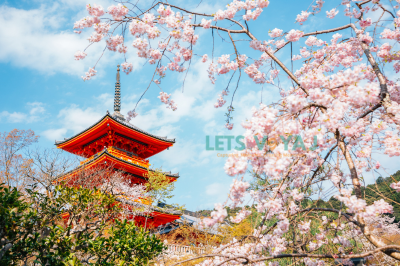
Kyoto served as Japan’s imperial capital for over 1,000 years, and this rich history has left the city with an unparalleled cultural legacy. Unlike many Japanese cities that were heavily bombed during World War II, Kyoto was largely spared, preserving its architectural and cultural treasures. Today, the city offers visitors an extraordinary glimpse into traditional Japan through its 1,600+ Buddhist temples, 400+ Shinto shrines, imperial palaces, gardens, and traditional wooden machiya townhouses.
Fushimi Inari Taisha Shrine
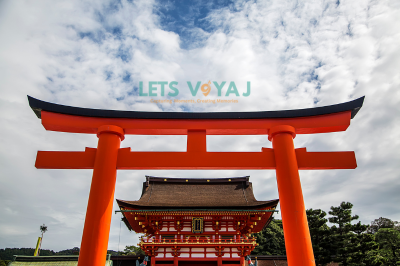
Consistently ranked among the best places to visit in Japan, Fushimi Inari Shrine stands as one of the country’s most iconic and frequently photographed cultural sites. This remarkable shrine, dedicated to Inari, the Shinto god of rice, has earned its reputation as one of the best places to visit in Japan through its most distinctive feature—the seemingly endless path of thousands of vermilion torii gates that wind majestically up the slopes of Mount Inari.
What makes this experience particularly meaningful is that each gate represents a personal connection to the shrine’s spiritual purpose; individuals and businesses seeking prosperity have donated these gates throughout history, with each donor’s name carefully inscribed on their contribution, creating a vivid physical manifestation of Japanese spiritual and commercial traditions that continues to evolve to this day.
The full hike through all the gates to the summit takes approximately 2-3 hours round trip, but even a shorter walk provides a magical experience. Along the route, you’ll encounter smaller shrines, fox statues (believed to be Inari’s messengers), and beautiful viewpoints overlooking Kyoto. The shrine complex is particularly atmospheric in the early morning or evening when crowds thin out and light filters beautifully through the gates.
Basic Information
Full Name: Fushimi Inari Taisha (伏見稲荷大社)
Address: 68 Fukakusa Yabunouchicho, Fushimi Ward, Kyoto, 612-0882, Japan
Opening Hours: Open 24 hours, every day of the year
Official Website:http://inari.jp/
Phone Number: +81 75-641-7331
Getting There By Train
Fushimi Inari Shrine is easily accessible by train, with two stations located very close to the shrine entrance:
JR Line
- Take the JR Nara Line to Inari Station (稲荷駅)
- The shrine’s main entrance is just a 2-minute walk from this station
- This is the most convenient option if you’re coming from Kyoto Station (about 5 minutes, ¥140)
Keihan Line
- Take the Keihan Main Line to Fushimi Inari Station (伏見稲荷駅)
- The shrine is approximately a 5-minute walk from this station
- This is a good option if you’re coming from downtown Kyoto areas like Gion
Getting There By Bus
- From Kyoto Station, you can take Kyoto City Bus #5 or #105
- Get off at Inari Taisha-mae bus stop
- The journey takes approximately 20-30 minutes depending on traffic
Getting There By Taxi
- Taxis are readily available throughout Kyoto
- From Kyoto Station, the ride takes approximately 15 minutes and costs around ¥1,500-2,000
- You can simply tell the driver “Fushimi Inari” or “Inari Taisha” (稲荷大社)
Parking Information
If you’re driving to Fushimi Inari Taisha, there are several parking options:
- Official Shrine Parking Lot:
- Located near the main entrance
- Fee: ¥500 for the first hour, ¥300 for each additional hour
- Limited spaces (approximately 100 cars)
- Can fill up quickly during peak tourist seasons
- Nearby Paid Parking Lots:
- Several private parking lots within 5-10 minutes walking distance
- Prices range from ¥500-1,000 per hour
- Some offer flat day rates of ¥1,000-1,500
Transportation Companies Serving the Area
- JR (Japan Railways): Operates the Nara Line to Inari Station
- Keihan Railway: Operates the Keihan Main Line to Fushimi Inari Station
- Kyoto City Bus: Operates routes #5 and #105
- MK Taxi: One of the major taxi companies in Kyoto (+81 75-778-4141)
- Yasaka Taxi: Another prominent taxi company (+81 75-841-9141)
Nearby Attractions
- Tofukuji Temple (東福寺)
- Famous Zen temple known for autumn colors
- 15-minute walk from Fushimi Inari
- Accessible via JR Nara Line (Tofukuji Station)
- Fushimi Sake District
- Historic sake brewing area with tours and tastings
- 20-minute walk or short train ride on Keihan Line
- Famous breweries include Gekkeikan and Kizakura
- Toji Temple (東寺)
- UNESCO World Heritage site with Japan’s tallest pagoda
- 10 minutes by train from Inari Station to Toji Station
- Sanjusangendo Temple (三十三間堂)
- Famous for its 1,001 statues of Kannon
- About 25 minutes by bus or 10 minutes by taxi
- Kyoto National Museum
- Major art and historical artifacts collection
- 20-minute walk from Fushimi Inari
Official Websites
- Japan Railways (JR): https://www.jreast.co.jp/e/ (JR East)
- Japan Rail Pass: https://www.japan-rail-pass.com/
- Tokyo Metro: https://www.tokyometro.jp/en/
- Osaka Metro: https://www.osakametro.co.jp/en/
- Keisei Electric Railway (Airport access): https://www.keisei.co.jp/keisei/tetudou/skyliner/us/
- Japan Bus Association: http://www.bus.or.jp/en/
- Ministry of Land, Infrastructure, Transport and Tourism: https://www.mlit.go.jp/en/
Kinkaku-ji (Golden Pavilion)
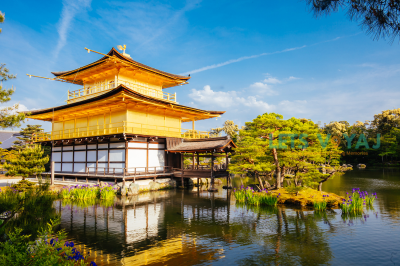
Kinkaku-ji, or the Golden Pavilion, consistently ranks among the best places to visit in Japan, captivating visitors with its breathtaking beauty and historical significance. Officially named Rokuon-ji, this Zen Buddhist temple stands as a testament to Japanese aesthetic principles and spiritual values. The structure, entirely covered in shimmering gold leaf, creates a mesmerizing reflection in the surrounding pond—a sight that epitomizes why it’s considered one of the best places to visit in Japan by travelers worldwide.
The pavilion’s fascinating history adds depth to its visual splendor. While the current structure was rebuilt in 1955 after a mentally disturbed monk tragically burned down the original 14th-century building, architects ensured it remained faithful to the original design, preserving its cultural importance. This dedication to historical authenticity contributes to its status among the best places to visit in Japan for those seeking to understand Japanese architectural heritage.
What makes the pavilion architecturally remarkable is its three distinct floors, each representing different Japanese architectural traditions: the ground floor embodies the elegant Shinden palace style, the second floor reflects the more austere samurai warrior residence style, and the top floor exemplifies the refined Zen temple style. This progression creates a visual journey through Japanese architectural history.
The meticulously designed surrounding garden further enhances the visitor experience. Following classical Japanese garden design principles, the carefully positioned stones, pruned trees, and reflective pond work in harmony to frame the pavilion, which appears to float ethereally on the water’s surface. While visitors cannot enter the pavilion itself, the thoughtfully designed pathway around the garden offers multiple vantage points to appreciate this architectural masterpiece from different angles and perspectives, helping visitors understand why Kinkaku-ji has become one of Japan’s most recognized and cherished cultural treasures.
Basic Information
Full Name: Kinkaku-ji (金閣寺), officially known as Rokuon-ji (鹿苑寺)
Address: 1 Kinkakujicho, Kita Ward, Kyoto, 603-8361, Japan
Opening Hours: 9:00 AM to 5:00 PM daily (last entry at 4:30 PM)
Entrance Fee: ¥500 for adults, ¥300 for elementary and junior high school students
Official Website:https://www.shokoku-ji.jp/kinkakuji/
Phone Number: +81 75-461-0013
Getting There By Bus
From Kyoto Station:
- Take Kyoto City Bus #205 directly to Kinkaku-ji Mae (金閣寺前) bus stop
- The journey takes approximately 40-50 minutes depending on traffic conditions
- Bus fare is ¥230 one-way (consider a one-day bus pass for ¥700 if making multiple trips)
- Buses run approximately every 10-15 minutes during daytime hours
From Downtown Kyoto (Shijo-Kawaramachi area):
- Take Kyoto City Bus #12, #102, or #204 to Kinkaku-ji Mae
- Journey time is about 30-35 minutes
- Same fare as above (¥230)
From Kyoto Imperial Palace area:
- Take Kyoto City Bus #12 or #102 to Kinkaku-ji Mae
- Journey time is approximately 15-20 minutes
Getting There By Taxi
Taxi companies serving Kyoto include:
- MK Taxi: +81 75-778-4141
- Yasaka Taxi: +81 75-841-9141
- Kyoto Taxi: +81 75-801-7771
Parking Information
If you’re driving to Kinkaku-ji, it’s important to know that parking can be limited, especially during peak tourist seasons:
- Official Temple Parking Lot:
- Located adjacent to the temple entrance
- Capacity: approximately 80 vehicles
- Fee: ¥1,000 for the first hour, additional time charged at ¥300 per hour
- Typically opens at 8:30 AM and closes at 5:30 PM
- Nearby Paid Parking Lots:
- Several private parking lots within 5-10 minutes walking distance
- Fees range from ¥500-800 per hour
- Some offer flat rates of ¥1,500-2,000 for the day
- The “Times Parking” chain operates several lots in the vicinity
Nearby Attractions
Kinkaku-ji is located in an area with several other significant temples and attractions, making it possible to visit multiple sites in a single day:
- Ryoan-ji Temple (龍安寺):
- Famous rock garden temple with 15 stones arranged in a way that you can never see all 15 at once
- About 20-minute walk or 5-minute bus ride (Bus #59)
- Features Japan’s most famous Zen rock garden
- UNESCO World Heritage site
- Entrance fee: ¥500
- Ninna-ji Temple (仁和寺):
- UNESCO World Heritage site
- About 15-minute walk or 5-minute bus ride (Bus #59)
- Known for its beautiful garden and five-story pagoda
- Former residence of the imperial family
- Famous for late-blooming cherry trees called Omuro cherries
- Entrance fee: ¥500
- Kitano Tenmangu Shrine (北野天満宮):
- Important Shinto shrine dedicated to the deity of learning
- About 20-minute walk or 10-minute bus ride
- Famous for its monthly flea market (25th of each month) and plum blossoms in February-March
- Entrance to the main shrine is free (garden has a separate fee)
- Daitoku-ji Temple Complex (大徳寺):
- Major Zen temple complex with multiple sub-temples
- About 25-minute walk or 10-minute bus ride
- Known for its beautiful Zen gardens
- Some sub-temples require advance reservations
- Various entrance fees for different sub-temples (typically ¥400-600 each)
- Kyoto Botanical Garden (京都府立植物園):
- Japan’s oldest botanical garden
- About 25-minute bus ride
- Features over 12,000 plant species
- Greenhouse with tropical plants
Arashiyama Bamboo Grove and Surrounding Area
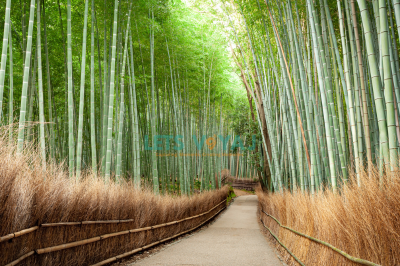
Among the best places to visit in Japan, the Arashiyama district stands out for its collection of attractions nestled within a setting of extraordinary natural beauty. The renowned bamboo grove features majestic stalks of bamboo that create an almost otherworldly atmosphere as sunlight gently filters through the densely packed grove.
This remarkable location, consistently ranked among the best places to visit in Japan by international travelers, offers more than just visual splendor—the gentle rustling of bamboo leaves in the wind produces such a distinctive and meditative sound that it has been officially recognized as one of Japan’s “100 Soundscapes,” making it a multisensory experience that captures the essence of traditional Japanese appreciation for nature.
Beyond the bamboo grove, Arashiyama contains several other important sites: Tenryū-ji Temple (a UNESCO World Heritage site with a spectacular garden), the Iwatayama Monkey Park (home to around 120 Japanese macaques), and the scenic Togetsukyo Bridge spanning the Katsura River. Traditional boat rides on the river offer another perspective of the area’s natural beauty, especially during cherry blossom season or fall foliage.
Basic Information
Address: Saga Tenryuji Susukinobaba-cho, Ukyo Ward, Kyoto, 616-8385, Japan
Opening Hours: Open 24 hours, accessible year-round
Entrance Fee: Free admission
Contact Information: Kyoto City Tourism Association: +81 75-213-1717
Getting There By Train
- JR Line
- Take the JR Sagano/San-in Line to Saga-Arashiyama Station
- From Kyoto Station, the journey takes about 20 minutes (¥240)
- The Bamboo Grove is approximately a 10-15 minute walk from this station
- This is often the most convenient option if you’re using a Japan Rail Pass
- Hankyu Railway
- Take the Hankyu Arashiyama Line to Hankyu Arashiyama Station
- From central Kyoto (Kawaramachi/Karasuma), the journey takes about 25-30 minutes (¥240)
- The Bamboo Grove is approximately a 20-minute walk from this station
- This line is convenient if you’re coming from downtown Kyoto
- Keifuku Randen (Tram)
- Take the Keifuku Electric Railroad (Randen) to Arashiyama Station (the terminus)
- From central Kyoto, take the tram from Shijo-Omiya Station (about 25 minutes, ¥230)
- The Bamboo Grove is approximately a 15-minute walk from this station
- This charming vintage tram provides a nostalgic experience
Getting There By Bus
Kyoto City Bus provides several routes to Arashiyama:
From Kyoto Station:
- Take Kyoto City Bus #28 to Arashiyama/Sagano bus stop
- The journey takes approximately 45-60 minutes depending on traffic
- Bus fare is ¥230 one-way (or use a one-day bus pass for ¥700)
- The Bamboo Grove is about a 10-15 minute walk from the bus stop
From Downtown Kyoto:
- Take Kyoto City Bus #11 or #28 to Arashiyama/Sagano bus stop
- Journey time is about 30-45 minutes
- Same fare as above (¥230)
Getting There By Taxi
Taxi companies serving Kyoto include:
- MK Taxi: +81 75-778-4141 (English service available)
- Yasaka Taxi: +81 75-841-9141
- Kyoto Taxi: +81 75-801-7771
You can simply tell the driver “Arashiyama Bamboo Grove” or “Arashiyama Chikurin” (嵐山竹林). Many drivers will know exactly where to drop you off for the best access.
Scenic Train Option: Sagano Scenic Railway
For a more unique experience, you can take the Sagano Scenic Railway (also known as the “Romantic Train”):
- This sightseeing train runs along the Hozugawa River gorge between Saga-Arashiyama and Kameoka
- It doesn’t directly take you to the Bamboo Grove but adds a scenic element to your journey
- The train operates from March to December (closed in winter)
- Reservations are recommended, especially during autumn foliage season
- One-way trip costs ¥630
- From the Sagano Scenic Railway Torokko Saga Station, it’s about a 10-minute walk to the Bamboo Grove
Parking Information
If you’re driving to Arashiyama, there are several parking options:
- Arashiyama Tourism Association Parking:
- Located near the Togetsukyo Bridge
- Capacity: approximately 200 vehicles
- Fee: ¥1,000-1,500 for the day depending on season
- About a 10-15 minute walk to the Bamboo Grove
- JR Saga-Arashiyama Station Parking:
- Located near the JR station
- Capacity: approximately 50 vehicles
- Fee: ¥600 for the first hour, then ¥300 per additional hour
- Maximum daily rate: ¥1,800
- About a 10-minute walk to the Bamboo Grove
- Private Parking Lots:
- Several smaller lots scattered throughout Arashiyama
- Prices range from ¥200-400 per hour
- Some offer flat day rates of ¥1,500-2,000
Nearby Attractions
The Arashiyama area is filled with significant attractions, making it ideal for a full-day excursion:
- Tenryu-ji Temple (天龍寺):
- UNESCO World Heritage site
- Located at the entrance to the Bamboo Grove
- Famous for its stunning landscape garden and Zen architecture
- Entrance fee: ¥500 for garden only, ¥800 for full temple access
- Togetsukyo Bridge (渡月橋):
- Iconic symbol of Arashiyama
- About 10-minute walk from the Bamboo Grove
- Especially beautiful during cherry blossom and autumn foliage seasons
- Free to cross and photograph
- Okochi Sanso Villa (大河内山荘):
- Former home and garden of silent film star Denjiro Okochi
- Located at the far end of the Bamboo Grove
- Tranquil gardens with spectacular views over Kyoto
- Entrance fee: ¥1,000 (includes a tea and sweet)
- Iwatayama Monkey Park (嵐山モンキーパーク):
- Home to around 120 wild Japanese macaques
- 10-15 minute walk from the Bamboo Grove, across the Togetsukyo Bridge
- Requires a 20-minute uphill hike to reach
- Entrance fee: ¥550
- Arashiyama Boat Rental (嵐山の舟下り):
- Scenic boat rides along the Hozugawa River
- About 15-minute walk from the Bamboo Grove
- Traditional wooden boats available for rental
- Prices start from approximately ¥1,500 per person
- Kameyama Park (亀山公園):
- Peaceful park with walking trails and viewpoints
- Adjacent to the Bamboo Grove
- Free entry
- Excellent views of the Arashiyama mountains and Katsura River
- Jojakkoji Temple (常寂光寺):
- Hillside temple with beautiful autumn colors
- About 15-minute walk from the Bamboo Grove
- Features a five-story pagoda and spectacular city views
- Entrance fee: ¥500
Kiyomizu-dera Temple
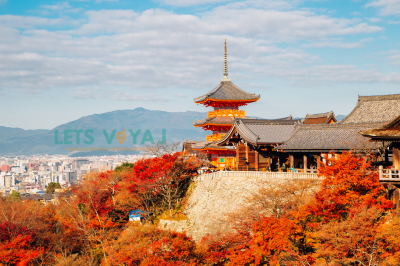
Perched on the wooded hillside of eastern Kyoto, Kiyomizu-dera is consistently ranked among the best places to visit in Japan, captivating visitors with its spectacular views of the city from its famous wooden stage—an engineering marvel constructed without using a single nail.
Founded in 778, this architectural treasure showcases why Kyoto contains so many of the best places to visit in Japan, as the temple’s main hall, reconstructed in 1633, has gracefully survived numerous fires and earthquakes throughout its storied history, offering travelers a profound connection to Japan’s cultural and spiritual heritage.
The temple is named after the pure water of the Otowa Waterfall that runs through the complex. Visitors can drink from three streams said to bring longevity, success in studies, or a fortunate love life (though drinking from all three is considered greedy). The approach to the temple through the steep and narrow lanes of the Higashiyama District adds to the experience, with traditional shops and tea houses lining the path. The area is particularly beautiful when illuminated during spring cherry blossom and fall foliage seasons.
Basic Information
Address: 1-294 Kiyomizu, Higashiyama Ward, Kyoto, 605-0862, Japan
Opening Hours:
- Generally open 6:00 AM to 6:00 PM
- Extended hours during special viewing seasons (cherry blossom, autumn leaves)
- May open until 9:00 PM during illumination events
Contact Information:
- Phone: +81 75-551-1234
- Website: https://www.kiyomizudera.or.jp/en/
Admission Fee:
- Adults: ¥400
- Children (elementary/junior high): ¥200
By Train and Bus (Most Common Method)
From Kyoto Station:
- Take Kyoto City Bus #100, #206, or #207 from Kyoto Station to “Kiyomizu-michi” or “Gojo-zaka” stop
- Travel time: approximately 15-20 minutes
- Bus fare: ¥230 (one-way)
- Walk uphill approximately 10-15 minutes to reach the temple
From Gion Area:
- Take Kyoto City Bus #206 or #207 to “Kiyomizu-michi” stop
- Walk uphill approximately 10 minutes
Nearest Train Stations:
- Kiyomizu-Gojo Station (Keihan Line): 20-minute walk
- Gion-Shijo Station (Keihan Line): 25-minute walk
- Kawaramachi Station (Hankyu Line): 25-minute walk
Parking Information
Parking is limited near Kiyomizu-dera due to its location in a historic district. Most visitors use public transportation.
Nearest Parking Options:
- Kiyomizu-dera Parking Lot
- Limited spaces (approximately 100)
- Fee: ¥1,500 for first 3 hours, ¥500 per hour thereafter
- Often full by mid-morning during peak seasons
- Gojo-zaka Parking Area
- Approximately 50 spaces
- Fee: ¥1,000 for first 2 hours, ¥500 per hour thereafter
- 5-minute walk to temple entrance
- Yasaka Parking Lot
- Larger capacity
- Fee: ¥600 per hour
- 15-20 minute walk to temple
Transportation Companies Serving the Area
Bus Companies:
- Kyoto City Bus (municipal service): Most comprehensive coverage
- Keihan Bus: Operates some routes in eastern Kyoto including Kiyomizu area
Tour Operators:
- JTB Tours: Offers guided bus tours including Kiyomizu-dera
- Sunrise Tours: English-language guided tours
- Kyoto Sightseeing Pass: Available for unlimited bus rides (¥600 for one-day pass)
Nearby Attractions
Within 15-minute walking distance:
- Yasaka Shrine
- Maruyama Park
- Kodai-ji Temple
- Ninenzaka and Sannenzaka (historic shopping streets)
- Gion District (geisha district)
- Otani Cemetery
- Yasaka Pagoda
- Higashiyama District (preserved historic area)
Nijo Castle

Among the best places to visit in Japan, Nijo Castle stands out for representing a different aspect of Kyoto’s rich heritage—the seat of military power rather than religious significance.
Built in 1603 as the Kyoto residence of Tokugawa Ieyasu, the first shogun of the Edo Period, this magnificent flatland castle offers visitors a glimpse into Japan’s feudal past that makes it one of the best places to visit in Japan for history enthusiasts.
The castle’s impressive architecture features two concentric rings of fortifications surrounding the elegant Ninomaru Palace, the historical ruins of the Honmaru Palace, and meticulously maintained traditional gardens that together illustrate the perfect balance of defensive strength and aesthetic refinement that characterized Japan’s shogunate era.
The Ninomaru Palace is famous for its “nightingale floors” – wooden floors that squeak when walked upon, designed as a security measure to alert residents of intruders. The palace’s rooms feature elaborate wood carvings and paintings by artists of the Kano school.
The interior showcases the opulence of shogunal power, while the surrounding gardens, designed by the famous landscape architect Kobori Enshu, demonstrate the refined aesthetic sensibilities of the era. In 1994, Nijo Castle was designated a UNESCO World Heritage Site as part of the “Historic Monuments of Ancient Kyoto.”
Basic Information
Address: 541 Nijojocho, Nakagyo Ward, Kyoto, 604-8301, Japan
Opening Hours:
- 8:45 AM to 5:00 PM (last entry at 4:00 PM)
- Closed on Tuesdays in January, July, August, and December
- Closed December 26-31 for the New Year holiday
- May have extended hours during special seasonal illumination events
Contact Information:
- Phone: +81 75-841-0096
- Website: https://nijo-jocastle.city.kyoto.lg.jp/en/
Admission Fees:
- Adults: ¥1,030
- High school and university students: ¥350
- Elementary and junior high school students: ¥200
- Additional fees may apply for special exhibitions
Transportation Options
By Train (Most Convenient)
The castle has excellent train access with two nearby stations:
Nijojo-mae Station (Subway Tozai Line)
- Located directly in front of the castle’s east entrance
- Just a 1-minute walk to the castle entrance
- Direct connections from Kyoto Station (approximately 15 minutes)
- Train fare from Kyoto Station: ¥260 one-way
Nijo Station (JR Sagano/San-in Line)
- Located about 500 meters southwest of the castle
- Approximately 7-8 minute walk to the castle entrance
- Direct access from Kyoto Station (approximately 10 minutes)
- Train fare from Kyoto Station: ¥150 one-way
By Bus
From Kyoto Station:
- Take Kyoto City Bus #9, #50, or #101 to “Nijojo-mae” bus stop
- Travel time: approximately 20-30 minutes (depending on traffic)
- Bus fare: ¥230 one-way
From Downtown Kyoto/Shijo Area:
- Take Kyoto City Bus #12 or #101 to “Nijojo-mae” bus stop
- Travel time: approximately 15 minutes
- Bus fare: ¥230 one-way
Parking Information
Unlike many historic sites in Kyoto, Nijo Castle has its own parking facilities, making it more accessible for those traveling by car.
Official Nijo Castle Parking Lot:
- Location: Adjacent to the east entrance
- Capacity: Approximately 110 cars
- Fee: ¥800 for the first hour, ¥200 for each additional 30 minutes
- Operation Hours: 8:30 AM to 5:30 PM
Alternative Parking Options:
- Nijo Castle East Parking Lot (Private)
- Approximately 50 spaces
- Fee: ¥600 per hour
- Located across from the east entrance
- Nijo Station Parking Area
- Approximately 70 spaces
- Fee: ¥500 per hour
- 7-8 minute walk to castle entrance
- Coin parking lots near Karasuma Oike
- Various small lots with hourly rates from ¥300-600
- 10-15 minute walk to castle entrance
Transportation Passes:
- Kyoto City Bus One-Day Pass: ¥600 (unlimited bus rides)
- Kyoto Subway & Bus One-Day Pass: ¥900 (unlimited subway and bus rides)
- Kyoto Sightseeing Pass: Various options available at tourist information centers
Nearby Attractions
Within a 15-20 minute walking radius:
- Kyoto Imperial Palace and Gardens (15-minute walk northeast)
- Kyoto International Manga Museum (10-minute walk south)
- Gokonomiya Shrine (10-minute walk west)
- Shinsen-en Garden (7-minute walk southeast)
- Rokkaku-do Temple (15-minute walk southeast)
- Central Kyoto shopping district around Karasuma/Shijo (15-minute walk south)
Higashiyama District
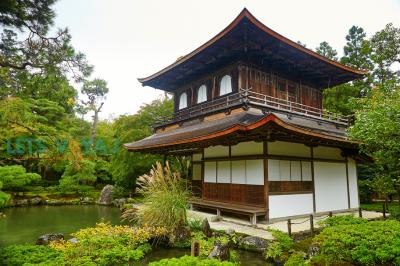
The Higashiyama District is one of the best places to visit in Japan for those seeking to experience the country’s traditional charm. This beautifully preserved historic neighborhood stretches from Kiyomizu-dera Temple in the south to Yasaka Shrine in the north. Narrow stone-paved lanes wind past traditional wooden buildings that house shops, cafés, and restaurants—many of which have been serving pilgrims and travelers for centuries.
Walking through Higashiyama feels like stepping back in time, especially when visitors wear rental kimonos that enhance the nostalgic atmosphere. In addition to Kiyomizu-dera, the district is home to important sites like Kodai-ji Temple and Yasaka Shrine.
The area’s machiya townhouses, with their narrow facades, latticed windows, and interior courtyards, showcase the elegance of traditional Japanese architecture. Higashiyama becomes especially magical during the Hanatoro illumination events held in March and December, making it a must-see highlight among Japan’s cultural treasures.
Basic Information
Location: Eastern Kyoto, along the lower slopes of the eastern mountains
General Area Boundaries:
- North: Ginkaku-ji (Silver Pavilion) area
- South: Kiyomizu-dera Temple area
- West: Kamogawa River (approximately)
- East: The eastern mountains of Kyoto
Main Areas within Higashiyama:
- Northern Higashiyama (Philosopher’s Path area, Ginkaku-ji)
- Central Higashiyama (Nanzen-ji, Heian Shrine area)
- Southern Higashiyama (Kiyomizu-dera, Yasaka Shrine, Gion)
Opening Hours:
As a district rather than a single attraction, different parts have different hours:
- Streets and public areas: Always accessible
- Shops: Typically 9:00 AM to 5:00-6:00 PM
- Temples and shrines: Usually 8:00/9:00 AM to 4:00/5:00 PM (varies by location)
- Restaurants: Lunch hours (11:00 AM-2:00 PM) and dinner hours (5:00 PM-9:00 PM)
Contact Information:
- Kyoto Tourist Information Center: +81 75-752-0227
- Kyoto City Tourism Association: +81 75-752-0227
Transportation Options
By Train and Subway
For Southern Higashiyama (Kiyomizu-dera/Gion area):
- Gion-Shijo Station (Keihan Line)
- Direct access to Gion district
- 5-10 minute walk to Hanamikoji and Shimbashi streets
- 20-25 minute walk uphill to Kiyomizu-dera
- Kiyomizu-Gojo Station (Keihan Line)
- 15-20 minute walk uphill to Kiyomizu-dera
- Good access to southern part of the district
For Central Higashiyama (Heian Shrine area):
- Higashiyama Station (Kyoto Subway Tozai Line)
- Directly adjacent to Heian Shrine
- 10-15 minute walk to Nanzen-ji Temple
For Northern Higashiyama (Philosopher’s Path):
- Keage Station (Kyoto Subway Tozai Line)
- 5-minute walk to southern end of the Philosopher’s Path
- Close to Nanzen-ji Temple
- No direct train access to Ginkaku-ji (Silver Pavilion) – requires bus or substantial walking
By Bus (Most Flexible Option)
Southern Higashiyama (Kiyomizu-dera/Gion area):
- Bus #100, #206 or #207 from Kyoto Station to “Kiyomizu-michi” or “Gojo-zaka” stops
- Bus #100 or #206 to “Gion” stop for Yasaka Shrine and Gion district
- Travel time from Kyoto Station: 20-30 minutes
- Fare: ¥230 one-way
Central Higashiyama (Heian Shrine area):
- Bus #5, #100 or #203 to “Heian Jingu-mae” stop
- Travel time from Kyoto Station: 30-40 minutes
- Fare: ¥230 one-way
Northern Higashiyama (Philosopher’s Path area):
- Bus #5, #17 or #100 to “Ginkakuji-michi” stop for Silver Pavilion
- Travel time from Kyoto Station: 40-50 minutes
- Fare: ¥230 one-way
Parking Information
Parking is extremely limited in the Higashiyama district due to its historic preservation status and narrow streets. Most visitors use public transportation.
Limited Parking Options:
For Southern Higashiyama:
- Kiyomizu-dera Parking Lot
- Limited spaces (approximately 100)
- Fee: ¥1,500 for first 3 hours
- Often full by mid-morning during peak seasons
- Yasaka Shrine Parking Area
- Approximately 50 spaces
- Fee: ¥1,000 for first 2 hours
- Good access to Gion and Yasaka areas
For Central/Northern Higashiyama:
- Heian Shrine Parking
- Limited spaces (approximately 70)
- Fee: ¥800 for first 2 hours
- Convenient for Heian Shrine but 15+ minute walk to other attractions
- Kyoto City Zoo Parking
- Larger capacity
- Fee: ¥1,600 per day
- 10-minute walk to Heian Shrine
For Northern Higashiyama:
- Ginkaku-ji Temple Parking
- Very limited spaces (approximately 30)
- Fee: ¥1,000 for 2 hours
- Almost always full during peak seasons
Key Attractions Within Higashiyama District
Southern Higashiyama:
- Kiyomizu-dera Temple
- Sannenzaka and Ninenzaka (historic preserved streets)
- Yasaka Shrine
- Kodai-ji Temple
- Maruyama Park
- Gion district (geisha district)
- Yasaka Pagoda
- Kennin-ji Temple (oldest Zen temple in Kyoto)
Central Higashiyama:
- Heian Shrine and Gardens
- Nanzen-ji Temple complex
- Kyoto City Zoo
- Kyoto Municipal Museum of Art
- Eikan-do Temple
- Shoren-in Temple
Northern Higashiyama:
- Ginkaku-ji (Silver Pavilion)
- Philosopher’s Path
- Honen-in Temple
- Anraku-ji Temple
- Reikan-ji Temple
Tokyo

Tokyo presents a fascinating blend of traditional Japanese culture and cutting-edge innovation. As one of the world’s most vibrant metropolises, the city rewards visitors with diverse experiences that showcase both Japan’s ancient heritage and its modern technological prowess. Let me guide you through the six most essential destinations that capture Tokyo’s multifaceted character.
Shinjuku

Shinjuku represents Tokyo at its most energetic and diverse, making it one of the best places to visit in Japan for travelers seeking authentic urban experiences. This district contains several distinct worlds within its boundaries. At its heart stands Shinjuku Station, the world’s busiest railway hub, handling over 3.5 million passengers daily through its labyrinthine corridors. The station serves as a gateway to numerous attractions.
East of the station, the neon-lit entertainment district of Kabukicho comes alive after dark with countless restaurants, bars, karaoke establishments, and the famous Robot Restaurant. This area embodies Tokyo’s reputation for sensory overload and technological spectacle, ranking it among the best places to visit in Japan for nightlife enthusiasts.
In stark contrast, just a short walk west of the station lies Shinjuku Gyoen National Garden, one of Tokyo’s most beautiful green spaces. This former imperial garden blends Japanese, English, and French landscaping styles across 144 acres, offering tranquil respite from urban intensity. The garden is particularly magnificent during cherry blossom season (late March to early April) and autumn foliage (late November to early December), making it one of the best places to visit in Japan for nature lovers.
The district also features the Tokyo Metropolitan Government Building, whose twin towers offer free observation decks with panoramic views of the city, including Mount Fuji on clear days. The surrounding skyscraper district houses luxury hotels, department stores, and corporate headquarters that form Tokyo’s distinctive skyline, completing Shinjuku’s status as one of the best places to visit in Japan.
Basic Information
Location: Shinjuku Ward (Shinjuku-ku) is one of Tokyo’s 23 special wards, located in the western part of central Tokyo.
Key Areas within Shinjuku:
- Shinjuku Station area – The world’s busiest railway station and surrounding commercial district
- East Shinjuku (Kabukicho, Golden Gai) – Entertainment and nightlife district
- West Shinjuku – Business district with skyscrapers and the Tokyo Metropolitan Government Building
- Southern Shinjuku (Yoyogi, Takadanobaba) – More residential areas with universities
- Shin-Okubo – Tokyo’s Koreatown neighborhood
General Information Contact:
- Shinjuku Tourist Information Center: +81 3-3344-3160
- Tokyo Tourist Information Center (in Shinjuku): +81 3-5321-3077
- Located inside the Tokyo Metropolitan Government Building
Transportation Options
By Train and Subway (Primary Method)
Shinjuku Station: This is the world’s busiest railway station, serving over 3.5 million passengers daily, with over 200 exits and more than a dozen different train and subway lines.
Major Lines Serving Shinjuku Station:
- JR Lines:
- JR Yamanote Line (Tokyo’s central loop line)
- JR Chuo Line (East-West through central Tokyo)
- JR Sobu Line (connects to eastern Tokyo)
- JR Saikyo Line (connects to Saitama and Yokohama)
- JR Shonan-Shinjuku Line (connects to Yokohama and Kamakura)
- Subway Lines:
- Tokyo Metro Marunouchi Line
- Tokyo Metro Fukutoshin Line
- Toei Shinjuku Line
- Toei Oedo Line
- Private Railways:
- Keio Line (western suburbs)
- Odakyu Line (southwestern suburbs, Hakone)
- Seibu-Shinjuku Line (northwestern suburbs)
Other Stations in Shinjuku Ward:
- Shin-Okubo Station (JR Yamanote Line) – Koreatown area
- Takadanobaba Station (JR Yamanote Line) – University district
- Yoyogi Station (JR Yamanote Line, JR Chuo Line) – Southern Shinjuku
- Okubo Station (JR Sobu Line) – Residential area
- Higashi-Shinjuku Station (Tokyo Metro Fukutoshin Line, Toei Oedo Line) – Eastern Shinjuku
From Tokyo’s Major Areas to Shinjuku:
- From Tokyo Station: 14 minutes via JR Chuo Line (¥200)
- From Shibuya: 7 minutes via JR Yamanote Line (¥160)
- From Ikebukuro: 8 minutes via JR Yamanote Line (¥160)
- From Ueno: 24 minutes via JR Yamanote Line (¥200)
- From Narita Airport: 80-90 minutes via Narita Express (¥3,250)
- From Haneda Airport: 45-55 minutes via Tokyo Monorail and JR Yamanote Line (¥650)
By Bus
Local City Buses:
- Toei Bus services operate throughout Shinjuku
- Bus terminals at the west and east exits of Shinjuku Station
- Fare: Typically ¥210 per ride
- Route maps available at the Shinjuku Bus Terminal
Highway Buses:
- Shinjuku Expressway Bus Terminal (Busta Shinjuku)
- Located above the South Exit of Shinjuku Station
- Connects to various cities across Japan
- Also serves airport limousine buses to Narita and Haneda
Airport Limousine Buses:
- To/from Narita Airport: 85-125 minutes (depending on traffic), ¥3,200
- To/from Haneda Airport: 35-75 minutes (depending on traffic), ¥1,300
- Depart from several major hotels in Shinjuku and the Shinjuku Expressway Bus Terminal
By Car
Driving in central Tokyo, including Shinjuku, is generally not recommended due to congestion and limited parking. However, if you must drive:
Major Roads Accessing Shinjuku:
- Metropolitan Expressway No. 4 (Shinjuku Line)
- Metropolitan Expressway Central Loop
- Koshu Kaido Avenue
- Meiji Dori Avenue
- Yasukuni Dori Avenue
Parking Information
Parking in Shinjuku is expensive and limited, but options are available:
Major Parking Facilities:
- Shinjuku Station West Exit Parking
- Capacity: Approximately 700 spaces
- Fee: ¥300-400 per 30 minutes
- Maximum daily rate: Approximately ¥3,000-4,000
- Located underneath the Shinjuku Sumitomo Building
- Tokyo Metropolitan Government Building Parking
- Capacity: Approximately 250 spaces
- Fee: ¥300 per 30 minutes
- Maximum daily rate: Approximately ¥3,000
- Convenient for visiting the Government Building observation decks
- Shinjuku Gyoen Parking
- Capacity: Approximately 70 spaces
- Fee: ¥500 per hour
- Limited hours (8:30 AM to 6:00 PM)
- Often full during cherry blossom season
- Department Store Parking:
- Isetan: Approximately 250 spaces, ¥400 per 30 minutes (partial validation with purchase)
- Takashimaya: Approximately 200 spaces, ¥400 per 30 minutes (partial validation with purchase)
- Lumine: Approximately 100 spaces, ¥400 per 30 minutes (partial validation with purchase)
- Coin Parking Lots:
- Numerous small coin parking lots scattered throughout Shinjuku
- Rates typically range from ¥300-600 per 30 minutes
- Many use automated systems with instructions only in Japanese
Key Attractions Within Shinjuku
West Shinjuku:
- Tokyo Metropolitan Government Building – Free observation decks on the 45th floor
- Shinjuku Central Park
- Skyscraper District (Sompo Japan Building, Mode Gakuen Cocoon Tower, etc.)
- Tokyo Opera City
East Shinjuku:
- Kabukicho (entertainment district)
- Golden Gai (historic alleyways with tiny bars)
- Shinjuku Gyoen National Garden
- Hanazono Shrine
- Robot Restaurant (tourist attraction with robot performances)
- Omoide Yokocho (Memory Lane/Piss Alley – traditional food alley)
Southern Shinjuku:
- Yoyogi Park
- Meiji Shrine (adjacent to Shinjuku Ward)
- Takashimaya Times Square
- Southern Terrace shopping area
Northern Shinjuku:
- Shin-Okubo (Koreatown)
- Okubo (multicultural district)
Transportation Companies Serving Shinjuku
Railway Companies:
- JR East (Japan Railways) – Yamanote, Chuo, Sobu, Saikyo, Shonan-Shinjuku lines
- Tokyo Metro – Marunouchi, Fukutoshin lines
- Toei Subway – Shinjuku, Oedo lines
- Keio Corporation – Keio Line, Keio New Line
- Odakyu Electric Railway – Odakyu Line
- Seibu Railway – Seibu-Shinjuku Line
Bus Companies:
- Toei Bus (Tokyo Metropolitan Government)
- Keio Bus
- Airport Limousine (Airport Transportation Service)
- JR Bus Kanto
- WILLER EXPRESS (highway buses)
Taxi Companies:
- Nihon Kotsu: +81 3-5755-2336
- Tokyo Hinomaru: +81 3-3361-8291
- Green Cab: +81 3-3982-2255
- Japan Taxi app: Available for smartphone booking
Transportation Passes:
- Tokyo Subway Ticket: 24/48/72-hour unlimited subway rides (¥800/1,200/1,500)
- Tokyo Free Kippu: One-day unlimited travel on JR, subway, and buses in central Tokyo (¥1,600)
- JR Pass: For tourists; unlimited JR travel (including Shinjuku) for 7/14/21 days
- PASMO or Suica: Rechargeable IC cards for convenient travel on all transport systems
Asakusa and Senso-ji Temple
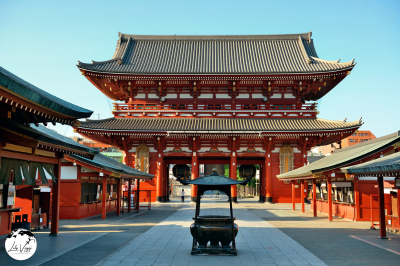
Asakusa offers the most accessible glimpse into Tokyo’s pre-modern past. The district centers around Senso-ji, Tokyo’s oldest and most significant Buddhist temple, founded in 628 CE. Visitors enter through the imposing Kaminarimon (“Thunder Gate”), with its massive red lantern, and proceed along Nakamise Shopping Street—a centuries-old market stretching 250 meters to the temple’s main hall.
The approach to Senso-ji immerses visitors in traditional Japanese architecture, with the five-story pagoda and main hall showcasing classical design elements. The temple grounds contain numerous smaller shrines, gardens, and statues that reveal aspects of Japanese Buddhist tradition. Visitors can participate in rituals like drawing omikuji (fortune papers) and wafting incense smoke toward ailments to promote healing.
The surrounding Asakusa district preserves a more relaxed, old-fashioned atmosphere than other parts of Tokyo. Traditional craft shops, restaurants serving classic Tokyo cuisine, and rickshaw drivers offering tours contribute to the historical ambiance. This area brilliantly illustrates how Tokyo maintains connections to its past amidst rapid modernization.
From the nearby Sumida River, visitors can board water buses for scenic cruises with views of the Tokyo Skytree, providing a memorable perspective on the city’s evolution from feudal center to global metropolis.
Basic Information
Senso-ji Temple Address: 2-3-1 Asakusa, Taito City, Tokyo 111-0032, Japan
Opening Hours:
- Temple Grounds: Open 24 hours
- Main Hall: 6:00 AM to 5:00 PM (October to March) 6:00 AM to 6:00 PM (April to September)
- Nakamise Shopping Street: Most shops open 9:00 AM to 6:00 PM
Contact Information:
- Phone: +81 3-3842-0181
- Website: https://www.senso-ji.jp/english/
Admission Fee:
- Temple Grounds and Main Hall: Free
- Asakusa Shrine: Free
- Nakamise Shopping Street: Free (shopping costs extra)
- Senso-ji Temple Garden (Demboin): ¥300 (limited seasonal opening)
Transportation Options
By Train and Subway (Most Convenient)
Asakusa is well-connected by Tokyo’s public transportation system, with multiple stations serving the area:
Asakusa Station (closest to Senso-ji Temple) Served by:
- Tokyo Metro Ginza Line
- Direct connections from Ueno (5 minutes)
- Direct connections from Ginza (15 minutes)
- Direct connections from Shibuya (30 minutes)
- Fare: ¥170-240 depending on starting point
- Toei Asakusa Line
- Direct connections from Shimbashi (15 minutes)
- Direct connections from Shinagawa (22 minutes)
- Fare: ¥170-270 depending on starting point
- Tobu Skytree Line (formerly Tobu Isesaki Line)
- Direct connections to/from Nikko and Kinugawa Onsen
- Direct connections to Tokyo Skytree (2 minutes)
- Fare within Tokyo: ¥150-300 depending on starting point
Nearby Alternative Stations:
- Tawaramachi Station (Tokyo Metro Ginza Line): 10-minute walk to Senso-ji
- Asakusa Station (Tsukuba Express): 8-minute walk to Senso-ji
- Kuramae Station (Toei Asakusa Line and Oedo Line): 15-minute walk to Senso-ji
By Bus
Tokyo City Bus:
- Route patterns vary, but several Toei Bus routes serve Asakusa
- Look for buses heading to “Asakusa” or “Taito”
- Standard fare: ¥210 (within 23 wards of Tokyo)
- Nearest bus stops: “Asakusa-eki-mae” or “Kaminarimon”
Sightseeing Buses:
- Tokyo Sky Hop Bus: Hop-on, hop-off sightseeing bus with Asakusa stops
- Fare: One-day pass ¥3,000-4,000
- Operates: 9:00 AM to 7:00 PM (frequency varies)
Water Bus:
- Tokyo Cruise Ship operates water bus services on the Sumida River
- Connects Asakusa with Odaiba, Hinode Pier, and Hamarikyu Gardens
- Departure point: Asakusa Pier (5-minute walk from Senso-ji)
- Fare: ¥680-1,560 depending on destination
- Operating hours: 10:00 AM to 5:00 PM (varies by season)
Parking Information
Parking near Senso-ji Temple is limited and expensive. It’s generally recommended to use public transportation, but if you must drive:
Nearest Parking Options:
- Asakusa Public Parking
- Location: 2-7 Asakusa, Taito City
- Capacity: Approximately 100 vehicles
- Fee: ¥400-500 per hour
- 5-minute walk to Senso-ji Temple
- Often full during weekends and holidays
- Asakusa ROX Parking
- Location: Inside ROX shopping complex
- Capacity: Approximately 300 vehicles
- Fee: ¥300 per 30 minutes (discounted rate with shopping)
- 8-minute walk to Senso-ji Temple
- Ekimae Parking Asakusa
- Location: 1-chome, Asakusa, near the station
- Capacity: Approximately 60 vehicles
- Fee: ¥400 per 30 minutes
- 3-minute walk to Senso-ji Temple
- Small spaces, not suitable for large vehicles
- Taito Ryokan Parking
- Location: 2-3 Kaminarimon, Taito City
- Capacity: Approximately 50 vehicles
- Fee: ¥300 per 30 minutes
- 5-minute walk to Senso-ji Temple
Nearby Attractions
Within walking distance of Senso-ji Temple:
- Asakusa Shrine (adjacent to Senso-ji)
- Shinto shrine built in 1649
- Hosts the famous Sanja Matsuri festival in May
- Nakamise Shopping Street
- 250-meter traditional shopping street leading to Senso-ji
- Over 50 shops selling traditional crafts, snacks, and souvenirs
- Asakusa Culture Tourist Information Center
- Modern building with free observation deck
- Excellent views of Senso-ji and surrounding area
- Information services and cultural exhibits
- Sumida Park
- Riverside park with cherry blossoms in spring
- Great views of Tokyo Skytree and Asahi Beer Hall
- Starting point for river cruises
- Hanayashiki Amusement Park
- Japan’s oldest amusement park (opened 1853)
- Retro attractions and rides
- 5-minute walk from Senso-ji
- Kappabashi Street (Kitchenware Street)
- Famous for restaurant supply shops
- 15-minute walk from Senso-ji
- Tokyo Skytree
- Japan’s tallest structure (634m)
- Shopping, restaurants, and observations decks
- 20-minute walk or 2-minute train ride from Asakusa
- Sumida Hokusai Museum
- Museum dedicated to the ukiyo-e artist Hokusai
- 15-minute walk from Senso-ji
- Sumida River Cruise
- Boat tours departing from Asakusa Pier
- Routes to Odaiba, Hinode, and Hamarikyu Gardens
- Asahi Beer Tower
- Distinctive golden flame building
- Houses restaurants and bars
- 10-minute walk from Senso-ji
Shibuya

Shibuya represents Tokyo’s position at the forefront of global youth culture, fashion trends, and consumer technology. The district’s defining feature is Shibuya Crossing, the world’s busiest pedestrian intersection, where up to 3,000 people cross simultaneously during peak times. This “scramble crossing” has become an iconic image of contemporary Tokyo, featured in numerous films and photographs symbolizing urban Japan.
The Shibuya area serves as a living laboratory for emerging trends, with fashion boutiques, technology stores, and entertainment venues constantly introducing new products and concepts. Landmark department stores like Shibuya 109 function as barometers for Japanese fashion movements, while the recently developed Shibuya Stream and Shibuya Scramble Square offer cutting-edge shopping and dining experiences.
The district also features important cultural symbols like the Hachiko statue—a monument to a loyal dog that waited for its deceased owner for nine years, becoming a national symbol of loyalty. The newly redeveloped Miyashita Park combines urban green space with retail elements, exemplifying Tokyo’s innovative approaches to urban design.
For those interested in Japanese pop culture, Shibuya offers excellent opportunities to experience contemporary music, art, and animation through venues like Tower Records and numerous galleries displaying works by emerging artists.
Meiji Shrine and Harajuku
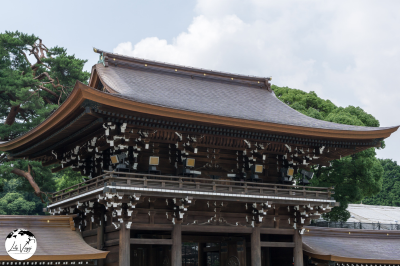
This fascinating area juxtaposes profound spiritual tradition with cutting-edge youth culture. Meiji Shrine, dedicated to Emperor Meiji and Empress Shoken, sits within a 170-acre evergreen forest that creates an astonishing oasis of tranquility in central Tokyo. The shrine complex, with its massive torii gates constructed of 1,500-year-old cypress wood, exemplifies classical Shinto architecture in its elegant simplicity.
Visitors follow wide gravel paths through the forest before reaching the main shrine buildings, where they can observe traditional Shinto rituals, write prayer requests on wooden tablets (ema), and—if fortunate—witness a traditional Japanese wedding procession. The Inner Garden features a classical Japanese landscape design, including the well where Emperor Meiji and Empress Shoken reportedly drew water.
In dramatic contrast, just steps from this serene sanctuary lies Takeshita Street, the epicenter of Harajuku youth fashion. This narrow pedestrian thoroughfare teems with teenagers shopping for cutting-edge fashion, sampling creative street foods like rainbow cotton candy and crepes, and expressing their individuality through distinctive style tribes. The surrounding streets contain both high-end international fashion boutiques and small independent designers, making the area a global fashion influence.
This remarkable juxtaposition illustrates Tokyo’s ability to maintain reverence for tradition while embracing youthful innovation—two complementary aspects of Japanese culture existing side by side.
Basic Information
Meiji Shrine
Address: 1-1 Yoyogi-Kamizonocho, Shibuya City, Tokyo 151-8557, Japan
Opening Hours:
- January to February: 6:30 AM to 5:00 PM
- March to April: 6:00 AM to 6:00 PM
- May to June: 5:30 AM to 6:30 PM
- July to August: 5:00 AM to 7:00 PM
- September to October: 5:30 AM to 6:30 PM
- November to December: 6:00 AM to 5:00 PM
- New Year’s Day (January 1): Open all night until evening of January 1
Contact Information:
- Phone: +81 3-3379-5511
- Website: https://www.meijijingu.or.jp/en/
Admission Fee:
- Shrine grounds: Free
- Inner Gardens (Meiji Jingu Gyoen): ¥500 for adults, ¥400 for seniors, free for children under 12
Harajuku District
Location: Harajuku is a neighborhood in Shibuya Ward, centered around Takeshita Street and the surrounding area
Opening Hours:
As a district rather than a single attraction, different areas operate at different times
- Takeshita Street shops: Generally 10:00 AM to 8:00 PM
- Larger department stores: 11:00 AM to 8:00 PM
- Cafes and restaurants: Various hours, many open from 10:00 AM to 10:00 PM
- Clubs and late-night venues: Some open until early morning
Transportation Options
By Train and Subway (Most Convenient)
The area is served by multiple stations, each with slightly different access points:
Harajuku Station (JR Yamanote Line)
- The most direct access to both Meiji Shrine and Harajuku
- Located directly between the shrine entrance and Takeshita Street
- Accessible via the JR Yamanote Line (Tokyo’s circular line)
- Connects to major Tokyo stations including Shibuya (1 stop), Shinjuku (2 stops), and Tokyo Station (13 stops)
Meiji-Jingumae Station (Tokyo Metro)
- Served by Tokyo Metro Chiyoda Line and Fukutoshin Line
- Located near the entrance to Takeshita Street
- Approximately 5-minute walk to Meiji Shrine entrance
- Connects to Shibuya, Shinjuku, and Ikebukuro without transfers on the Fukutoshin Line
Yoyogi Station (JR Lines)
- Served by JR Yamanote Line and JR Chuo-Sobu Line
- Located near the southwestern entrance to Meiji Shrine
- Approximately 10-minute walk to the shrine
- Convenient for those coming from western Tokyo
Sangubashi Station (Odakyu Line)
- Closest station to the Meiji Shrine’s northern entrance
- Approximately 10-minute walk to the shrine
- Connects to Shinjuku and western suburbs
From Major Tokyo Areas to Harajuku/Meiji Shrine:
- From Tokyo Station: 20 minutes via JR Yamanote Line (¥200)
- From Shinjuku: 7 minutes via JR Yamanote Line (¥160)
- From Shibuya: 3 minutes via JR Yamanote Line (¥150)
- From Ikebukuro: 13 minutes via JR Yamanote Line (¥190)
- From Narita Airport: 80 minutes via Narita Express to Shinjuku, then JR Yamanote Line (¥3,250)
- From Haneda Airport: 50 minutes via Tokyo Monorail to Hamamatsucho, then JR Yamanote Line (¥650)
By Bus
Tokyo City Bus:
- Several Toei Bus routes serve the area
- Bus stop “Jingu-mae” or “Meiji-Jingu-mae” is closest to the shrine entrance
Sightseeing Buses:
- Tokyo Sky Hop Bus (hop-on, hop-off service) stops at Harajuku
- Fare: One-day pass ¥3,000-4,000
- Operates: 9:00 AM to 7:00 PM (frequency varies)
Parking Information
Nearest Parking Options:
- Yoyogi Park Parking
- Location: Adjacent to Yoyogi Park, near the shrine
- Capacity: Approximately 230 vehicles
- Fee: ¥300 per hour
- Operating hours: 8:00 AM to 8:00 PM
- 5-minute walk to Meiji Shrine
- Takeshita Street Parking
- Location: Near Takeshita Street entrance
- Capacity: Approximately 50 vehicles
- Fee: ¥500 per 30 minutes
- Often full, especially on weekends
- Omotesando Hills Parking
- Location: Underneath Omotesando Hills shopping complex
- Capacity: Approximately 200 vehicles
- Fee: ¥400 per 30 minutes (partial validation with purchase)
- 10-minute walk to Meiji Shrine
- Laforet Harajuku Parking
- Location: Underneath Laforet Harajuku department store
- Capacity: Approximately 50 vehicles
- Fee: ¥500 per 30 minutes (partial validation with purchase)
- 5-minute walk to Takeshita Street
Nearby Attractions
Within walking distance of Meiji Shrine and Harajuku:
- Yoyogi Park
- Directly adjacent to Meiji Shrine
- Large public park with wide lawns and forested areas
- Popular for picnics, street performances, and seasonal events
- Takeshita Street
- Heart of Harajuku’s youth culture
- Narrow pedestrian street lined with trendy shops and cafes
- Famous for crepe stands, fashion boutiques, and kawaii culture
- 2-minute walk from Harajuku Station
- Omotesando Avenue
- Often called “Tokyo’s Champs-Élysées”
- Tree-lined boulevard with high-end fashion boutiques
- Notable for its striking architecture and designer stores
- 5-minute walk from Harajuku Station
- Omotesando Hills
- Upscale shopping complex designed by Tadao Ando
- Houses numerous luxury brand stores and restaurants
- 10-minute walk from Meiji Shrine
- Togo Shrine
- Small Shinto shrine dedicated to Admiral Togo
- Quiet counterpoint to the busy Meiji Shrine
- 7-minute walk from Harajuku Station
- Nezu Museum
- Houses a collection of Japanese and East Asian art
- Features a spectacular traditional garden
- 15-minute walk from Harajuku Station
- Ukiyo-e Ota Memorial Museum of Art
- Specializes in ukiyo-e woodblock prints
- Rotating exhibitions from a vast collection
- 10-minute walk from Harajuku Station
- Cat Street
- Pedestrian street connecting Harajuku and Shibuya
- Home to boutiques, cafes, and vintage shops
- 5-minute walk from Takeshita Street
- Laforet Harajuku
- Multi-level fashion department store
- Focuses on cutting-edge Japanese designers
- 3-minute walk from Harajuku Station
- Kiddy Land
- Multi-floor toy store with character merchandise
- Japanese and international toy brands
- 7-minute walk from Harajuku Station
Tokyo National Museum and Ueno Park
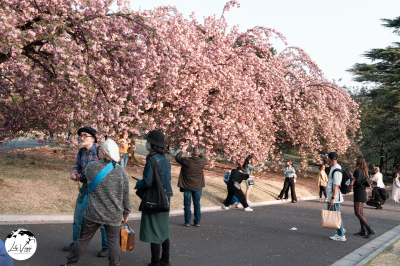
Ueno Park provides Tokyo’s most comprehensive cultural experience within a pleasant natural setting. The park’s centerpiece, Tokyo National Museum, houses the world’s largest collection of Japanese art and antiquities, spanning 12,000 years of history through over 110,000 items. The museum’s displays include National Treasures like the Jomon period “Venus” figurines, samurai armor, exquisite screen paintings, and ceramics that trace the development of Japanese aesthetic sensibilities.
Beyond the national museum, Ueno Park contains several other important institutions: the National Museum of Western Art (designed by Le Corbusier), the Tokyo Metropolitan Art Museum, the National Science Museum, and Japan’s oldest zoological garden. This concentration of cultural venues makes the area perfect for visitors seeking deeper understanding of Japanese art, history, and natural science.
The park itself offers natural beauty with its cherry tree-lined pathways (especially spectacular during spring blooming season), Shinobazu Pond with its lotus flowers, and the serene Toshogu Shrine. Established in 1873 as Japan’s first public park, Ueno represents the Meiji-era fusion of Western concepts with Japanese traditions that characterizes modern Tokyo.
The surrounding Ueno district provides opportunities to experience authentic Tokyo daily life through its traditional shopping streets, including the working-class marketplace of Ameyoko, where vendors sell everything from fresh seafood to discount clothing.
Basic Information
Tokyo National Museum
Full Name: Tokyo National Museum (東京国立博物館, Tōkyō Kokuritsu Hakubutsukan)Address: 13-9 Ueno Park, Taito City, Tokyo 110-8712, JapanOpening Hours:
- 9:30 AM to 5:00 PM (Tuesday to Sunday)
- Extended to 9:00 PM on Fridays and Saturdays (for special exhibitions)
- Closed on Mondays (or the following day if Monday is a national holiday) and during New Year holidays (December 26 to January 1)
- Last entry is 30 minutes before closing
Entrance Fees:
- General admission: ¥1,000 for adults, ¥500 for university students
- Special exhibitions have separate admission fees, typically ¥1,500-2,200
- Free for children and students through high school age
- Free for seniors over 70 with ID
Official Website: https://www.tnm.jp/modules/r_free_page/index.php?id=113
Phone Number: +81 3-3822-1111
Ueno Park
- Full Name: Ueno Park (上野公園, Ueno Kōen)
- Address: 5-20 Uenokoen, Taito City, Tokyo 110-0007, Japan
- Opening Hours: Open 24 hours, all year round
- Entrance Fee: Free to enter the park itself
- Official Website: https://www.tokyo-park.or.jp/park/format/index039.html
- Phone Number: +81 3-3828-5644 (Ueno Park Administration Office)
Getting There By Train
JR Lines
- JR Ueno Station is served by multiple JR lines:
- Yamanote Line (the loop line circling central Tokyo)
- Keihin-Tohoku Line
- Joban Line
- Takasaki Line
- Utsunomiya Line
- Tohoku Shinkansen (bullet train)
- Hokuriku Shinkansen
- Joetsu Shinkansen
- From JR Ueno Station, use the Park Exit or Shinobazu Exit
- The park entrance is directly across from the station, with the Tokyo National Museum about a 10-minute walk into the park
Tokyo Metro (Subway)
- Ueno Station on the Tokyo Metro:
- Ginza Line (G16)
- Hibiya Line (H17)
- From the subway station, follow signs for “Ueno Park” or “Tokyo National Museum”
- The park entrance is about a 3-minute walk from the exits
Keisei Line
- Keisei Ueno Station is convenient for travelers coming from Narita Airport
- Keisei Skyliner and Keisei Main Line trains stop here
- The park entrance is about a 5-minute walk from this station
Getting There By Bus
Several bus routes serve the Ueno area:
Toei Bus
- Routes 東43 (Higashi 43), 上46 (Uwa 46), and 学01 (Gaku 01) stop at “Ueno Station” or “Ueno Park”
- From Tokyo Station, take the Toei Bus 東43 (about 30 minutes, ¥210)
- Look for stops labeled “上野公園” (Ueno Park) or “東京国立博物館” (Tokyo National Museum)
Tokyo Metropolitan Expressway Bus
- Airport limousine buses from both Haneda and Narita airports stop at major hotels near Ueno Station
- These services provide direct connections for international travelers
Parking Information
Ueno Park Parking Areas
- Ueno Park Underground Parking:
- Located beneath the park near the fountain plaza
- Capacity: approximately 215 vehicles
- Fee: ¥400 for the first hour, ¥300 for each additional hour
- Maximum daily rate: ¥2,400
- Hours: 7:00 AM to 11:00 PM
- Tokyo National Museum Parking:
- Small parking area near the museum entrance
- Capacity: approximately 40 vehicles
- Fee: ¥500 for the first hour, ¥300 for each additional hour
- Often fills quickly, especially on weekends and holidays
Nearby Commercial Parking Lots
- Ueno Station Parking:
- Located near the Ueno Station
- Fee: ¥500-600 per hour
- Various capacity depending on specific lot
- Times Parking and Paraca:
- Multiple locations within 5-10 minutes walking distance
- Hourly rates typically range from ¥400-600
- Some offer special discount rates for museum visitors (ask at the museum information desk)
- Important Parking Notes:
- Parking in central Tokyo is expensive and limited
- Weekend and holiday periods often see parking lots fill up by late morning
- Consider arriving early (before 9:30 AM) to secure parking
- Have a backup plan in case primary parking options are full
Nearby Attractions
The area surrounding Ueno Park offers plenty of additional attractions worth exploring:
- Ameyoko Market:
- Bustling outdoor shopping street with over 400 shops
- Located between Ueno and Okachimachi stations
- Famous for street food, clothing, and specialty goods
- Approximately 5-minute walk from the park’s southern entrance
- Yanaka District:
- Historic neighborhood that survived WWII bombings
- Traditional wooden houses and numerous temples
- Yanaka Ginza shopping street with local specialties
- About a 15-20 minute walk from the northern side of Ueno Park
- National Museum of Nature and Science:
- Located within Ueno Park
- Extensive exhibits on natural history and scientific achievements
- Particularly popular with families and children
- Entrance fee: ¥630 for adults
- Ueno Zoo:
- Japan’s oldest zoo, established in 1882
- Home to over 3,000 animals including giant pandas
- Located within Ueno Park
- Entrance fee: ¥600 for adults
- Tokyo Metropolitan Art Museum:
- Located within Ueno Park
- Hosts various temporary exhibitions throughout the year
- Exhibition fees vary depending on the show
- National Museum of Western Art:
- Located within Ueno Park
- Designed by renowned architect Le Corbusier (UNESCO World Heritage site)
- Permanent collection of European art, primarily French Impressionism
- Entrance fee: ¥500 for the permanent collection
- Kappabashi Street:
- Famous “Kitchen Town” with shops selling restaurant supplies
- About a 20-minute walk from the southern end of Ueno Park
- Perfect for unique souvenirs like plastic food models, Japanese knives, and kitchenware
Tokyo Skytree

The Tokyo Skytree stands as the pinnacle of Japan’s engineering capabilities and offers the most comprehensive view of the sprawling Tokyo metropolis. Completed in 2012, this broadcasting tower reaches a height of 634 meters (2,080 feet), making it the tallest structure in Japan.
The tower’s design combines cutting-edge technology with traditional Japanese aesthetic principles. Its neo-futuristic form incorporates elements from Japanese pagoda architecture, particularly in its central “shinbashira” column, which employs seismic proofing techniques derived from traditional five-story pagodas. The tower’s primary color, a shade called “Skytree White,” was specifically developed to blend with the surrounding cityscape, while subtle blue lights illuminate it at night in a color scheme called “Iki” (stylish) blue.
Visitors ascend to the tower’s two observation decks in elevators that travel at 600 meters per minute. The lower deck at 350 meters features large glass panels offering 360-degree views of Tokyo and beyond, including Mount Fuji on clear days. The upper “Tembo Galleria” at 450 meters includes a sloping spiral ramp where visitors can experience the feeling of walking in the sky. A section of glass flooring allows the brave to look straight down to the ground below—an exhilarating experience that emphasizes the tower’s extraordinary height.
The tower’s base houses Tokyo Solamachi, a complex containing over 300 shops and restaurants, the Sumida Aquarium, and a planetarium. This combination of entertainment, dining, and shopping makes the Skytree area a comprehensive destination even beyond its primary attraction as an observation tower.
The Tokyo Skytree has rapidly established itself as one of the city’s most recognizable landmarks, symbolizing Japan’s technological advancement while providing context for understanding Tokyo’s vast urban landscape. From its observation decks, visitors gain a unique perspective on how the city has developed around natural features like rivers and man-made elements like transit hubs, offering insight into Tokyo’s complex urban planning and evolution.
Address and Contact Information
- Full Address: 1-1-2 Oshiage, Sumida City, Tokyo 131-0045, Japan
- Phone Number: +81-3-5302-3470 (Tokyo Skytree Information Center)
- Official Website: https://www.tokyo-skytree.jp/en/
- Email: info@tokyo-skytree.jp
Opening Hours
- Tokyo Skytree (Observation Decks): 10:00 AM – 9:00 PM (last entry at 8:00 PM)
- Tokyo Solamachi (Shopping Mall): 10:00 AM – 9:00 PM
- Restaurants: 11:00 AM – 11:00 PM (varies by establishment)
Note that opening hours may change during holidays, special events, or maintenance periods. It’s advisable to check the official website for the most current information before your visit.
Getting to Tokyo Skytree
By Train/Subway
Tokyo Skytree is directly accessible from two stations:
- Tokyo Skytree Station (Tobu Skytree Line)
- Direct access to Tokyo Skytree via the 4th floor walkway
- 2-minute walk to the main entrance
- Connects to Asakusa, Kita-Senju, and other areas in northeast Tokyo
- Oshiage (Skytree) Station (Multiple lines)
- Served by multiple subway lines:
- Toei Asakusa Line
- Tokyo Metro Hanzomon Line
- Keisei Oshiage Line
- Located directly beneath Tokyo Solamachi (the shopping complex at the base of Tokyo Skytree)
- Connected via B3 exit to Tokyo Skytree
- 3-minute walk to the main entrance
- Served by multiple subway lines:
By Bus
Several bus routes stop near Tokyo Skytree:
- Toei Bus
- Route 業10 (Gyō 10): Kinshichō Station ↔ Tokyo Skytree ↔ Ueno Station
- Route 墨38 (Sumi 38): Kinshichō Station ↔ Tokyo Skytree ↔ Ryōgoku Station
- Get off at “Tokyo Skytree-mae” bus stop
- Keisei Bus
- Route 向島01 (Mukōjima 01): Oshiage Station ↔ Tokyo Skytree ↔ Asakusa Station
- Get off at “Tokyo Skytree East Gate” bus stop
- Sky Bus Tokyo
- Offers special sightseeing tours that include Tokyo Skytree
- Departs from Tokyo Station and other major tourist spots
By Water Bus
The Tokyo Cruise Ship operates water bus services on the Sumida River:
- Board at Asakusa Pier
- Disembark at Tokyo Skytree Pier (Oshiage)
- 20-minute scenic cruise
- Services run approximately every 30-40 minutes between 10:00 AM and 5:00 PM
By Car
If you’re driving to Tokyo Skytree, there are several parking options:
- Tokyo Skytree Town Parking
- Located beneath the complex
- 650 parking spaces
- Open 24 hours
- Rates: ¥300/30 minutes (maximum ¥3,000/day)
- Height limit: 2.1 meters
- Sumida Parking
- Located 5-minute walk from Tokyo Skytree
- 200 parking spaces
- Rates: ¥200/30 minutes (maximum ¥2,400/day)
- Oshiage Parking Area
- Located 7-minute walk from Tokyo Skytree
- 300 parking spaces
- Rates: ¥250/30 minutes (maximum ¥2,500/day)
Note that parking fills up quickly, especially on weekends and holidays, so public transportation is often more convenient.
Nearby Attractions
Within walking distance of Tokyo Skytree:
- Sumida Aquarium (inside Tokyo Skytree Town)
- Located on the 5th and 6th floors of Tokyo Solamachi
- Features 350 species of marine life
- One of the largest open indoor tank displays in Japan
- Konica Minolta Planetarium (inside Tokyo Skytree Town)
- Located on the 7th floor of Tokyo Solamachi East Yard
- Features state-of-the-art projections and special shows
- Asahi Beer Headquarters
- 10-minute walk from Tokyo Skytree
- Famous for its distinctive golden “flame” architecture
- Sumida Park
- 10-minute walk from Tokyo Skytree
- Beautiful riverside park, especially popular during cherry blossom season
- Edo-Tokyo Museum
- 15-minute walk from Tokyo Skytree
- Comprehensive museum about Tokyo’s history
- Asakusa and Sensō-ji Temple
- 20-minute walk or one stop on the Tobu Skytree Line
- Historic temple and traditional shopping street (Nakamise)
Mount Fuji
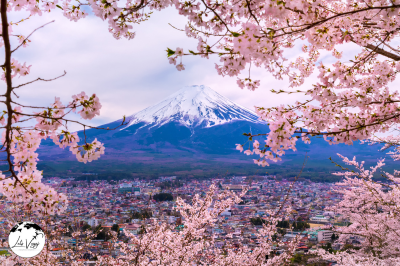
Mount Fuji (富士山, Fujisan) stands as Japan’s highest mountain at 3,776 meters (12,388 feet) and holds tremendous cultural and spiritual significance for the Japanese people. As the country’s most iconic natural landmark, this perfectly symmetrical volcanic cone has inspired artists, poets, and pilgrims for centuries.
Understanding Mount Fuji
Mount Fuji is an active stratovolcano that last erupted in 1707-1708. Despite its status as an active volcano, it’s considered at low risk of eruption and is monitored closely by geological authorities. The mountain straddles the boundary of Shizuoka and Yamanashi prefectures, about 100 kilometers southwest of Tokyo.
Fuji’s distinctive silhouette—with its nearly perfect conical shape—has made it not just a national symbol but a globally recognized image of Japan. In 2013, UNESCO recognized Mount Fuji as a World Cultural Heritage site, acknowledging its profound influence on Japanese culture, art, and spiritual practices.
Climbing Season and Access
The official climbing season runs from early July to early September. During this period, the mountain trails are free of snow, mountain huts are operational, and public transportation to the fifth stations (the starting points for climbs) is readily available. Climbing outside this season is extremely dangerous due to severe weather conditions and is strongly discouraged for all but the most experienced mountaineers.
There are four main trails to the summit:
- Yoshida Trail (most popular, from Yamanashi Prefecture)
- Subashiri Trail
- Gotemba Trail
- Fujinomiya Trail (shortest but steepest)
Most climbers begin their ascent from the fifth stations, which are accessible by bus or car. The Kawaguchiko Fifth Station on the Yoshida Trail is the most developed and accessible from Tokyo.
Best Viewing Points
Mount Fuji is famous for being “shy”—often hiding behind clouds. For the best chances of a clear view:
- Lake Kawaguchiko – The most accessible of the Fuji Five Lakes, offering stunning reflections of the mountain on clear days. The north shore provides particularly good views.
- Chureito Pagoda – Perhaps the most iconic view of Fuji, this five-story pagoda framed with cherry blossoms in spring creates the quintessential Japanese landscape photograph.
- Lake Motosuko – The view from the northern shore is featured on the 1,000-yen note. Early morning offers the best chance of clear visibility.
- Hakone – The view from Ashinoko (Lake Ashi) with traditional red torii gates is particularly striking.
- Miho no Matsubara – A pine-lined beach offering a unique coastal view of Fuji, famously depicted in many classic woodblock prints.
- Mount Tenjo – Accessible via the Kachi Kachi Ropeway from Kawaguchiko, providing an elevated perspective.
- Fujiyoshida Sengen Shrine – The starting point of the traditional pilgrimage route, offering a spiritual perspective with the mountain framed by shrine architecture.
The best time of year for viewing is during winter (December to February) when the air is clearest, especially early mornings. Spring and autumn offer beautiful contrasts with cherry blossoms or autumn foliage, while summer often has more cloud cover.
Nearby Attractions
Fuji Five Lakes Region
- Lake Kawaguchiko – The most developed lake area with museums, hot springs, and recreational activities
- Fuji-Q Highland – A major amusement park with some of Japan’s most thrilling roller coasters
- Oshino Hakkai – A set of eight ponds fed by snowmelt from Mount Fuji, known for extraordinarily clear water
- Saiko Iyashi no Sato Nenba – A reconstructed traditional village showcasing thatched-roof houses and traditional crafts
Hakone Area
- Owakudani – An active volcanic valley with sulfurous vents and the famous black eggs cooked in the hot springs
- Hakone Open-Air Museum – An outdoor museum featuring contemporary sculpture set against mountain backdrops
- Hakone Shrine – A centuries-old Shinto shrine with distinctive red torii gates partly submerged in Lake Ashi
- Hakone Tozan Railway – A scenic mountain railway featuring switchbacks and spectacular forest views
Cultural Experiences
- Kubota Itchiku Art Museum – Showcasing stunning kimonos with Mount Fuji motifs
- Yamanashi Prefectural Museum – Exploring the geological and cultural history of the region
- Traditional Onsen – Numerous hot springs in the region offer relaxation with Mount Fuji views
Practical Tips for Visitors
When to Visit
- For climbing: July to early September
- For photography: Clear winter mornings or during spring cherry blossom season
- For avoiding crowds: Weekdays and outside Japanese holiday periods
Hiroshima
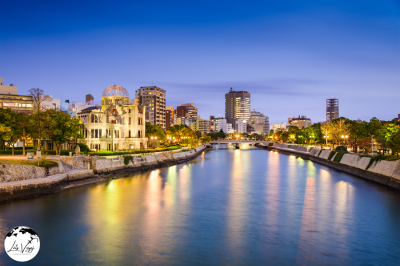
Hiroshima, located in western Japan’s Chugoku region, has transformed from a city devastated by atomic bombing in 1945 to a vibrant metropolitan center that thoughtfully balances its solemn historical legacy with forward-looking vitality. Today’s visitors find a city that offers profound historical lessons alongside natural beauty, culinary delights, and cultural treasures.
The Peace Memorial Park and Museum
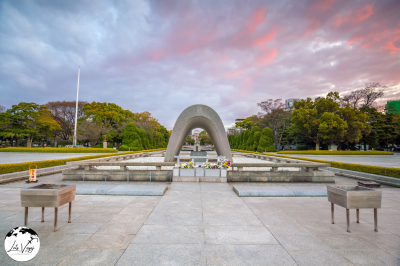
At the heart of Hiroshima’s identity lies the Peace Memorial Park, a space dedicated to the memory of bombing victims and to humanity’s hope for lasting peace. This expansive green space was once the bustling commercial and residential district at the hypocenter of the atomic blast.
The Atomic Bomb Dome (Genbaku Dome) stands as the most iconic structure in Hiroshima. This skeletal remnant of the former Prefectural Industrial Promotion Hall survived despite being almost directly beneath the explosion. UNESCO recognized it as a World Heritage Site in 1996 for its powerful testimony to the destructive forces humans have created.
The Peace Memorial Museum provides a comprehensive and deeply moving account of the bombing and its aftermath. Through photographs, artifacts, and personal testimonies, visitors gain insight into the human toll of nuclear warfare. The museum presents this difficult history not to assign blame but to educate about the imperative for nuclear disarmament.
Walking through the park, you’ll encounter numerous memorials, including the deeply affecting Children’s Peace Monument inspired by Sadako Sasaki, who folded paper cranes while hospitalized for radiation-induced leukemia. The Peace Bell, Cenotaph for Atomic Bomb Victims, and the Flame of Peace (designed to burn until all nuclear weapons are eliminated) create spaces for reflection and contemplation.
Address and Contact Information
- Full Address: 1-2 Nakajima-cho, Naka-ku, Hiroshima 730-0811, Japan
- Phone Number: +81-82-241-4004 (Hiroshima Peace Memorial Museum)
- Official Website: https://hpmmuseum.jp/?lang=eng
- Email: hpcf@pcf.city.hiroshima.jp
Opening Hours
- Peace Memorial Park: Open 24 hours (outdoor area)
- Peace Memorial Museum:
- 8:30 AM – 6:00 PM (March – July, September – November)
- 8:30 AM – 7:00 PM (August)
- 8:30 AM – 5:00 PM (December – February)
- Last entry: 30 minutes before closing
- Closed: December 30-31
- Cenotaph, A-Bomb Dome, and other outdoor monuments: Accessible 24 hours, illuminated at night
Getting to Hiroshima Peace Memorial Park
By Streetcar (Tram)
The most affordable and popular way to reach the Peace Park from Hiroshima Station:
- Lines and Routes:
- Line 2 (Hiroden): Headed for Miyajima-guchi
- Line 6 (Hiroden): Headed for Eba
- Stop Information:
- Board at Hiroshima Station tram stop (right outside the station)
- Get off at “Genbaku Dome-mae” (A-Bomb Dome) stop or “Hondori” stop
- Payment:
- Pay when exiting the tram
- IC cards (PASMO, Suica, ICOCA) accepted
- One-day streetcar passes available (¥700)
By Bus
Several bus routes connect Hiroshima Station to the Peace Park area:
- Hiroshima Bus:
- Route 24: Hiroshima Station → Peace Memorial Park
- Get off at “Heiwa-kinen-koen” (Peace Memorial Park) bus stop
- Travel time: Approximately 20 minutes
- Cost: ¥180-200 (depending on exact destination)
- Hiroshima Sightseeing Loop Bus “Meipuru-pu”:
- Dedicated tourist loop bus (orange buses)
- Stops at major attractions including Peace Memorial Park
- Departs from Hiroshima Station (south exit)
- Frequency: Every 30 minutes
- One-day pass: ¥400 (unlimited rides)
- Single ride: ¥200
By Water Bus (Seasonal)
During certain seasons, a water bus operates on the Motoyasu River
- Hiroshima World Heritage Cruise:
- Operates from Peace Memorial Park to Miyajima
- Travel time: Approximately 45 minutes (one-way)
- Cost: ¥2,000 (one-way), ¥3,600 (round-trip)
- Seasonal operation (primarily April-November)
- Departs from Motoyasu River Peace Memorial Park Pier
By Car
If driving to the Peace Memorial Park:
- GPS Navigation:
- Enter “Hiroshima Peace Memorial Park” or coordinates: 34.3955° N, 132.4536° E
- Parking Options:
-
- Peace Memorial Park Underground Parking
- Located directly beneath the Peace Memorial Park
- Capacity: 165 vehicles
- Hours: 7:00 AM – 10:00 PM
- Rate: ¥200 per 30 minutes (maximum ¥1,600/day)
- Heiwa Kinen Koen Parking Lot
- Located near the Peace Memorial Museum
- Capacity: 110 vehicles
- Hours: 8:00 AM – 10:00 PM
- Rate: ¥150 per 30 minutes (maximum ¥1,200/day)
- NTT Hiroshima Chuo Parking
- 5-minute walk from the Park
- Capacity: 200 vehicles
- Hours: 24 hours
- Rate: ¥200 per 30 minutes
- Hondori Shopping Area Parking
- Multiple facilities within 10-minute walk of the Park
- Rates vary (typically ¥200-300 per 30 minutes)
- Peace Memorial Park Underground Parking
Note that parking can be limited, especially during peak tourist seasons and on weekends.
Nearby Attractions
Within walking distance of the Peace Memorial Park:
- Hiroshima Castle (Hiroshima-jo)
- 15-minute walk from Peace Park
- Reconstructed historic castle with museum inside
- Beautiful grounds with cherry blossoms in spring
- Shukkei-en Garden
- 20-minute walk from Peace Park
- Traditional Japanese landscape garden dating back to 1620
- Tea houses and seasonal flowers
- Hiroshima Orizuru Tower
- 3-minute walk from A-Bomb Dome
- Observation deck with views of the city and Peace Park
- Interactive displays and paper crane folding activities
- Hondori Shopping Street
- 5-minute walk from Peace Park
- Covered shopping arcade with shops, restaurants, and cafes
- Local specialties and souvenirs
- Hiroshima Museum of Art
- 10-minute walk from Peace Park
- Collection of modern European and Japanese art
- Works by Picasso, Monet, Renoir, and others
- Hiroshima Prefectural Art Museum
- 15-minute walk from Peace Park
- Japanese and Asian art collections
- Regular special exhibitions
- Okonomimura
- 10-minute walk from Peace Park
- Food theme park featuring Hiroshima’s famous okonomiyaki (savory pancakes)
- Multiple small restaurants on several floors
Transportation Companies Serving the Area
- JR West (Japan Railways West)
- Operates Shinkansen and local trains to Hiroshima Station
- JR Pass valid on these services
- Hiroden (Hiroshima Electric Railway)
- Operates streetcar/tram network throughout Hiroshima
- Main provider of transport to Peace Memorial Park
- Hiroshima Bus Company
- Operates city buses and the Meipuru-pu sightseeing loop bus
- Bus services throughout Hiroshima and to surrounding areas
- Chugoku JR Bus
- Regional bus services throughout the wider Hiroshima prefecture
- Hiroshima Airport Limousine
- Direct bus services between Hiroshima Airport and downtown
- Aqua Net Hiroshima
- Operates water bus/ferry services on the Motoyasu River
- Seasonal services to Miyajima Island
- Hiroshima Taxi Association
- Multiple taxi companies operating throughout the city
- Available at ranks and by phone reservation
Hiroshima Castle
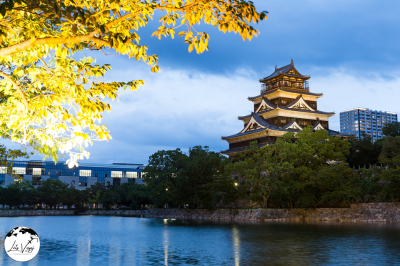
Originally built in the 1590s by the feudal lord Terumoto Mori, Hiroshima Castle was completely destroyed in the atomic bombing. The current structure, reconstructed in 1958, serves as a museum of Hiroshima’s pre-war history. From the top floor, visitors enjoy panoramic views of the surrounding city.
The castle grounds, planted with hundreds of cherry trees, transform into one of Hiroshima’s most popular hanami (cherry blossom viewing) spots each spring. The castle’s nickname, “Carp Castle” (Rijō), references the fish that have become symbols of the city and its beloved baseball team.
Address and Contact Information
- Full Address: 21-1 Motomachi, Naka-ku, Hiroshima 730-0011, Japan
- Phone Number: +81-82-221-7512
- Official Website: https://www.rijo-castle.jp/
- Email: info@rijo-castle.jp
Opening Hours
- Castle Grounds: Open 24 hours (accessible anytime)
- Castle Tower/Main Keep (Museum):
- 9:00 AM – 6:00 PM (March – November)
- 9:00 AM – 5:00 PM (December – February)
- Last entry: 30 minutes before closing
- Closed: December 29-31
- Ninomaru (Second Bailey):
- 9:00 AM – 6:00 PM (March – November)
- 9:00 AM – 5:00 PM (December – February)
Getting to Hiroshima Castle
From Hiroshima Station to Hiroshima Castle
By Streetcar (Tram)
- Lines and Routes:
- Line 1 (Hiroden): Headed for Hiroshima Port (Ujina)
- Line 2 (Hiroden): Headed for Miyajima-guchi
- Line 6 (Hiroden): Headed for Eba
- Stop Information:
- Board at Hiroshima Station tram stop (outside the station)
- Get off at “Kamiya-cho-nishi” or “Kamiya-cho-higashi” stop
- Walk approximately 10 minutes to the castle
By Sightseeing Loop Bus “Meipuru-pu”
This tourist-friendly loop bus is convenient for visiting multiple attractions:
- Orange Route:
- Departs from Hiroshima Station (south exit)
- Stops at “Hiroshima Castle” (dedicated stop)
- Travel time: Approximately 15 minutes from Hiroshima Station
- Frequency: Every 30 minutes
- One-day pass: ¥400 (unlimited rides)
- Single ride: ¥200
By City Bus
Regular city buses connect Hiroshima Station to the castle area:
- Hiroshima Bus:
- Routes 12, 13, or 21
- Get off at “Kamiya-cho” bus stop
- Walk approximately 10 minutes to the castle
By Car
If driving to Hiroshima Castle:
- GPS Navigation:
- Enter “Hiroshima Castle” or coordinates: 34.4026° N, 132.4590° E
- Parking Options:
- Hiroshima Castle Parking Lot
- Located within the castle grounds
- Capacity: 85 vehicles
- Hours: 7:00 AM – 11:00 PM
- Rate: ¥200 per hour (maximum ¥1,500/day)
- Motomachi Municipal Parking Lot
- Located 5-minute walk from the castle entrance
- Capacity: 125 vehicles
- Hours: 24 hours
- Rate: ¥170 per 30 minutes (maximum ¥1,700/day)
- NTT Hiroshima Chuo Parking
- 7-minute walk from the castle
- Capacity: 200 vehicles
- Hours: 24 hours
- Rate: ¥200 per 30 minutes
- Kamiya-cho Shareo Underground Parking
- 10-minute walk from the castle
- Capacity: 460 vehicles
- Hours: 7:00 AM – 11:00 PM
- Rate: ¥180 per 30 minutes (maximum ¥1,800/day)
- Hiroshima Castle Parking Lot
Nearby Attractions
Within walking distance of Hiroshima Castle:
- Hiroshima Peace Memorial Park and A-Bomb Dome
- 15-minute walk from the castle
- UNESCO World Heritage Site
- Museum and monuments dedicated to the atomic bombing
- Shukkei-en Garden
- 10-minute walk from the castle
- Traditional Japanese landscape garden dating back to 1620
- Tea houses and seasonal flowers
- Hiroshima Museum of Art
- 8-minute walk from the castle
- Collection of modern European and Japanese art
- Works by Picasso, Monet, Renoir, and others
- Hiroshima Prefectural Art Museum
- 5-minute walk from the castle
- Japanese and Asian art collections
- Regular special exhibitions
- Hiroshima Central Park (Chuo Koen)
- Adjacent to the castle grounds
- Popular cherry blossom viewing spot in spring
- Children’s playground and open spaces
- Kamiya-cho Shopping Area
- 10-minute walk from the castle
- Modern shopping area with department stores and boutiques
- Various restaurants and cafes
- Hondori Shopping Street
- 15-minute walk from the castle
- Covered shopping arcade with shops, restaurants, and cafes
- Local specialties and souvenirs
Shukkeien Garden
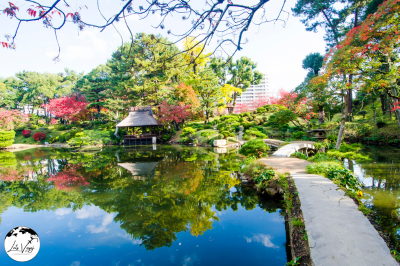
Just a short walk from Hiroshima Station lies Shukkeien, a traditional Japanese landscape garden whose name means “shrunken-scenery garden.” Created in 1620 for a local feudal lord, the garden employs careful landscaping techniques to reproduce miniature versions of natural formations—valleys, mountains, and forests—around a central pond.
The garden suffered extensive damage in 1945 but was meticulously restored. Today, it offers a tranquil counterpoint to urban life, with tea houses where visitors can pause for matcha and seasonal wagashi (traditional sweets) while contemplating the carefully composed vistas.
Miyajima Island
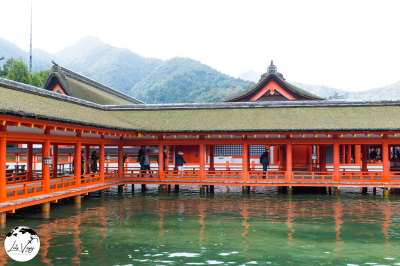
No visit to Hiroshima would be complete without a day trip to Miyajima (officially Itsukushima), an island in Hiroshima Bay considered one of Japan’s three most scenic views. The 45-minute journey includes a short ferry ride that builds anticipation for the island’s natural and cultural treasures.
The Itsukushima Shrine and its offshore “floating” torii gate create one of Japan’s most recognizable images. During high tide, the vermillion structures appear to float on water; at low tide, visitors can walk out to the base of the massive gate. The shrine complex, built over water on piers, dates back to the 12th century and exemplifies Heian-period shrine architecture.
Mount Misen, the island’s highest peak at 535 meters, can be ascended via ropeway or hiking trails. At the summit, panoramic views extend across the Seto Inland Sea, and a sacred flame—reportedly burning continuously since the 8th century—connects visitors to the spiritual traditions that have shaped this island sanctuary.
Address and Contact Information
- Official Name: Itsukushima (厳島), commonly known as Miyajima (宮島)
- Address: Miyajima-cho, Hatsukaichi City, Hiroshima Prefecture 739-0588, Japan
- Tourist Information Center Phone: +81-829-44-2011
- Email: miyajima-info@miyajima-wch.jp
Island Access Hours
- Island: Accessible 24 hours (inhabited island)
- Itsukushima Shrine:
- 6:30 AM – 6:00 PM (March – October)
- 6:30 AM – 5:30 PM (November – February)
- Last entry: 30 minutes before closing
- Mt. Misen Ropeway:
- 9:00 AM – 5:00 PM (extended during peak seasons)
- May close during adverse weather conditions
Getting to Miyajima Island
Visiting Miyajima requires a two-step journey: first to Miyajimaguchi (the mainland port), then a ferry crossing to the island itself.
Step 1: Reaching Miyajimaguchi Port
By Train from Hiroshima Station
- JR Sanyo Line (Local Train):
- Direct train from Hiroshima Station to Miyajimaguchi Station
- The station is a 5-minute walk to the ferry terminal
- JR Sanyo Shinkansen + JR Sanyo Line:
- Take Shinkansen to Iwakuni Station (if coming from west)
- Transfer to JR Sanyo Line to Miyajimaguchi Station
- Travel time: Varies based on connections
By Streetcar (Tram) from Hiroshima City
- Hiroden Streetcar Line 2:
- Board at Hiroshima Station or downtown Hiroshima
- Ride all the way to the terminus at Miyajimaguchi Station
By Direct Bus from Hiroshima
- Hiroshima Bus:
- Route 3-1: Hiroshima Bus Center → Miyajimaguchi
By Car to Miyajimaguchi
- Driving Directions:
- From Hiroshima City: Take Route 2 westbound
- Follow signs to Miyajimaguchi
- Travel time: Approximately 40 minutes from central Hiroshima
- Several parking options available (see “Parking Information” below)
Step 2: Ferry to Miyajima Island
After reaching Miyajimaguchi, you must take a ferry to cross to the island:
- JR Ferry:
- Departs from Miyajimaguchi Ferry Terminal
- Travel time: 10 minutes
- Cost: ¥190 (one way), covered by Japan Rail Pass
- Frequency: Every 15 minutes (first departure around 6:30 AM, last return around 10:30 PM)
- Matsudai Ferry:
- Operates from the same terminal as JR Ferry
- Travel time: 10 minutes
- Cost: ¥190 (one way), not covered by Japan Rail Pass
- Frequency: Every 15 minutes, alternating with JR Ferry
Direct Sea Routes to Miyajima
- World Heritage Sea Route:
- Direct high-speed boat from Hiroshima Peace Park to Miyajima
- Operated by Aqua Net Hiroshima
- Travel time: 45 minutes
- Cost: ¥2,200 (one way), ¥4,000 (round trip)
- Frequency: 1-5 departures daily (seasonal)
- Scenic route passing the A-Bomb Dome
- Miyajima-Kure-Etajima Ferry:
- Connects Miyajima with Kure City and Etajima Island
- Limited schedule (mostly weekends and holidays)
- Travel time: 60-90 minutes (depending on route)
- Cost: Varies by destination
Parking Information at Miyajimaguchi
As private vehicles are not permitted on Miyajima Island, visitors driving must park at Miyajimaguchi:
- Miyajimaguchi Ferry Terminal Parking:
- Official parking located directly next to the ferry terminal
- Capacity: 200 vehicles
- Cost: ¥300/hour, maximum ¥1,500/day
- Often fills up by mid-morning on weekends and holidays
- Operated by Hiroshima Prefecture
- JR Miyajimaguchi Station Parking:
- Next to the JR station
- Capacity: 120 vehicles
- Cost: ¥200/hour, maximum ¥1,200/day
- 5-minute walk to ferry terminal
- Miyajima Park & Ride Parking:
- Located approximately 1km from the ferry terminal
- Capacity: 500 vehicles
- Cost: ¥500/day (flat rate)
- Free shuttle bus to ferry terminal
- Recommended during peak seasons
- Private Parking Lots:
- Several private lots scattered around Miyajimaguchi area
- Cost: ¥100-200/hour, maximum ¥1,000-1,500/day
- Various distances from ferry terminal
Getting Around Miyajima Island
Once on the island, transportation options include:
- Walking:
- Most attractions are within walking distance
- The main shrine area is a 10-minute walk from the ferry terminal
- Flat, well-maintained paths along the waterfront
- Comfortable walking shoes recommended
- Mt. Misen Ropeway:
- Cable car service to Mt. Misen (island’s highest peak)
- Station is a 30-minute walk from the ferry terminal
- Operating hours: 9:00 AM – 5:00 PM (last ascent 4:30 PM)
- Cost: ¥1,800 (round trip), ¥1,000 (one way)
- Travel time: 20 minutes (including transfer between ropeways)
- Taxi:
- Limited service on the island
- Available primarily for elderly or disabled visitors
- Must be reserved in advance during off-peak seasons
Nearby Attractions on Miyajima Island
- Itsukushima Shrine:
- UNESCO World Heritage Site
- Famous “floating” torii gate in the sea
- Entrance fee: ¥300 adults, ¥150 children
- Main attraction on the island
- Daisho-in Temple:
- Important Shingon Buddhist temple
- 15-minute walk from the ferry terminal
- Free admission (donations appreciated)
- Beautiful statues and spiritual atmosphere
- Mt. Misen:
- Island’s highest peak (535m)
- Accessible by ropeway or hiking trails
- Primeval forest with rare flora and fauna
- Historic Buddhist halls and prayer sites
- Spectacular views of the Seto Inland Sea
- Miyajima History and Folklore Museum:
- Exhibits on island traditions and culture
- Entrance fee: ¥300
- Located near the shopping street
- Momijidani Park:
- Beautiful maple leaf valley
- Spectacular in autumn (November)
- Starting point for several hiking trails
- Free admission
- Machiya Street (Omotesando):
- Traditional shopping street
- Famous for Miyajima specialties
- Numerous souvenir shops and restaurants
- Historic architecture
- Five-Story Pagoda (Gojunoto):
- Built in 1407
- Visible from many parts of the island
- Particularly beautiful when illuminated at night
Nara
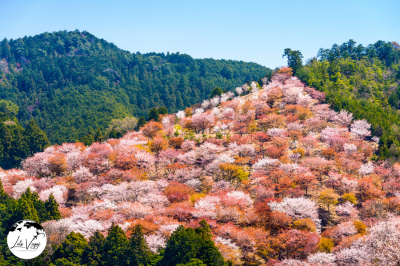
As Japan’s first permanent capital, Nara offers visitors a profound connection to the nation’s ancient roots. Established in 710 CE as Heijo-kyo before the seat of power moved to Kyoto, Nara preserves an extraordinary concentration of cultural treasures from this formative period in Japanese history. Unlike many Japanese cities that were heavily rebuilt after World War II, Nara retains much of its historical character, with eight UNESCO World Heritage sites packed into a relatively compact area.
Nara Park and Its Treasures
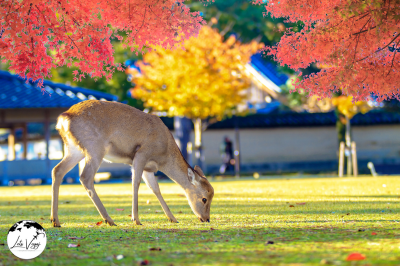
At the heart of Nara’s tourism appeal lies Nara Park (Nara Koen), a sprawling green space of approximately 660 hectares that houses several of Japan’s most significant historical sites. The park is famously home to over 1,200 wild sika deer that have lived in the area since ancient times and were considered divine messengers of the gods. Today, these approachable deer have become symbolic of Nara, freely roaming the park and interacting with visitors who can purchase special “shika senbei” (deer crackers) to feed them.
Basic Information
Address
Nara Park 630-8211 Nara Prefecture, Nara, Zoshicho Japan
Opening Hours
Open 24 hours, year-round (Note: Some facilities within the park have different operating hours)
Contact Information
Phone: +81 742-22-0375
Website: https://www.visitnara.jp/destinations/area/nara-park/
Transportation Options
By Bus
- From JR Nara Station:
- City Loop Bus (yellow): Get off at “Todaiji Daibutsuden” or “Kasuga Taisha” stops
- City Bus #2: To Kasuga Taisha Honden (15 minutes)
- From Kintetsu Nara Station:
- City Loop Bus (yellow): Get off at “Todaiji Daibutsuden” or “Kasuga Taisha” stops
- Walking is also convenient (15-20 minutes)
By Car
- Take Expressway to Nara IC, then follow signs to Nara Park
- Drive time from Osaka: approximately 1 hour
- Drive time from Kyoto: approximately 1 hour
Parking Options
- Nara Park Parking Lot
- Fee: ¥500-1000/day depending on vehicle size
- 300 spaces available
- Todaiji Temple Parking
- Fee: ¥1000/day
- 100 spaces available
- Kasuga Taisha Shrine Parking
- Fee: ¥800/day
- 150 spaces available
- Nara National Museum Parking
- Fee: ¥700/day
- 80 spaces available
Transportation Companies
Buses
- Nara Kotsu Bus Lines: http://www.narakotsu.co.jp/
- JR Bus: https://www.westjr.co.jp/
Taxis
- Nara Taxi: +81 742-22-5577
- MK Taxi Nara: +81 742-33-0300
Rental Bicycles
- Nara Rent-a-Cycle: Near JR Nara Station, ¥1000/day
- Kintetsu Rent-a-Cycle: Near Kintetsu Nara Station, ¥800/day
Nearby Attractions
- Todaiji Temple (UNESCO World Heritage site) – 5 minute walk
- Kasuga Taisha Shrine (UNESCO World Heritage site) – 10 minute walk
- Nara National Museum – 5 minute walk
- Kofukuji Temple (UNESCO World Heritage site) – 15 minute walk
- Isuien Garden – 10 minute walk
- Yoshikien Garden – 10 minute walk
- Naramachi (historic merchant district) – 20 minute walk
Todai-ji Temple
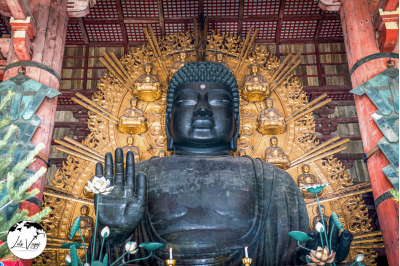
Todai-ji stands as the most impressive structure in Nara and houses Japan’s largest bronze Buddha statue (Daibutsu). The current temple building, while enormous at 57 meters long and 50 meters wide, is actually only two-thirds the size of the original 8th-century structure. The Great Buddha Hall (Daibutsu-den) ranks among the world’s largest wooden buildings despite its reduced dimensions.
The seated Buddha figure inside rises 15 meters and represents Vairocana, the cosmic Buddha believed to illuminate the universe with spiritual wisdom. The statue contains approximately 437 tons of bronze and 130 kg of gold. Visitors often attempt to crawl through a hole in one of the supporting wooden pillars said to be the same size as the Buddha’s nostril—a feat believed to bring good fortune to those who can pass through.
Behind the Great Buddha, you’ll find a wooden pillar with a hole at its base. According to tradition, those who can squeeze through this opening will achieve enlightenment in their next life. This attracts lines of children and slender adults hoping to secure their spiritual future.
Kasuga Taisha Shrine
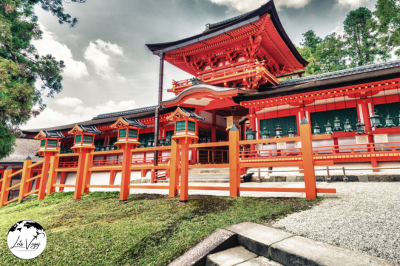
Kasuga Taisha, founded in 768 CE by the poerful Fujiwara clan, represents classic Shinto architectural style with its vermillion columns and decorative bronze lanterns. The approach to the shrine through a forest path lined with stone lanterns creates a deeply atmospheric experience, especially during the Setsubun Mantoro (February) and Obon Mantoro (August) festivals when these lanterns are lit.
The shrine is renowned for its thousands of bronze and stone lanterns, donated over centuries by worshippers. The inner shrine features wonderfully preserved buildings with architectural elements dating back to the 12th century.
Kofuku-ji Temple
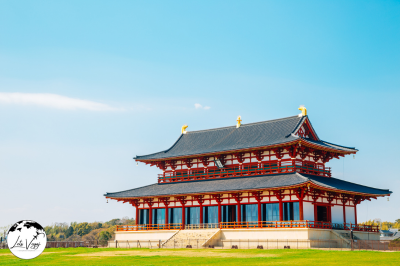
This temple complex, established in 710, served as the Fujiwara clan’s family temple and once comprised over 150 buildings. While many structures have been lost over time, several important buildings remain, including the five-story pagoda (Japan’s second tallest at 50 meters) and the three-story pagoda. The recently reconstructed Central Golden Hall (Chukondo) houses important Buddhist statues including a significant Yakushi Buddha.
The adjacent National Treasure Museum displays masterpieces of Buddhist art, most notably the six Kannon statues representing different manifestations of the deity of compassion and the famed dry-lacquer statue of Ashura, with its haunting expression and six arms.
Yakushi-ji Temple
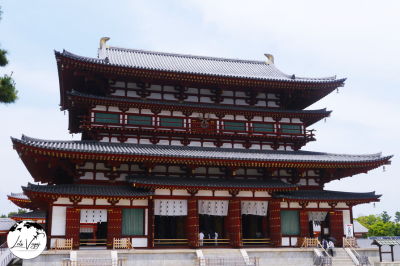
Located in southern Nara, this temple represents the pinnacle of Hakuho Buddhist architecture. The East Pagoda, dating from the original 8th-century construction, is considered one of Japan’s finest pagodas with its graceful silhouette and subtle curves that create an impression of upward movement. The temple’s Yakushi Triad—statues of the healing Buddha flanked by two bodhisattvas—exemplifies the technical and artistic heights of Nara period sculpture.
Heijo Palace Site
The archaeological remains of the original imperial compound offer insight into the layout and scale of ancient Japanese governance. The reconstructed Suzaku Gate and Former Audience Hall help visitors visualize the original complex, while the museum houses artifacts excavated from the site. The scale of the site impresses upon visitors the ambition and sophistication of early Japanese statecraft.
Horyu-ji Temple
About 12 km southwest of central Nara stands Horyu-ji, home to the world’s oldest surviving wooden structures dating from the early 7th century. This UNESCO World Heritage site contains over 2,300 important cultural artifacts and historic buildings. The five-story pagoda and main hall of the Western Precinct date from approximately 711 CE, making them extraordinary testimonies to ancient Japanese engineering and architectural techniques.
The temple complex houses some of Japan’s most important Buddhist art, including the Kudara Kannon, a sublime 7th-century statue whose serene expression and graceful proportions reflect the aesthetic ideals of the Asuka period that preceded the Nara era.
Naramachi – The Old Town District
About 12 km southwest of central Nara stands Horyu-ji, home to the world’s oldest surviving wooden structures dating from the early 7th century. This UNESCO World Heritage site contains over 2,300 important cultural artifacts and historic buildings. The five-story pagoda and main hall of the Western Precinct date from approximately 711 CE, making them extraordinary testimonies to ancient Japanese engineering and architectural techniques.
The temple complex houses some of Japan’s most important Buddhist art, including the Kudara Kannon, a sublime 7th-century statue whose serene expression and graceful proportions reflect the aesthetic ideals of the Asuka period that preceded the Nara era.
Osaka
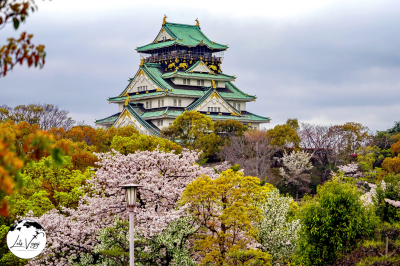
Osaka, Japan’s third-largest city, offers visitors a vibrant urban experience distinctly different from Tokyo or Kyoto. Known for its outgoing locals, spectacular food culture, and blend of ultramodern and traditional attractions, Osaka embodies the saying “eat until you drop” (kuidaore) that has long defined its spirited character. As a commercial powerhouse since ancient times, the city has developed a practical, entrepreneurial spirit alongside an infectious enthusiasm for life’s pleasures.
Universal Studios Japan

Universal Studios Japan (USJ) stands as one of Osaka’s premier attractions and has become a major destination not just for Japanese visitors but for tourists throughout Asia. Opened in 2001 as the first Universal Studios theme park outside the United States, USJ has consistently ranked among Japan’s most visited tourist sites.
The Park Experience
Universal Studios Japan offers a blend of Hollywood entertainment and uniquely Japanese adaptations across nine themed areas:
Super Nintendo World opened in 2021 as the world’s first Nintendo-themed amusement park area, creating an immersive recreation of the Mario universe. Visitors can participate in interactive challenges using special wristbands (Power-Up Bands), ride attractions like Mario Kart: Koopa’s Challenge using augmented reality technology, and dine at themed restaurants serving mushroom-shaped foods. The attention to detail in this area has set new standards for immersive theme park experiences.
The Wizarding World of Harry Potter recreates Hogwarts Castle and Hogsmeade Village with extraordinary fidelity to the film series. The signature attraction, Harry Potter and the Forbidden Journey, combines physical sets with projection technology for a groundbreaking ride experience. The area features shops selling wands, butterbeer, and other franchise items in meticulously themed environments.
Minion Park celebrates the popular characters from the Despicable Me franchise with family-friendly attractions and extensive merchandising opportunities. The bright yellow theming makes this area particularly appealing to younger visitors.
Other areas include Hollywood, New York, San Francisco, Jurassic Park, Amity Village, and Universal Wonderland, each offering themed attractions, restaurants, and shopping opportunities.
Seasonal Events
Universal Studios Japan has distinguished itself through elaborate seasonal events that draw repeat visitors:
Halloween Horror Nights (September-October) transforms sections of the park into haunted zones with costumed performers creating Japan’s largest horror event. Unlike American haunted attractions, the Japanese version often incorporates elements from Japanese horror traditions alongside Universal’s classic monster properties.
Christmas Celebration (November-January) features illuminations, parades, and seasonal entertainment with a distinctly Japanese interpretation of Western Christmas traditions.
Cool Japan is a rotating series of limited-time attractions featuring popular Japanese properties like Monster Hunter, Detective Conan, Attack on Titan, and other anime/manga franchises. These temporary attractions demonstrate USJ’s understanding of the domestic market and ability to blend Hollywood entertainment with Japanese pop culture.
Practical Information
Tickets: Standard one-day passes start around ¥8,400 for adults, with various upgrade options including Express Passes that reduce waiting times for popular attractions. During peak periods like national holidays, the park may reach capacity, making advance ticket purchase essential.
Getting to Universal Studios Japan, Osaka
Address
Universal Studios Japan 2-1-33 Sakurajima, Konohana Ward Osaka, 554-0031 Japan
Opening Hours
- Generally 9:00 AM to 7:00 PM
- Hours vary by season, holidays, and special events
- Extended hours during peak seasons and holidays
Contact Information
- Phone: +81 570-20-0606
- Website: https://www.usj.co.jp/web/en/us
- Customer service email: info@usj.co.jp
Transportation Options
By Train
- JR Universal City Station (direct access to USJ)
- From Osaka Station: JR Osaka Loop Line to Nishikujo Station, then transfer to JR Yumesaki Line (about 20 minutes total)
- From Shin-Osaka Station: JR Tokaido Main Line to Osaka Station, then follow route above (about 30 minutes total)
- From Kyoto: JR Special Rapid Service to Osaka Station, then follow route above (about 75 minutes total)
- From Kansai International Airport: JR Airport Express Haruka to Tennoji Station, transfer to JR Loop Line to Nishikujo, then JR Yumesaki Line (about 70 minutes total)
- Direct Trains
- JR Special Rapid Service “Universal City” runs directly from:
- Kyoto Station (70 minutes)
- Shin-Osaka Station (25 minutes)
- Osaka Station (15 minutes)
- Limited express trains available during peak seasons
- JR Special Rapid Service “Universal City” runs directly from:
By Subway
- From Umeda: Osaka Metro Midosuji Line to Honmachi, transfer to Chuo Line to Kujo, then walk to JR Kujo Station and take JR Yumesaki Line (about 40 minutes)
By Bus
- From Osaka Station: Direct buses to USJ (25-30 minutes)
- From Namba: Direct buses to USJ (30-35 minutes)
- From Kansai Airport: Airport Limousine Bus (about 65 minutes)
By Ferry
- Captain Line Ferry: From Kaiyukan Station (Osaka Aquarium) to Universal City Port (10 minutes)
- Runs every 10-15 minutes
- Cost: ¥700 one-way for adults
Parking Options
- Official USJ Parking
- Fee: Weekdays ¥2,500/day, Weekends/Holidays ¥3,000/day
- Capacity: 2,720 vehicles
- Opens 30 minutes before park opening
- Universal City Walk Parking
- Fee: ¥600/hour, maximum ¥2,400/day
- Capacity: 900 vehicles
- Sakurajima Parking
- Fee: ¥1,500-2,000/day
- About 10-minute walk to USJ entrance
- Capacity: 500 vehicles
- Konohana-ku Municipal Parking
- Fee: ¥1,000-1,500/day
- About 15-minute walk to USJ entrance
- Capacity: 300 vehicles
Transportation Companies
Buses
- Airport Limousine: https://www.kate.co.jp/en/
- Willer Express: https://willerexpress.com/en/
Metro(subway)
- Osaka Metro: https://www.osakametro.co.jp/en/
Taxis
- MK Taxi: +81 6-6928-4321
- Osaka Taxi: +81 6-6451-5111
Nearby Attractions
- Universal City Walk Osaka – Shopping and dining complex (adjacent to USJ)
- Osaka Aquarium Kaiyukan – One of the world’s largest aquariums (15 minutes by ferry)
- Tempozan Ferris Wheel – Near Kaiyukan (15 minutes by ferry)
- Tempozan Harbor Village – Shopping mall (15 minutes by ferry)
- Osaka Bay Area – Various attractions (20-30 minutes)
- Osaka Castle – Historic landmark (30 minutes by train)
- Dotonbori – Famous entertainment district (30 minutes by train)
Osaka Castle
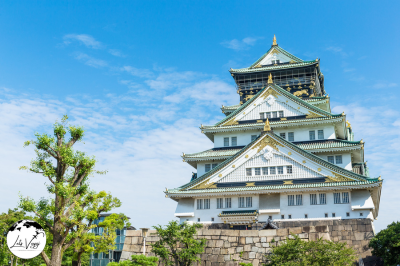
Although the current structure is a concrete reconstruction from 1931 (with interior renovations in 1997), Osaka Castle remains the city’s most recognizable landmark. The castle’s museum chronicles the life of Toyotomi Hideyoshi and the tumultuous period of Japanese unification. The surrounding park, planted with approximately 4,000 cherry trees, becomes one of Japan’s most popular hanami (cherry blossom viewing) spots each spring.
For the best experience, approach the castle through Nishinomaru Garden on the western side, where preserved sections of stone walls and moats provide historical context. The eighth-floor observation deck offers panoramic views of the surrounding city. History enthusiasts should note that while little of the original 16th-century structure remains, the massive stone foundations offer authentic testimony to the engineering achievements of the period.
Basic Information
Address
Osaka Castle 1-1 Osakajo, Chuo Ward Osaka, 540-0002 Japan
Opening Hours
- Castle Park: Open 24 hours, free admission
- Castle Tower (Main Keep): 9:00 AM to 5:00 PM (last entry 4:30 PM)
- Closed: December 28 to January 1
- Extended hours during cherry blossom season and special events
Contact Information
- Phone: +81 6-6941-3044
- Website: https://www.osakacastle.net/english/
- Email: info@osakacastle.net
Transportation Options
By Train/Subway
- Tanimachi 4-chome Station (closest to southwest castle entrance)
- Tanimachi Line and Chuo Line
- 5-10 minute walk to castle grounds
- Osakajokoen Station (JR Loop Line, closest to east gate)
- 10 minute walk to castle
- From Osaka/Umeda Station: JR Loop Line (15 minutes)
- From Shin-Osaka Station: JR Line to Osaka Station, then Loop Line (25 minutes)
- Morinomiya Station (closest to south entrance)
- JR Loop Line and Nagahori Tsurumi-ryokuchi Line
- 10 minute walk to castle grounds
- Osaka Business Park Station
- Nagahori Tsurumi-ryokuchi Line
- 15 minute walk to the castle
By Bus
- From Osaka Station: City Bus #88 to “Osakajo Koen” stop
- From Namba: City Bus #62 to “Osakajo Koen” stop
- Tourist Loop Bus “Osaka Wonder Loop” stops at Osaka Castle
By Boat
- Aqua-Liner Sightseeing Cruise from Osakajo Pier (near Temmabashi)
- 60-minute cruise around the castle moat
- Operates 10:00 AM to 4:00 PM (varies by season)
- Fee: ¥1,700 adults, ¥800 children
Parking Options
- Osaka Castle Park Parking (Official)
- Fee: ¥300/hour, maximum ¥1,500/day
- Capacity: 300 vehicles
- Located near the Morinomiya entrance
- Osaka Castle Nishinomaru Garden Parking
- Fee: ¥500/hour, maximum ¥1,500/day
- Capacity: 170 vehicles
- Located near the west entrance
- NPC Osakajo Parking
- Fee: ¥200/30 minutes, maximum ¥1,800/day
- Capacity: 200 vehicles
- 5-minute walk to castle entrance
- Osaka Business Park Underground Parking
- Fee: ¥300/hour
- Capacity: 500 vehicles
- 15-minute walk to castle
Nearby Attractions
- Osaka Museum of History – 5-minute walk from southwest entrance
- NHK Osaka Broadcasting Station – 10-minute walk from southwest entrance
- Osaka Business Park – 15-minute walk from south entrance
- Osaka-jo Hall (concert venue) – Inside castle grounds
- Tenmabashi (shopping district) – 15-minute walk from north entrance
- Osaka Castle Park – Surrounding the castle (plum grove, cherry trees, etc.)
- Hokoku Shrine – Inside castle grounds
- Toyokuni Shrine – Inside castle grounds
- Osaka International Peace Center – 15-minute walk from the castle
Dotonbori
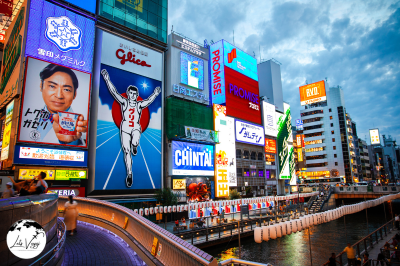
This neon-saturated entertainment district along the canal of the same name epitomizes Osaka’s reputation for revelry and indulgence. Giant mechanical crabs, pufferfish, and other dramatic signage create a sensory overload that reaches its peak after sunset when the canal waters reflect countless illuminated billboards.
Food stands alongside the pedestrianized Dotonbori Street serve Osaka specialties like takoyaki (octopus balls) and okonomiyaki (savory pancakes). The Glico Running Man sign—featuring an athlete with arms raised in triumph—has served as Osaka’s unofficial symbol since 1935, making it a popular photo spot for visitors.
Beyond food, Dotonbori offers shopping, theaters, and people-watching opportunities unmatched elsewhere in Japan. The nearby Hozenji Yokocho alley provides atmospheric contrast with its stone-paved paths and traditional restaurants illuminated by paper lanterns.
Basic Information
Address
Dotonbori Chuo Ward, Osaka Osaka Prefecture, 542-0071 Japan (Main area runs along the Dotonbori Canal between Nipponbashi and Mido-suji streets)
Opening Hours
- Open-air area with 24/7 access
- Most shops and restaurants: 11:00 AM to 10:00 PM
- Nightlife venues and some restaurants: open until midnight or later
- Hours vary by individual establishment
Contact Information
- Osaka Tourism Bureau: +81 6-6282-5900
- Website: https://osaka-info.jp/en/
- Minami (Namba) Tourist Information Center: +81 6-6631-9100
Transportation Options
By Subway
- Namba Station (most convenient)
- Served by: Midosuji Line, Yotsubashi Line, Sennichimae Line
- 5-minute walk to Dotonbori
- From Osaka/Umeda: Midosuji Line (10 minutes)
- From Shin-Osaka: Midosuji Line (15-20 minutes)
- Nipponbashi Station
- Served by: Sennichimae Line, Sakaisuji Line
- 5-minute walk to eastern end of Dotonbori
- Shinsaibashi Station
- Served by: Midosuji Line, Nagahori Tsurumi-ryokuchi Line
- 7-minute walk to western end of Dotonbori
By Train
- Nankai Namba Station
- Direct trains from Kansai International Airport (about 45 minutes)
- 7-minute walk to Dotonbori
- Kintetsu Namba Station
- Connected to JR and subway Namba stations
- 5-minute walk to Dotonbori
- JR Namba Station
- Served by: JR Yamatoji Line
- 10-minute walk to Dotonbori
By Bus
- From Osaka/Umeda: City Bus routes #46, #88 to “Namba” stop
- From Osaka Castle: City Bus route #62 to “Namba” stop
- From Kansai Airport: Airport Limousine Bus to OCAT (Namba), then 10-minute walk
Parking Options
- Dotonbori Parking (NPC)
- Fee: ¥400/30 minutes, maximum ¥2,000/day
- Capacity: 150 vehicles
- Located near Ebisubashi Bridge
- Namba Parks Parking
- Fee: ¥300/30 minutes, maximum ¥2,500/day
- Capacity: 1,200 vehicles
- 10-minute walk to Dotonbori
- Takashimaya Parking
- Fee: ¥600/hour, maximum ¥3,000/day
- Capacity: 500 vehicles
- 7-minute walk to Dotonbori
- Parco Parking
- Fee: ¥400/30 minutes
- Validation discounts available with shopping
- 5-minute walk to Dotonbori
Nearby Attractions
- Shinsaibashi Shopping Arcade – Connected to western end (5-minute walk)
- Glico Running Man Sign – Iconic neon sign at Ebisubashi Bridge
- Hozenji Yokocho – Historic alley with traditional shops and restaurants (3-minute walk)
- Kuromon Ichiba Market – Famous food market (10-minute walk)
- Namba Grand Kagetsu (NGK) – Famous comedy theater (5-minute walk)
- Amerikamura (American Village) – Youth fashion district (10-minute walk)
- Den Den Town – Electronics and anime district (15-minute walk)
- Namba Parks – Modern shopping complex with rooftop garden (10-minute walk)
- Sennichimae Doguyasuji – Shopping street with kitchenware and restaurant supplies (7-minute walk)
- Osaka Shochikuza Theater – Traditional kabuki theater (5-minute walk)
Shinsekai
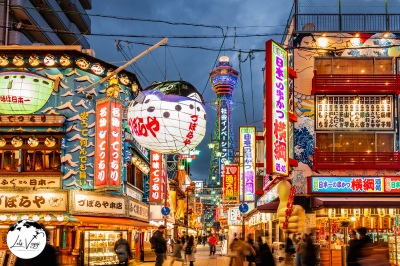
This retro district surrounding the Tsutenkaku Tower offers a glimpse of early 20th-century Osaka. Built in 1912 and modeled after Paris (northern section) and Coney Island (southern section), Shinsekai has maintained its working-class character while developing a nostalgic appeal for visitors seeking “old Osaka” atmosphere.
The area’s centerpiece is Tsutenkaku, a 103-meter tower whose name means “reaching heaven.” First built in 1912 and reconstructed in 1956, the tower houses the Billiken statue—a grinning charm figure whose feet visitors rub for good luck. The surrounding streets specialize in kushikatsu (deep-fried skewered foods), served in modest establishments with unchanged recipes and décor from decades past.
While Shinsekai developed a somewhat rough reputation in postwar years, today it offers safe exploration of a neighborhood that feels frozen in time, with mid-century signage, retro gaming parlors, and unpretentious eateries where locals gather for affordable meals and conversation.
Basic Information
Address
Shinsekai Ebisuhigashi, Naniwa Ward Osaka, 556-0002 Japan (Centered around Tsutenkaku Tower)
Opening Hours
- Open-air area with 24/7 access
- Most shops and restaurants: 11:00 AM to 10:00 PM
- Some restaurants open early for breakfast from 7:00 AM
- Hours vary by individual establishment
- Tsutenkaku Tower: 9:00 AM to 9:00 PM (last entry 8:30 PM)
Contact Information
- Osaka Tourism Bureau: +81 6-6282-5900
- Tsutenkaku Tower: +81 6-6641-9555
- Website: https://www.tsutenkaku.co.jp/
- Shinsekai Shopping Association: +81 6-6643-3536
Transportation Options
By Subway
- Ebisucho Station (most convenient)
- Served by: Sakaisuji Line
- Exit 3 leads directly to Shinsekai (1-minute walk)
- From Osaka/Umeda: Take Midosuji Line to Dobutsuen-mae, transfer to Sakaisuji Line (20 minutes total)
- Dobutsuen-mae Station
- Served by: Midosuji Line, Sakaisuji Line
- 5-minute walk to northern end of Shinsekai
- From Shin-Osaka: Take Midosuji Line directly (20-25 minutes)
- Shin-Imamiya Station
- Served by: JR Loop Line, JR Yamatoji Line
- 7-minute walk to Tsutenkaku Tower
- From Osaka/Umeda: JR Loop Line (15 minutes)
By Train
- JR Shin-Imamiya Station
- Served by: JR Loop Line, JR Yamatoji Line
- 7-minute walk to Shinsekai
- Direct access from Kansai Airport via JR trains (change at Tennoji, 55 minutes total)
- Nankai Shin-Imamiya Station
- Adjacent to JR Shin-Imamiya Station
- Nankai Line from Kansai Airport to Shin-Imamiya (50 minutes)
By Bus
- From Namba: City Bus #46 to “Ebisugawa Nichome” stop
- From Osaka/Umeda: City Bus #62 to “Dobutsuen-mae” stop
- From Tennoji: City Bus #103 to “Shinsekai” stop
Parking Options
- Tsutenkaku Parking
- Fee: ¥300/30 minutes, maximum ¥1,500/day
- Capacity: 80 vehicles
- Located directly by Tsutenkaku Tower
- Times Parking Shinsekai
- Fee: ¥200/30 minutes, maximum ¥1,200/day
- Capacity: 50 vehicles
- Located on the east side of Shinsekai
- Park 24 Shinsekai
- Fee: ¥300/hour, maximum ¥1,500/day
- Capacity: 40 vehicles
- 3-minute walk to Shinsekai
- Spa World Parking
- Fee: ¥300/hour (free for Spa World customers)
- Capacity: 200 vehicles
- 5-minute walk to Shinsekai
Nearby Attractions
- Tsutenkaku Tower – Iconic landmark at the center of Shinsekai (150m tall)
- Spa World – Large public bath complex (5-minute walk)
- Tennoji Zoo – One of Japan’s oldest zoos (10-minute walk)
- Tennoji Park – Large urban park (10-minute walk)
- Abeno Harukas – Japan’s tallest skyscraper (15-minute walk)
- Shitennoji Temple – One of Japan’s oldest temples (15-minute walk)
- Tennoji Station Area – Major shopping and transportation hub (15-minute walk)
- JAN JAN Yokocho – Shopping arcade with many small shops (adjacent to Shinsekai)
- New World Shopping Street – Traditional shopping arcade with local stores (part of Shinsekai)
- Nipponbashi Den-Den Town – Electronics and anime district (20-minute walk)
Shitennoji Temple
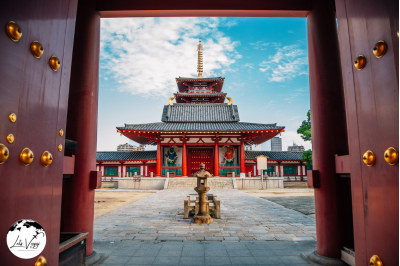
Founded in 593 CE by Prince Shotoku, who introduced Buddhism to Japan, Shitennoji claims to be the country’s first officially established Buddhist temple. While fires and wars have necessitated numerous reconstructions (most recently after World War II bombing), the temple maintains its original 6th-century layout—one of the oldest designs in Japanese Buddhism.
The temple complex includes a five-story pagoda, main hall (Kondo), lecture hall (Kodo), and an immaculately landscaped garden. On the 21st of each month, the temple grounds host a lively flea market where locals sell everything from antiques to home-cooked food, creating an opportunity to experience community life seldom available to tourists.
Basic Informtion
Address
Shitennoji Temple 1-11-18 Shitennoji, Tennoji Ward Osaka, 543-0051 Japan
Opening Hours
- Temple Grounds: 8:00 AM to 4:30 PM (April to September) 8:30 AM to 4:00 PM (October to March)
- Gokuraku-jodo Garden: 8:00 AM to 4:00 PM
- Treasure House: 8:00 AM to 4:00 PM
- Closed: No regular closing days
- Last entry 30 minutes before closing
Contact Information
- Phone: +81 6-6771-0066
- Website: https://www.shitennoji.or.jp/
- Email: info@shitennoji.or.jp
Transportation Options
By Subway
- Shitennoji-mae Yuhigaoka Station (closest)
- Served by: Tanimachi Line
- 3-minute walk to south entrance
- From Osaka/Umeda: Tanimachi Line (20-25 minutes)
- Tennoji Station
- Served by: Midosuji Line, Tanimachi Line
- 10-minute walk to west entrance
- From Shin-Osaka: Midosuji Line directly (25 minutes)
By Train
- JR Tennoji Station
- Served by: JR Loop Line, JR Hanwa Line, JR Yamatoji Line
- 12-minute walk to west entrance
- From Osaka Station: JR Loop Line (15 minutes)
- From Kansai Airport: JR Airport Express to Tennoji (50 minutes)
- Tennoji-Ekimae Station (Osaka Abenobashi)
- Served by: Kintetsu Minami Osaka Line
- 12-minute walk to temple
By Bus
- From Tennoji Station: City Bus #62 to “Shitennoji-mae” stop
- From Osaka/Umeda: City Bus #62 to “Shitennoji-mae” stop
- From Namba: City Bus #46 to “Shitennoji-mae” stop
Parking Options
- Shitennoji Temple Parking
- Fee: ¥400/hour, maximum ¥1,500/day
- Capacity: 30 vehicles
- Located at the temple’s east entrance
- Tennoji Park Underground Parking
- Fee: ¥300/hour, maximum ¥1,800/day
- Capacity: 250 vehicles
- 10-minute walk to temple
- MiPark Shitennoji
- Fee: ¥200/30 minutes, maximum ¥1,200/day
- Capacity: 40 vehicles
- 5-minute walk to temple
- Times Parking Tennoji
- Fee: ¥300/hour, maximum ¥1,500/day
- Capacity: 60 vehicles
- 7-minute walk to temple
Nearby Attractions
- Tennoji Park – Adjacent to the temple
- Tennoji Zoo – 5-minute walk from temple
- Osaka City Museum of Fine Arts – In Tennoji Park (5-minute walk)
- Abeno Harukas – Japan’s tallest building (10-minute walk)
- Shinsekai – Nostalgic district with Tsutenkaku Tower (15-minute walk)
- Tennoji Station/Q’s Mall – Major shopping area (10-minute walk)
- Hozen-ji Temple – Historic temple (20-minute walk)
- Isshinji Temple – Famous temple with unique Buddha statues (15-minute walk)
America-mura (American Village)
This youth-oriented shopping district represents Osaka’s counterculture hub, with street fashion boutiques, vintage clothing shops, record stores, and casual eateries catering to trend-conscious locals. Named for its early focus on imported American products in the post-war years, America-mura continues to embody Osaka’s openness to external influences while maintaining a distinctly local interpretation.
The area’s central park—colloquially called “Triangle Park” for its shape—serves as a gathering place for street performers, skateboarders, and people-watchers. Fashion photographers often scout the surrounding streets for cutting-edge styles that may predict upcoming trends.
Basic Information
Address
America-mura (Amerikamura) 1 Chome to 3 Chome, Nishi-Shinsaibashi Chuo Ward, Osaka, 542-0086 Japan (Triangular area west of Midosuji Avenue, between Dotonbori and Shinsaibashi)
Opening Hours
- Open-air district with 24/7 access
- Most shops: 11:00 AM to 9:00 PM
- Clothing stores typically open 11:00 AM to 8:00 PM
- Cafes: 10:00 AM to 10:00 PM
- Restaurants and bars: 11:00 AM to midnight or later
- Clubs and nightlife venues: 9:00 PM to 5:00 AM
- Hours vary by individual establishment
Contact Information
- Osaka Tourism Bureau: +81 6-6282-5900
- Website: https://osaka-info.jp/en/
Transportation Options
By Subway
- Shinsaibashi Station (most convenient)
- Served by: Midosuji Line, Nagahori Tsurumi-ryokuchi Line
- Exit 7 leads directly to America-mura (2-minute walk)
- From Osaka/Umeda: Midosuji Line directly (10 minutes)
- From Shin-Osaka: Midosuji Line directly (15 minutes)
- Namba Station
- Served by: Midosuji Line, Sennichimae Line, Yotsubashi Line
- 10-minute walk to America-mura
- Yotsubashi Station
- Served by: Yotsubashi Line
- 5-minute walk to western side of America-mura
By Train
- Nankai Namba Station
- Direct trains from Kansai International Airport (45 minutes)
- 15-minute walk to America-mura
- JR Namba Station
- Served by: JR Yamatoji Line
- 15-minute walk to America-mura
By Bus
- From Osaka/Umeda: City Bus #88 to “Shinsaibashi” stop
- From Osaka Castle: City Bus #62 to “Shinsaibashi” stop
- From Tennoji: City Bus #103 to “Shinsaibashi” stop
- Tourist Loop Bus “Osaka Wonder Loop” stops at Shinsaibashi
Parking Options
- Big Step Parking
- Fee: ¥400/30 minutes, maximum ¥2,000/day
- Capacity: 180 vehicles
- Located in the heart of America-mura
- Shopping validation available for discounts
- OPA Shinsaibashi Parking
- Fee: ¥600/hour, maximum ¥2,500/day
- Capacity: 100 vehicles
- 5-minute walk to America-mura
- Times Parking Amerikamura
- Fee: ¥300/30 minutes, maximum ¥2,000/day
- Capacity: 50 vehicles
- Located on the eastern edge of America-mura
- Mitsui Repark Shinsaibashi
- Fee: ¥400/30 minutes
- Capacity: 30 vehicles
- 3-minute walk to America-mura
Nearby Attractions
- Triangle Park (Sankaku Koen) – Central meeting spot in America-mura
- Big Step – Multi-story shopping complex with distinctive architecture
- Shinsaibashi-suji Shopping Street – Covered shopping arcade (5-minute walk)
- Dotonbori – Famous entertainment district (10-minute walk)
- Hozenji Yokocho – Historic alley with traditional atmosphere (10-minute walk)
- Namba Parks – Modern shopping complex with rooftop garden (15-minute walk)
- Mitsu Park – Small urban park (within America-mura)
- Orange Street (Tachibana-dori) – Trendy shopping street extending from America-mura
- Osaka Shochikuza Theater – Traditional kabuki theater (10-minute walk)
- Namba Grand Kagetsu (NGK) – Famous comedy theater (15-minute walk)
Tempozan Harbor Village
This waterfront complex blends entertainment, shopping, and maritime attractions. The Osaka Aquarium (Kaiyukan) ranks among Japan’s most impressive marine facilities, with a massive central tank housing whale sharks and manta rays within a spiraling exhibition path that takes visitors from the surface to the depths of the ocean.
Adjacent attractions include the Tempozan Ferris Wheel (offering 15-minute rides with panoramic bay views), the Legoland Discovery Center, and the Santa Maria cruise ship that plies Osaka Bay. The complex provides family-friendly diversion while connecting visitors to Osaka’s maritime heritage.
Basic Information
Address & Contact Information
- Address: 1-1-10 Kaigandori, Minato Ward, Osaka, 552-0022, Japan
- Phone: +81-6-6576-5501
Opening Hours
- 11:00 AM – 8:00 PM (hours may vary by individual shops and attractions)
- Restaurants typically open until 9:00 PM or 10:00 PM
Transportation Options
By Train
- Osaka Metro Chuo Line: Get off at Osakako Station (Exit 1). The village is about a 5-minute walk.
- JR Lines: Take JR to Bentencho Station, then transfer to the Chuo Line and get off at Osakako Station.
By Bus
- Osaka City Bus: Routes 88 and 60 stop at “Tempozan” bus stop
- Kaiyukan Shuttle Bus: Runs between Osaka Station/Namba and Tempozan Harbor Village
By Water Transport
- Aqua-Liner Water Bus: Connects Osaka Castle, Nakanoshima, and Tempozan
- Santa Maria Cruise Ship: Offers harbor cruises departing from Tempozan Harbor
By Car
- Via Hanshin Expressway Route 16 (Osakako Exit)
- Via Hanshin Expressway Route 4 (Minato Exit)
Parking
- Tempozan Marketplace Parking: About 700 spaces
- Kaiyukan Parking: About 1,500 spaces
- Fees: Approximately ¥500-700 per hour, with validation discounts available when shopping
Nearby Attractions
- Osaka Aquarium Kaiyukan (connected to the Harbor Village)
- Tempozan Ferris Wheel
- Legoland Discovery Center Osaka
- Suntory Museum
- Mount Tempozan Park (small hill with good views)
- Universal Studios Japan (a short ferry ride away)
Kuromon Ichiba Market
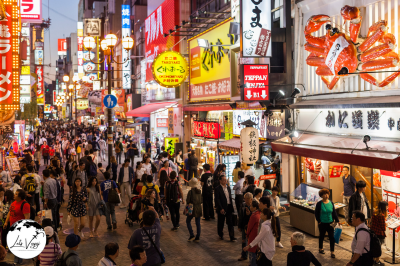
Often called “Osaka’s kitchen,” this 580-meter covered shopping street has served local residents and restaurant professionals for nearly 200 years. Approximately 150 shops offer everything from fresh seafood and produce to kitchen tools and specialty ingredients.
Many vendors provide samples or ready-to-eat portions, making the market perfect for grazing through Osaka’s culinary landscape. Highlights include grilled scallops served in their shells, fresh tuna sashimi, and seasonal fruits presented with gift-worthy perfection. Unlike Tokyo’s more famous Tsukiji (now Toyosu) market, Kuromon caters equally to tourists and locals, creating an accessible yet authentic atmosphere.
Umeda Sky Building

This dramatic modern landmark consists of two 40-story towers connected by a “Floating Garden Observatory” that offers 360-degree views from 170 meters above ground. The futuristic structure, with its striking circular cutout and exposed escalators crossing between towers, represents the bold architectural vision that reshaped Osaka’s skyline in the bubble economy years.
Below the towers, the Takimi-Koji restaurant floor recreates an early Showa-period (1926-1989) Japanese streetscape with atmospheric dining options. This combination of ultra-modern design with nostalgic elements exemplifies Osaka’s approach to urban development—embracing the future while maintaining connections to the past.
Okinawa
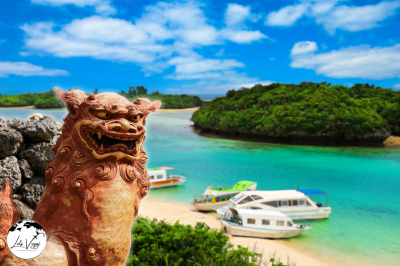
Okinawa is Japan’s southernmost prefecture, consisting of a chain of 160 islands stretching between mainland Japan and Taiwan. With its unique blend of Japanese and Ryukyuan cultures, stunning beaches, rich history, and vibrant marine life, Okinawa offers visitors an experience quite distinct from the rest of Japan.
Understanding Okinawa
Before diving into specific destinations, it’s helpful to understand that Okinawa was once the independent Ryukyu Kingdom with its own distinct culture, language, and traditions. It was annexed by Japan in 1879, and this history has created a place with a fascinating cultural identity that differs from mainland Japan. The islands also experienced some of the fiercest fighting in World War II, leaving historical sites that tell powerful stories about this period.
Naha (Main Island)

Naha is Okinawa’s capital and serves as an excellent introduction to the region:
Shuri Castle – Although the original structure was destroyed by fire in 2019 (reconstruction is underway), this UNESCO World Heritage site was the palace of the Ryukyu Kingdom. The distinctive red architecture and stone walls reflect Chinese influence while remaining uniquely Ryukyuan.
Kokusai Dori (International Street) – This lively 1.6 km shopping street is filled with souvenir shops, restaurants serving Okinawan specialties, and shops selling local crafts. It’s particularly vibrant in the evenings.
Makishi Public Market – Often called “Okinawa’s Kitchen,” this market offers fresh seafood, local produce, and traditional foods. You can buy seafood downstairs and have restaurants upstairs cook it for you.
Churaumi Area (Northern Main Island)
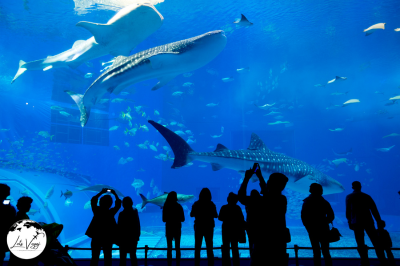
Okinawa Churaumi Aquarium – One of the world’s largest aquariums, featuring the massive Kuroshio Tank with whale sharks and manta rays. The aquarium showcases Okinawa’s rich marine biodiversity and offers educational exhibits about ocean conservation.
Cape Manzamo – A scenic cliff offering breathtaking ocean views, famous for its “elephant trunk” shaped rock formation created by wave erosion over thousands of years.
Kouri Island – Connected to the main island by a picturesque 2km bridge, this small island features beautiful beaches, heart-shaped rocks, and the Kouri Ocean Tower observation deck.
Kerama Islands
Just 30-60 minutes by ferry from Naha:
Zamami Island – Known for pristine beaches like Furuzamami and Ama, this island offers some of the clearest waters in Japan. Between January and March, you can often spot humpback whales from the observatory points.
Tokashiki Island – Home to Aharen Beach and Tokashiku Beach, both offering excellent snorkeling opportunities among colorful coral reefs and diverse marine life.
Ishigaki and Yaeyama Islands (Southern Islands)
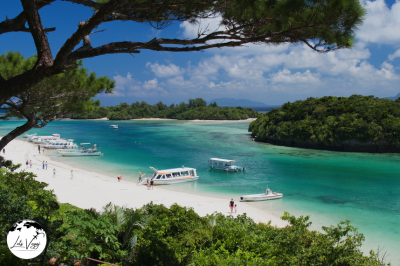
These more remote islands require a flight from Naha but reward visitors with even more unspoiled natural beauty:
Kabira Bay (Ishigaki) – With its emerald blue waters and white sand beaches, this is often considered one of Japan’s most beautiful coastal areas. Glass-bottom boat tours offer views of the underwater landscape.
Taketomi Island – A small island preserved in traditional Ryukyuan style with sandy streets, traditional red-tiled roof houses, and water buffalo cart rides. The star-shaped sand at Kaiji Beach is a unique natural phenomenon.
Iriomote Island – Japan’s “jungle island” is 90% covered in subtropical forests and mangroves. Activities include kayaking through mangrove rivers, hiking to Pinaisara Falls, and spotting the elusive Iriomote wildcat if you’re extremely lucky.
Kanazawa
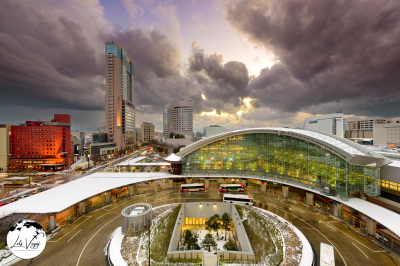
Kanazawa, located in Ishikawa Prefecture on Japan’s central coast, is one of Japan’s best-preserved historical cities. Often called “Little Kyoto” but with fewer crowds, Kanazawa escaped the destruction of World War II, allowing its Edo-period (1603-1867) districts and cultural heritage to remain intact.
Kenrokuen

Kenrokuen is considered one of Japan’s “Three Great Gardens” (along with Kairakuen in Mito and Korakuen in Okayama). The name “Kenrokuen” means “Garden of the Six Sublimities,” referring to the six essential attributes that make a perfect garden according to Chinese landscape theory: spaciousness, seclusion, artifice, antiquity, water courses, and panoramas.
Originally part of the outer gardens of Kanazawa Castle, Kenrokuen was developed over nearly two centuries by the ruling Maeda family. The garden changes dramatically with the seasons:
- In spring, cherry blossoms create a pink canopy
- Summer brings lush greenery and irises
- Fall transforms the landscape with vibrant red and gold foliage
- Winter showcases the famous yukitsuri (snow-hanging ropes) that protect the pine trees from heavy snowfall
The garden features meandering streams, a large central pond (Kasumigaike), and various bridges, stone lanterns, and tea houses. The Kotojitoro, a unique two-legged stone lantern, has become an iconic symbol of the garden.
Kanazawa Castle
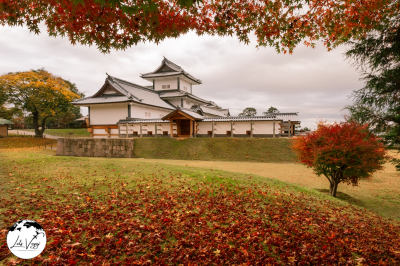
Located adjacent to Kenrokuen Garden, Kanazawa Castle was the seat of the powerful Maeda clan who ruled the Kaga domain for over two centuries. While many original structures were lost to fires over the centuries, significant portions have been meticulously reconstructed using traditional building methods and materials.
The castle is known for its distinctive white walls and impressive stonework. The Ishikawa Gate and the recently restored Hishi Yagura turret, Gojikken Nagaya warehouse, and Hashizume-mon Gate showcase traditional carpentry techniques that used no nails in their construction. The castle grounds offer excellent views of the city and connect directly to Kenrokuen Garden.
Higashi Chaya District
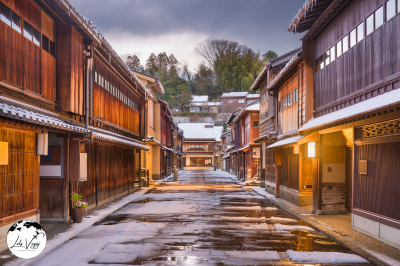
The largest and most famous of Kanazawa’s geisha districts (chaya means “tea house”). The district’s main street is lined with well-preserved wooden buildings where geiko (the local term for geisha) once entertained wealthy patrons with music, dance, and conversation.
Two tea houses are open to the public:
- Shima Teahouse offers a glimpse into the authentic interior of a geisha house
- Kaikaro Teahouse features rooms decorated with gold leaf and offers tea ceremonies
Many traditional buildings now house cafes, shops, and restaurants. The district is particularly atmospheric in the evening when lanterns illuminate the streets.
Nagamachi Samurai District

This well-preserved district was once home to samurai and their families during the Edo period. Characterized by narrow lanes, earthen walls, private entrance gates, and canals, it provides an authentic glimpse into samurai life.
The Nomura Samurai House is a highlight, featuring a small but exquisite Japanese garden, samurai artifacts, and original interior decorations. The Kaga Yuzen Traditional Industry Center and the Ashigaru Shiryokan (foot soldier museum) are also worth visiting in this area.
21st Century Museum of Contemporary Art
A striking contrast to the city’s historical sites, this circular modern museum has become one of Kanazawa’s most popular attractions. Designed by acclaimed architects SANAA (Kazuyo Sejima and Ryue Nishizawa), the museum is known for innovative architecture and world-class exhibitions.
The museum houses permanent installations like Leandro Erlich’s “Swimming Pool,” which creates the illusion of people walking underwater, and James Turrell’s light installations. The building’s design, with its transparent circular structure, aims to eliminate barriers between art and visitors.
Omicho Market
Often called “Kanazawa’s Kitchen,” this covered market has been serving the city since the Edo period. With over 170 shops and stalls, it’s the perfect place to experience local cuisine and the bounty of the Sea of Japan.
The market sells fresh seafood, produce, prepared foods, and local specialties. Many stalls offer standing counters where you can sample delicacies like crab, sweet shrimp, and nodoguro (blackthroat seaperch) – all caught in the nearby waters. There are also several small restaurants within the market that serve exceptionally fresh seafood bowls (kaisen-don).
Myoryuji (Ninja Temple)
Despite its nickname, this temple has no actual connection to ninjas. Rather, it earned its moniker due to its ingenious defensive architecture featuring hidden rooms, secret passages, traps, and deceptive staircases. Built during a time when the shogunate limited the construction of Buddhist temples, Myoryuji was designed with military defense in mind.
The temple can only be visited through guided tours (reservations required), which reveal the building’s clever architectural tricks, including a hidden floor and escape routes.
Nikko

Nikko, located about 150 kilometers north of Tokyo in Tochigi Prefecture, represents one of Japan’s most significant cultural and natural destinations. The area seamlessly blends historical religious sites with breathtaking natural landscapes, creating a uniquely Japanese experience that has attracted visitors for centuries. Let me guide you through this remarkable destination, explaining both its cultural importance and practical visitor information.
Understanding Nikko’s Significance
Nikko holds profound importance in Japanese history and spirituality. The name “Nikko” literally translates to “sunlight,” which feels appropriate given the area’s striking beauty. The region became especially significant in the early 17th century when Tokugawa Ieyasu, the founder of the Tokugawa shogunate that ruled Japan for over 250 years, chose Nikko as his final resting place. This decision transformed Nikko from a center of mountain worship into one of Japan’s most lavishly decorated religious sites.
Toshogu Shrine: The Magnificent Mausoleum
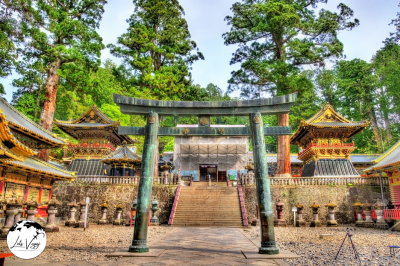
The Toshogu Shrine stands as Nikko’s crowning jewel and represents one of Japan’s most ornate religious structures. Unlike the typically austere Shinto architectural style seen elsewhere in Japan, Toshogu exhibits extraordinary opulence with over 5,000 carvings and extensive gold leaf decoration. This extravagance served a political purpose: to deify and glorify Tokugawa Ieyasu, thereby legitimizing his descendants’ rule.
When visiting Toshogu, pay special attention to:
The Yomeimon Gate, often called the “Sunlight Gate,” features over 500 intricate carvings of mythical beasts, flowers, and Chinese sages. The level of detail appears almost impossibly elaborate, with each figure telling its own story.
The famous “Three Wise Monkeys” carving illustrates the proverbial principle “see no evil, hear no evil, speak no evil.” This iconic image originated here and subsequently spread throughout global culture.
The Sleeping Cat (Nemuri-neko) carving, created by master craftsman Hidari Jingoro, symbolizes peace and prosperity under Tokugawa rule. Its seemingly simple appearance belies the technical mastery involved in its creation.
The Sacred Stable features the famous “imaginary elephant” carvings made by artists who had never seen actual elephants, resulting in charmingly inaccurate depictions.
Nikko’s Other Historical Treasures
While Toshogu commands the most attention, Nikko’s sacred area contains other significant sites worth exploring:
Futarasan Shrine, dedicated to the deities of Nikko’s three sacred mountains, predates Toshogu by nearly 800 years. Its more restrained aesthetic provides an interesting contrast to Toshogu’s flamboyance and helps visitors understand traditional Shinto architectural principles.
Rinnoji Temple, Nikko’s most important Buddhist temple, houses the impressive Three Buddha Hall (Sanbutsudo), where three gilded wooden statues represent different manifestations of Buddha. The recently renovated structure showcases traditional Japanese woodworking techniques.
Taiyuinbyo Shrine, the mausoleum of Tokugawa Iemitsu (Ieyasu’s grandson), intentionally appears less grandiose than his grandfather’s shrine but actually contains even more refined artistic details. The approach through multiple gates creates a meditative journey that gradually reveals the shrine’s beauty.
Shinkyo Bridge
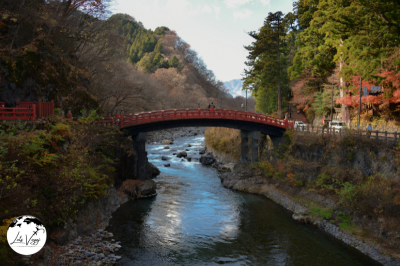
Shinkyo Bridge, with its distinctive vermilion color arching over the Daiya River, serves as Nikko’s sacred entrance. According to legend, a god crossed the river on the back of two serpents, inspiring this elegant structure. While visitors once could only cross the bridge on special occasions, it now welcomes tourists (for a small fee).
The entire Nikko shrine complex earned UNESCO World Heritage status in 1999, recognizing its cultural and historical significance.
Lake Chuzenji

Formed roughly 20,000 years ago when Mount Nantai erupted and blocked the Daiya River. This serene body of water, sitting at an elevation of 1,269 meters, provides a natural respite and serves as a hub for outdoor activities. The lake changes dramatically with the seasons—vibrant greens in summer, fiery foliage in autumn, and ice-rimmed shores in winter.
Kegon Falls
Kegon Falls plunges 97 meters from Lake Chuzenji, ranking among Japan’s three most beautiful waterfalls. Viewing platforms allow visitors to experience the falls from multiple perspectives, with the thundering cascade creating a sensory experience that complements the visual spectacle.
Ryuzu Falls
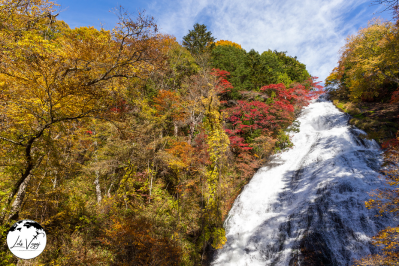
Ryuzu Falls (Dragon’s Head Falls), named for its resemblance to a dragon’s head, offers one of Japan’s most picturesque autumn foliage viewing spots when the surrounding trees turn brilliant shades of red and orange.
Seasonal Highlights and Special Experiences
Nikko transforms dramatically throughout the year, offering distinctive experiences each season:
Spring (April-May) brings cherry blossoms to lower elevations, while higher areas still maintain winter conditions—a fascinating climatic contrast within a single region.
Summer (June-August) offers pleasant temperatures (typically 10°C cooler than Tokyo) and lush greenery. This season provides the most reliable weather for hiking and outdoor activities.
Autumn (October-November) showcases Japan’s famous koyo (autumn foliage) at its most spectacular. The progression of colors begins at higher elevations in early October and gradually descends, creating weeks of viewing opportunities. This represents Nikko’s most popular season, requiring advance reservations.
Winter (December-March) transforms Nikko into a serene snowscape. While some mountain areas become inaccessible, the sight of snow-covered shrines creates uniquely photogenic scenes without the crowds of warmer months.
Kōya-san
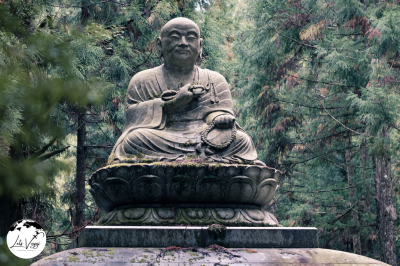
Kōya-san (Mount Kōya) represents one of Japan’s most significant spiritual centers, located in Wakayama Prefecture about 100 kilometers south of Osaka. This mountain settlement has served as the headquarters of Shingon Buddhism for over 1,200 years, creating a unique environment where ancient traditions continue to thrive in a modern world. Let me guide you through this remarkable destination, explaining both its profound religious significance and what visitors can experience today.
Historical and Spiritual Significance
Kōya-san was established in 819 CE by the Buddhist monk Kūkai (posthumously known as Kōbō Daishi), who had studied esoteric Buddhist practices in China before bringing them to Japan. After searching for an ideal location to establish a training center, Kūkai selected this remote mountain plateau because its eight peaks resembled a lotus flower—a sacred symbol in Buddhism. The site was intended as a place where monks could practice away from worldly distractions, focusing entirely on spiritual development.
Over the centuries, Kōya-san developed into a vast temple complex with over 100 temples at its peak. Today, approximately 117 temples remain, with about 52 offering lodging to visitors in a practice known as shukubo (temple stays). The entire religious complex was designated a UNESCO World Heritage Site in 2004 as part of the “Sacred Sites and Pilgrimage Routes in the Kii Mountain Range.”
Danjogaran Temple Complex
The Danjogaran represents the spiritual center of Kōya-san and consists of about 20 religious structures clustered together. Key buildings within this complex include:
The Konpon Daitō (Great Pagoda), a striking vermilion two-story pagoda standing 48.5 meters tall. The interior features a three-dimensional mandala with statues of eight Buddhist deities arranged around a central image of Dainichi Nyorai (Vairocana Buddha). The structure symbolizes the central doctrine of Shingon Buddhism—that Dainichi Nyorai represents the cosmic Buddha from whom all things emanate.
The Kondō (Golden Hall), which serves as the complex’s main hall for ceremonies and houses important Buddhist statues. Though rebuilt after fires multiple times throughout history, it maintains the architectural style of the Edo period.
The Miedo Hall, dedicated to Kōbō Daishi himself. This structure houses a famous portrait of the founder said to have been painted by his own hand. Lanterns inside have supposedly remained lit continuously since his death in 835 CE, symbolizing his eternal presence.
The Saito (Western Pagoda) and Tōtō (Eastern Pagoda), which complement the Konpon Daitō and represent different aspects of Buddhist cosmology. Together, these structures create a physical representation of Shingon Buddhist principles.
Okunoin Cemetery
Okunoin represents Japan’s largest cemetery and one of its most sacred sites. The cemetery extends through an ancient forest of towering cedar trees, creating an atmosphere of profound tranquility and spiritual gravity. Over 200,000 graves and memorial monuments line the 2-kilometer path leading to Kōbō Daishi’s mausoleum, where he is believed not to have died but to have entered eternal meditation awaiting the future Buddha.
Notable features of Okunoin include:
The Ichinohashi (First Bridge), which marks the traditional entrance to the cemetery. Visitors customarily bow before crossing to acknowledge they’re entering sacred space.
The Gokusho Offering Hall, where monks perform daily rituals offering food and prayers to the souls of the deceased.
The Gobyōbashi (Bridge to the Mausoleum), beyond which photography is prohibited and visitors are expected to refrain from eating, drinking, or casual conversation out of respect.
The Tōrōdō (Lantern Hall), containing thousands of lanterns that have been kept burning for centuries. Two of these—placed directly in front of the mausoleum—are said to have been burning continuously since Kōbō Daishi entered his eternal meditation.
The Kobo Daishi Gobyo (mausoleum) itself, where visitors can participate in offering prayers and incense. Many believe that prayers offered here hold special power, as Kōbō Daishi is thought to hear all prayers before presenting them to the Buddha.
The cemetery contains graves ranging from ordinary citizens to feudal lords, modern corporations, and even memorial monuments for pests exterminated during building projects (reflecting the Buddhist respect for all forms of life). Walking through Okunoin provides insight into Japanese attitudes toward death and ancestral reverence.
Kongōbuji Temple
As the head temple of Shingon Buddhism, Kongōbuji merits special attention. Key features include:
Exquisite painted fusuma (sliding doors) by artists of the Kano school, depicting landscapes, flora, and fauna in vibrant colors and gold leaf.
The Banryūtei Rock Garden—Japan’s largest rock garden—which uses 140 granite stones arranged to represent two dragons emerging from a sea of clouds to protect the temple.
The temple’s enormous kitchen (Daimon), which historically prepared meals for thousands of monks during religious gatherings.
A collection of treasured Buddhist artifacts, including ancient scrolls, paintings, and ceremonial implements used in esoteric rituals.
Reihokan Museum
This museum houses Kōya-san’s most valuable artistic and historical treasures, displaying them on a rotating basis to protect them from light exposure. The collection includes:
National Treasure-designated Buddhist sculptures from various historical periods Mandala paintings explaining Shingon Buddhist cosmology Ancient ritual implements used in esoteric ceremonies Historical documents related to Kōya-san’s development Artifacts from Kōbō Daishi’s life and travels.
The museum provides essential context for understanding the artistic and cultural dimensions of Shingon Buddhism.
Nyonindō (Women’s Hall)
Historically, women were not permitted to enter Kōya-san proper, and instead had to worship from these halls located at the mountain’s perimeter.
Though these restrictions ended in 1872, the halls remain as important historical sites that tell the story of women’s religious devotion despite institutional limitations.
Kamikōchi

Kamikōchi is one of Japan’s most spectacular natural destinations – a pristine valley nestled in the Northern Japan Alps of Nagano Prefecture. Let me explain what makes this place so special and guide you through the essential experiences it offers.
Understanding Kamikōchi’s Significance
Kamikōchi (神河内, meaning “where gods descend”) lies at an elevation of approximately 1,500 meters in the Azusa River Valley. This remote highland paradise became known to international visitors after British missionary Walter Weston explored the area in the late 19th century, helping to popularize mountaineering in Japan. Today, Kamikōchi serves as the gateway to the Chūbu-Sangaku National Park and represents one of Japan’s most carefully preserved natural environments.
What makes Kamikōchi truly special is Japan’s commitment to maintaining its pristine condition. Private cars are prohibited, and the area closes completely from mid-November to late April to allow nature to recover. This conservation approach has preserved a landscape that appears much as it did centuries ago, creating an increasingly rare opportunity to experience untouched Japanese wilderness.
Kappa Bridge (Kappabashi)
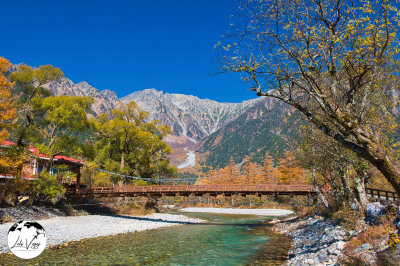
The wooden Kappa Bridge spans the crystal-clear Azusa River and serves as Kamikōchi’s symbolic center. Named after the mythical water creatures said to inhabit Japanese rivers, this bridge offers spectacular views of the surrounding mountains, particularly the iconic pyramid-shaped peak of Mt. Hotaka (Japan’s third-highest mountain). The bridge area functions as the main hub of Kamikōchi, with information centers, restaurants, and lodging nearby.
Taisho Pond (Taishō-ike)
Formed in 1915 when an eruption of nearby Mt. Yakedake dammed the Azusa River, Taisho Pond presents one of Kamikōchi’s most photogenic landscapes. The hauntingly beautiful sight of dead trees standing in the shallow pond against a backdrop of mountains creates an otherworldly scene. On clear, windless mornings, the pond’s surface perfectly mirrors Mt. Yakedake—a photographer’s dream.
The pond’s existence represents nature’s constant state of transformation, as the landscape continues to evolve after the volcanic event that created it. Scientists estimate that the pond will eventually fill with sediment and disappear, making each visit a chance to witness a temporary natural wonder.
Myojin Pond (Myōjin-ike)
Located about a 1.5-hour walk north of Kappa Bridge, Myojin Pond holds special religious significance as the sacred home of the Hotaka Shrine. The pond consists of two sections: the larger pond is open to all visitors, while the smaller pond can only be viewed from the shrine grounds (requiring a small entrance fee). According to local beliefs, the pond’s crystal-clear waters serve as a mirror for the gods to check their appearance.
The shrine hosts a traditional boat ceremony each October where colorfully decorated vessels are rowed across the pond as offerings to the mountain gods. This ceremony has remained largely unchanged for centuries and represents the deep connection between Kamikōchi’s natural environment and Japan’s indigenous spiritual practices.
Wetlands and Marshes
Kamikōchi contains several unique wetland ecosystems. The Tashiro Marsh and Tokusawa Marsh areas showcase diverse alpine plant species and provide critical habitats for rare wildlife. In spring, these areas burst with colorful alpine flowers, while autumn brings a spectacular display of golden grasses and reddish hues.
These wetlands represent crucial ecological zones where water from the surrounding mountains collects before feeding into the Azusa River. The boardwalks built through these sensitive areas allow visitors to experience these delicate ecosystems without disturbing them.
Wildlife Encounters
Kamikōchi’s protected status has allowed wildlife to thrive. While hiking, you might encounter:
Japanese Macaques: Troops of these wild monkeys frequently appear near Kappa Bridge and along the main trails. They’ve become accustomed to humans but remember they are wild animals—observe from a respectful distance.
Japanese Serow: This goat-antelope (designated a special natural monument of Japan) occasionally appears on the mountain slopes, particularly in early morning or evening hours.
Bird Life: The area hosts diverse bird species including the colorful Varied Tit, Japanese Grosbeak, and if you’re lucky, the spectacular Copper Pheasant.
Asiatic Black Bears: While rarely seen by casual visitors, bears inhabit the mountains surrounding Kamikōchi. The visitor center provides current information on bear activity, and hikers should make noise on trails to avoid surprising these powerful animals.
Understanding the ecosystem’s fragility helps explain the strict regulations in place, including prohibitions against feeding wildlife, collecting plants, or leaving the established trails in sensitive areas.
Seasonal Highlights
Each season transforms Kamikōchi dramatically:
Late April/Early May (Opening Season): Snow still clings to the mountains while early spring wildflowers emerge in the valley. Visitor numbers are lower, and accommodations more available. The contrast between snowy peaks and the greening valley creates distinctive photographic opportunities.
June: The rainy season brings lush greenery and flowing streams, with fewer visitors willing to brave occasional downpours. However, after rain, the mountains often emerge with spectacular clarity against washed clean skies.
July/August: Peak season brings comfortable temperatures, abundant wildlife activity, and the valley in full bloom. This is the most crowded time but also when Kamikōchi’s ecosystem displays its full vitality. The extended daylight hours allow for longer hikes.
September/October: Autumn foliage transforms the valley into a canvas of red, orange, and gold, typically peaking in mid-October. The contrast of colorful leaves against the river and mountains creates Kamikōchi’s most picturesque season. Morning frost creates magical scenes as sunlight gradually fills the valley.
Early November: The closing season offers a unique experience as visitor numbers dwindle and the valley prepares for winter. Early snowfall might dust the landscape while hiking remains possible. The tranquility of this period provides a glimpse of how Kamikōchi might have appeared before tourism developed.
Each seasonal visit offers a completely different experience of Kamikōchi, with changing light, vegetation, wildlife activity, and water levels in the river and ponds. Many Japanese nature enthusiasts make annual pilgrimages to witness these seasonal transformations.
Must do Activities in Japan
Japan offers a wealth of unique experiences that change dramatically with the seasons. Understanding the seasonal rhythm of Japan will help you plan a more meaningful visit, as many cultural activities and natural phenomena are closely tied to specific times of year.
Spring (March-May)
Spring in Japan is perhaps the most celebrated season, famous worldwide for its beautiful natural displays and festive atmosphere.
Cherry Blossom Viewing (Hanami): The fleeting beauty of cherry blossoms holds profound cultural significance in Japan. The blossoms typically bloom from late March to early April, starting in the south and moving northward. Popular viewing spots include Ueno Park in Tokyo, Maruyama Park in Kyoto, and Hirosaki Castle in Aomori, where over 2,600 cherry trees create a spectacular display. Many Japanese participate in hanami parties, gathering under blooming trees for food and drinks.
Spring Festivals: The Takayama Spring Festival in Gifu Prefecture (April 14-15) features ornate festival floats (yatai) with intricate mechanical puppet shows. The Kanda Matsuri in Tokyo (held in odd-numbered years in mid-May) is one of Japan’s three greatest festivals, with portable shrines (mikoshi) carried through the streets.
Ashikaga Flower Park: Visit to see the magnificent wisteria tunnels in full bloom from mid-April to mid-May. The evening illuminations create a magical atmosphere as twilight descends.
Sumo Tournament: The May Grand Sumo Tournament in Tokyo offers a chance to experience Japan’s national sport during pleasant weather.
Summer (June-August)
Summer brings vibrant festivals and outdoor adventures, though it can be hot and humid in many regions.
Climb Mt. Fuji: The official climbing season runs from early July to mid-September. Reaching the summit of Japan’s iconic 3,776-meter mountain offers breathtaking views and a profound sense of accomplishment. Many climbers begin their ascent at night to witness the sunrise (goraiko) from the peak.
Summer Festivals (Matsuri): These celebrations are central to Japanese cultural life. The Gion Matsuri in Kyoto spans the entire month of July, with the grand procession of floats (Yamaboko Junko) on July 17th. The Aomori Nebuta Festival features enormous illuminated paper floats depicting warriors and mythological beings. The Awa Odori dance festival in Tokushima sees thousands of dancers moving through the streets.
Fireworks Displays (Hanabi): The Japanese elevate fireworks to an art form. The Sumida River Fireworks in Tokyo and the Nagaoka Festival display tens of thousands of fireworks in intricate patterns. These events often have centuries of history behind them.
Obon Festival: This Buddhist festival honoring ancestors takes place in mid-August in most regions. The Bon Odori dances performed during this time vary by region and offer insight into local traditions and community bonds.
Beaches and Islands: Escape to Okinawa’s pristine beaches with coral reefs perfect for snorkeling, or explore the art islands of the Seto Inland Sea like Naoshima, where contemporary art museums are integrated into the natural landscape.
Autumn (September-November)
Autumn in Japan brings mild temperatures and spectacular foliage, making it ideal for outdoor exploration.
Autumn Leaf Viewing (Momijigari): The Japanese appreciation for autumn colors rivals their love of cherry blossoms. Prime locations include Kyoto’s temples (particularly Tofuku-ji and Eikando), Nikko’s lake region, and Korankei Gorge near Nagoya. The colors typically appear in mid-October in northern Japan and reach Kyoto and Tokyo by mid-November.
Harvests and Food Festivals: Autumn is a time to celebrate the bounty of the land. The Takayama Autumn Festival (October 9-10) includes a food market showcasing local specialties. Throughout the country, you’ll find seasonal delicacies like matsutake mushrooms, chestnuts, and newly harvested rice.
Kurama Fire Festival: Held on October 22nd near Kyoto, this dramatic night festival features locals carrying huge flaming torches through the mountain village, creating an otherworldly atmosphere as they proceed to Yuki Shrine.
Traditional Arts Performances: Autumn is traditionally considered the best season for appreciating Japanese arts. Look for special performances of Noh theatre, which often takes place outdoors during this season, allowing the natural setting to become part of the performance.
Sumo Tournament: The November Grand Sumo Tournament in Fukuoka offers a chance to see Japan’s national sport in a different region.
Winter (December-February)
Winter transforms Japan with snow-covered landscapes in the north and illuminations in the cities, while offering unique cultural experiences.
Hot Springs (Onsen): Winter is the perfect time to experience Japan’s hot spring culture. The snow monkeys bathing in the natural hot springs of Jigokudani Monkey Park provide an iconic winter image. Traditional onsen towns like Kusatsu, Hakone, and Noboribetsu offer therapeutic waters and ryokan (traditional inns) where you can experience kaiseki cuisine.
Winter Illuminations: Japan’s winter light festivals are among the world’s most spectacular. The Kobe Luminarie commemorates the 1995 earthquake with intricate Italian-style light structures. Nabana no Sato in Mie Prefecture creates enormous light tunnels and animated displays using millions of LED bulbs.
Snow Festivals: The Sapporo Snow Festival in February showcases massive snow and ice sculptures, some standing over 15 meters tall. The Otaru Snow Light Path Festival creates a more intimate atmosphere with small snow lanterns lining the canal.
Skiing and Snowboarding: Hokkaido’s powder snow is renowned worldwide. Niseko offers world-class facilities with multilingual staff, while areas like Hakuba in the Japanese Alps combine excellent skiing with traditional Japanese culture.
New Year Traditions: Experience Hatsumode (the first shrine visit of the year), temple bell ringing ceremonies (Joya no Kane), and special New Year’s foods (Osechi Ryori). The normally reserved Japanese culture becomes more open during this important holiday.
Best time to visit Japan
Japan experiences four distinct seasons, each offering unique attractions, cultural experiences, and natural beauty. The best time to visit largely depends on your personal interests, tolerance for different weather conditions, and what aspects of Japanese culture you hope to experience.
Spring (March to May)
Spring represents perhaps Japan’s most celebrated season, famous worldwide for its cherry blossom (sakura) season.
Cherry Blossom Season (Late March to Early April)
The sakura bloom creates a magical atmosphere as the country transforms under canopies of delicate pink and white flowers. This natural phenomenon has deeply influenced Japanese culture for centuries, embodied in the practice of hanami (flower viewing), where people gather under blooming trees for picnics and celebrations.
The cherry blossoms begin in the southern regions and gradually move northward:
- Late March: Kyushu, Shikoku, and parts of Honshu including Tokyo and Kyoto
- Early-mid April: Northern Honshu and southern Hokkaido
- Late April to early May: Northern Hokkaido
Beyond cherry blossoms, spring offers other advantages:
- Comfortable temperatures (generally 10-20°C/50-68°F)
- Other beautiful blooms like plum blossoms (February-March) and wisteria (late April-May)
- Spring food specialties featuring seasonal vegetables and bamboo shoots
Late Spring (Late April to May)
After the cherry blossom peak, Japan enters a particularly pleasant period:
- Reduced tourist crowds
- Lush green landscapes
- Generally lower accommodation prices
- Golden Week (late April to early May) is a major holiday period when Japanese tourists travel domestically, creating another busy period to potentially avoid
Summer (June to August)
Summer presents a mix of challenges and unique opportunities for visitors.
Early Summer (June)
June marks the rainy season (tsuyu) in most of Japan:
- Frequent rainfall, typically as afternoon showers rather than all-day downpours
- Hydrangeas bloom spectacularly during this period
- Fewer tourists than spring or autumn
- Lower accommodation prices
Mid-Summer (July-August)
High summer brings distinct experiences:
- Hot and humid conditions (often exceeding 30°C/86°F with high humidity)
- Vibrant festival season featuring spectacular events like Kyoto’s Gion Matsuri, Osaka’s Tenjin Matsuri, and Aomori’s Nebuta Matsuri
- Fireworks displays (hanabi) throughout the country
- Mount Fuji’s official climbing season (July to early September)
- Beach opportunities in Okinawa and other coastal areas
- Verdant mountain destinations like Kamikōchi and Nikko offer respite from urban heat
Autumn (September to November)
Autumn rivals spring as Japan’s most visually stunning season.
Early Autumn (September)
September presents a transitional period:
- Lingering summer heat gradually giving way to milder temperatures
- Typhoon season, particularly in southern regions, requiring flexible travel plans
- Diminishing crowds as summer vacation ends
- The beginning of the rice harvest, with golden fields creating picturesque rural landscapes
Mid to Late Autumn (October to November)
This period showcases Japan’s famous autumn foliage (koyo):
- The color change begins in Hokkaido in late September
- Moves gradually southward, reaching Kyoto and Tokyo by mid-November
- Continues in southern regions into early December
- Creates spectacular scenery with red maples, golden ginkgos, and other colorful trees
- Particularly magnificent in mountainous areas like Nikko, the Japan Alps, and temples around Kyoto
Autumn advantages include:
- Comfortable temperatures (15-20°C/59-68°F)
- Clear, crisp air offering excellent visibility for mountain views
- Seasonal cuisine featuring mushrooms, chestnuts, and hearty dishes
- Rich cultural activities as the traditional arts season begins
Like cherry blossom season, popular autumn foliage viewing locations become crowded, though the longer duration of the autumn colors (typically 2-3 weeks in any location) helps distribute visitors somewhat.
Winter (December to February)
Winter reveals a less-visited but equally fascinating Japan.
Early Winter (December)
December marks the beginning of the winter season:
- Crisp, cool weather in major cities (Tokyo averages 5-12°C/41-54°F)
- Winter illuminations and decorative lights transform urban areas
- Year-end traditions including hatsumode (first shrine visit of the year)
- Relatively quiet tourist period before the New Year
Mid-Winter (January-February)
The heart of winter offers distinct experiences:
- Snow covers northern Japan and the Japan Alps
- World-class skiing and snowboarding in Hokkaido (Niseko) and Nagano
- Snow festivals like Sapporo’s Snow Festival (early February)
- Snow monkeys bathing in hot springs in Jigokudani
- Clear days offering the best views of Mount Fuji
Regional Considerations
Japan’s elongated geography creates significant climate variations that can influence the best visiting time:
Hokkaido
- Best in summer (July-August) for comfortable exploration
- Winter (December-February) for outstanding snow sports
- Brief but beautiful autumn foliage (late September-early October)
- Late spring (May) for wildflowers but possible lingering snow
Tokyo and Central Japan
- Spring (late March-April) and autumn (November) offer most comfortable weather
- Summer is hot and humid but culturally vibrant
- Winter is mild enough for comfortable sightseeing
Kyoto and Western Japan
- Similar to Tokyo but can experience more intense summer heat
- Protected by mountains, autumn colors typically last longer
- Spring and autumn represent optimal visiting periods
Okinawa and Southern Islands
- Winter (December-February) offers comfortable temperatures for beach activities
- Summer provides warmest water but with high humidity and typhoon risk
- Spring (March-May) balances comfortable temperatures with lower rainfall
Considerations Beyond Weather
Japanese Holiday Periods
Several periods see increased domestic travel, affecting prices and availability:
- New Year (December 29-January 3)
- Golden Week (April 29-May 6)
- Obon (mid-August)
- Silver Week (mid-September)
Safety tips for Japan travel
Emergency Contacts
- General Emergency Number: 110 (Police)
- Ambulance and Fire: 119
- Japan Helpline (24/7 in English): 0570-000-911
- Tokyo Metropolitan Health and Medical Information Center: 03-5285-8181
- Japan National Tourism Organization (JNTO) Tourist Information Center: 03-3201-3331
Natural Disaster Preparedness
Japan experiences frequent earthquakes, typhoons, and occasional volcanic activity:
- Download disaster alert apps like “Safety tips” (offered in multiple languages)
- Familiarize yourself with evacuation routes in your accommodation
- Follow instructions from local authorities during emergencies
- For earthquake safety: drop, cover, and hold on under sturdy furniture
General Safety Tips
Japan has a very low crime rate, but standard precautions are still recommended:
- Keep your passport secure (carrying a copy is sufficient for daily activities)
- Be aware of your surroundings in crowded areas and nightlife districts
- Register with your country’s embassy or consulate in Japan
- Have comprehensive travel insurance that covers medical emergencies and natural disasters
Health Considerations
- Japan’s healthcare system is excellent but can be expensive without insurance
- Bring any necessary prescription medications with proper documentation
- Tap water is safe to drink throughout the country
- Be prepared for extreme heat and humidity if visiting in summer
Transportation Safety
- Traffic moves on the left side of the road
- Always use designated pedestrian crossings
- Follow all transportation rules and signage
- Be cautious during rush hour in major cities due to crowding
Cultural Considerations
- Follow local customs and etiquette
- Remove shoes when required in traditional establishments
- Be mindful of quiet behavior in public transportation
- Respect rules at temples, shrines, and historical sites
This information is based on guidance typically provided by official sources, but for the most current information, I recommend checking:
- Japan National Tourism Organization (JNTO): www.japan.travel
- Your country’s travel advisory for Japan
- Ministry of Foreign Affairs of Japan: www.mofa.go.jp/j_info/visit/index.html
Transportation in Japan
Japan boasts one of the world’s most efficient and extensive transportation networks. The system is renowned for its punctuality, cleanliness, and technological innovation.
Japan Railways (JR) operates the primary intercity rail network, including the famous Shinkansen (bullet trains) that connect major cities at speeds up to 320 km/h. In urban areas, private railway companies supplement JR lines with extensive commuter networks.
Major cities feature comprehensive subway systems, with Tokyo’s being the most extensive. Buses serve as important connectors in both urban and rural areas where train service may be limited.
Taxis are readily available but relatively expensive compared to public transit. For tourists, the Japan Rail Pass offers unlimited travel on JR lines and is an economical option for visitors planning to explore multiple regions.
Major Transportation Hubs in Indonesia
Airports
Tokyo Area
- Narita International Airport (NRT): Located in Chiba Prefecture, about 60km from central Tokyo. This remains Japan’s primary international gateway despite being farther from the city center. Connected to Tokyo by the Narita Express (N’EX) train, Keisei Skyliner, limousine buses, and regular train services.
- Haneda Airport (HND): Officially Tokyo International Airport, located just 14km from central Tokyo. Originally primarily a domestic airport, it now handles numerous international flights and is preferred by many travelers due to its proximity to the city. Connected by Tokyo Monorail and Keikyu Line trains.
Other Major International Airports
- Kansai International Airport (KIX): Built on an artificial island in Osaka Bay, serving the Kansai region (Osaka, Kyoto, Kobe). Connected to the mainland by the Haruka Express train and airport limousine buses.
- Chubu Centrair International Airport (NGO): Serving Nagoya and the Chubu region, also built on an artificial island. Connected to Nagoya via the Meitetsu Airport Line.
- New Chitose Airport (CTS): The main gateway to Hokkaido, located near Sapporo. Connected to Sapporo by the JR rapid train service.
- Fukuoka Airport (FUK): The main gateway to Kyushu, unusually located very close to downtown Fukuoka (only 2km). Connected directly to the city center by subway.
Major Train Stations and Railway Companies in Japan
Major Railway Companies
JR Group (Japan Railways)
The JR Group consists of six regional companies that operate the majority of Japan’s intercity rail service:
- JR East – Serves Tokyo, northeastern Honshu
- JR Central – Serves central Japan, operates the Tokaido Shinkansen
- JR West – Serves western Honshu including Osaka, Kyoto
- JR Kyushu – Serves Kyushu island
- JR Hokkaido – Serves Hokkaido island
- JR Shikoku – Serves Shikoku island
Major Private Railway Companies
Several private railway companies operate significant networks, particularly in metropolitan areas:
- Tokyo Metro (Tokyo subway system)
- Toei Subway (Tokyo metropolitan government subway)
- Tokyu Corporation (Tokyo area)
- Keio Corporation (Tokyo area)
- Odakyu Electric Railway (Tokyo area)
- Hankyu Railway (Osaka/Kyoto/Kobe area)
- Hanshin Electric Railway (Osaka/Kobe area)
- Kintetsu Railway (Osaka/Kyoto/Nara/Nagoya area)
- Keihan Electric Railway (Kyoto/Osaka area)
Major Train Stations
Tokyo Metropolitan Area
- Tokyo Station – Main intercity terminal, Shinkansen hub
- Shinjuku Station – World’s busiest station by passenger numbers
- Shibuya Station – Major commercial and entertainment district hub
- Ikebukuro Station – Major commuter and shopping district hub
- Shinagawa Station – Important Shinkansen and commuter rail station
- Ueno Station – Major terminal for northern Japan routes
Other Major Cities
- Osaka Station/Umeda – Main terminal in Osaka
- Shin-Osaka Station – Shinkansen station in Osaka
- Kyoto Station – Main station in Kyoto, cultural tourism hub
- Nagoya Station – Main terminal in Nagoya, Shinkansen hub
- Hakata Station – Main station in Fukuoka, Kyushu Shinkansen terminal
- Sapporo Station – Main station in Hokkaido’s capital
- Kanazawa Station – Important station on the Hokuriku Shinkansen line
The Japanese railway system is renowned for its punctuality, efficiency, and extensive coverage, connecting virtually all urban and rural areas throughout the country.
Bus Terminals
Bus terminals serve as important hubs particularly for reaching areas not directly served by train:
- Shinjuku Expressway Bus Terminal (Busta Shinjuku): Japan’s largest bus terminal, located above Shinjuku Station, serving highway buses to destinations throughout Japan.
- Tokyo Station Yaesu Exit Bus Terminal: Major departure point for highway buses from central Tokyo.
- Osaka Umeda (Hankyu Bus Terminal): Main highway bus hub in Osaka.
- Kyoto Station Bus Terminal: Located directly in front of Kyoto Station, serving both long-distance and city buses.
Port Facilities
Japan’s island geography means ferry terminals play an important role in the transportation network:
- Yokohama Port: Japan’s largest seaport, serving both passenger and cargo vessels.
- Kobe Port: Historic port with ferry connections to various domestic destinations and some international routes.
- Hakata Port: Important gateway for ferries connecting to South Korea and other Asian destinations.
- Tokushima Port: Key ferry terminal connecting Shikoku with mainland Japan.
These transportation hubs form the backbone of Japan’s interconnected transit system, allowing for seamless transfers between different modes of transportation and enabling efficient travel throughout the country.
Tokyo
Understanding how to get around Japan begins with mastering Tokyo’s comprehensive yet complex public transportation system. As one of the world’s most efficient urban transit networks, Tokyo’s interconnected web of trains, subways, and buses can take you virtually anywhere in this sprawling metropolis, though it might seem overwhelming to first-time visitors.
Tokyo’s transportation system represents Japanese efficiency at its finest—clean, punctual, and remarkably extensive. With over 60 subway and train lines operated by multiple companies, 13 subway lines, numerous bus routes, and even water buses traversing Tokyo Bay and its rivers, you have countless options for reaching your destination.
The Railway Network: Understanding the Players
Tokyo’s rail system can initially seem overwhelming because it’s operated by multiple companies that function as an integrated network:
JR East (Japan Railways)
The JR Yamanote Line forms the backbone of Tokyo’s railway system, running in a loop around central Tokyo and connecting most major districts. This light green line on maps is often the first orientation point for visitors. Key JR lines include:
- Yamanote Line: The circular loop connecting Tokyo, Shinjuku, Shibuya, Ikebukuro and other major centers
- Chuo Line: The orange line bisecting the Yamanote loop east to west
- Keihin-Tohoku Line: The blue north-south line paralleling parts of the Yamanote
- Sobu Line: The yellow line connecting eastern Tokyo and Chiba Prefecture
JR trains are distinguished by their typically white exterior with colored stripes indicating the line.
For more details visit: https://www.jreast.co.jp/multi/en/
Tokyo Metro and Toei Subway
These two subway systems form the underground backbone of Tokyo transportation:
- Tokyo Metro: Operates 9 lines denoted by letter codes and colors (e.g., Ginza Line is G and orange, Marunouchi Line is M and red)
- Toei Subway: Operates 4 lines, also with designated letters and colors
Together, these 13 subway lines create a comprehensive underground network reaching most parts of central Tokyo. The systems are separately operated, which matters for ticketing purposes.
For more details about Metro visit: https://www.tokyometro.jp/en/index.html
For more details about Subway visit: https://www.kotsu.metro.tokyo.jp/eng/
Private Railway Companies
These companies operate lines that typically start at a terminal within the Yamanote loop and extend outward to the suburbs:
- Tokyu: Serving southwest areas including Shibuya to Yokohama
For more details visit: https://www.tokyu.co.jp/global/
- Keio: Serving western areas from Shinjuku
For more details visit: https://www.keio.co.jp/global/
- Odakyu: Connecting Shinjuku to southwestern suburbs
For more details visit: https://www.odakyu.jp/english/
- Seibu: Operating from Ikebukuro to northwestern areas
For more details visit: https://www.seiburailway.jp/en/
- Tobu: Connecting Asakusa and Ikebukuro to northern areas
For more details visit: https://www.tobu.co.jp/en/
- Keisei: Linking eastern Tokyo and Narita Airport
For more details visit: https://www.keisei.co.jp/keisei/tetudou/skyliner/us/index.php
Understanding Tokyo’s Fare System
Tokyo’s transportation uses a distance-based fare system. The longer your journey, the more you pay. Here’s how it works:
Single Tickets
- Locate your destination on the fare map above the ticket machines
- Note the fare required to reach that station
- Purchase a ticket for that amount using the machine
- Insert your ticket at the entry gate (it will be retained)
- If traveling between different systems (e.g., JR to Metro), you’ll need to purchase separate tickets or use an IC card
The ticket machines have an English option and accept both cash and cards. They can seem complicated at first but become intuitive with practice.
IC Cards: The Essential Travel Tool
The most convenient way to navigate Tokyo is with an IC (Integrated Circuit) card, which eliminates the need to purchase individual tickets for each journey:
- Suica: Issued by JR East
- PASMO: Issued by Tokyo Metro and private railways
These cards are functionally identical—you can use either one across all train and bus systems in Tokyo and most major cities in Japan. Here’s why they’re essential:
- Convenience: Just tap in and out at station gates; the correct fare is automatically calculated and deducted
- Transfers: Simplified transfers between different railway companies
- Small discounts: IC card fares are slightly cheaper than paper tickets
- Secondary uses: Can be used at convenience stores, vending machines, and many shops
- Reloadable: Easily add value at any station ticket machine, convenience store, or fare adjustment machine
To get an IC card, purchase one at any major station from a ticket machine or manned booth. The card itself costs 1,000 yen (500 yen deposit plus 500 yen initial credit). You can top up in denominations starting from 1,000 yen.
Tokyo Metro and Subway Navigation
The subway system is often the most efficient way to travel within central Tokyo:
Finding Your Way
Stations use a consistent color-coding and numbering system to help with navigation:
- Each line has a letter code and color (e.g., Ginza Line is G and orange)
- Each station has a number (e.g., Shimbashi on the Ginza Line is G08)
- Signs are color-coded based on the line they refer to
- Exits are numbered and often include information about nearby landmarks
Most subway stations have detailed area maps near the exits showing the surrounding blocks with major buildings and landmarks clearly marked.
Making Transfers
Transfer stations are clearly marked, with signs showing the walking route between lines. Some transfers can be lengthy—up to 5-10 minutes of walking at major interchange stations like Shinjuku or Tokyo Station. Signs indicate the approximate walking time for longer transfers.
Bus System
While trains and subways form the primary transportation network, buses serve as valuable complements, especially for areas between train stations or neighborhoods less covered by rail:
Toei Buses
The main city bus network is operated by Toei (the same company that runs some subway lines). These green buses run numerous routes throughout Tokyo, with bus stops marked by green signs showing route numbers and destinations.
For more details visit: https://www.kotsu.metro.tokyo.jp/
How to Ride City Buses
Tokyo city buses typically follow these procedures:
- Board from the middle or rear door
- Take a numbered ticket when boarding (this shows where you got on)
- A display at the front shows the current fare for each ticket number (increases as the bus travels)
- Pay as you exit from the front door, either with your IC card or exact change
- Push the stop button when approaching your desired stop
Some newer bus routes use a flat fare system, where you pay a fixed amount when boarding from the front door.
Bus Information
Bus stops have route maps, but they’re often only in Japanese. The Japan Transit Planner app or Google Maps can help identify which bus routes to take. Announcements on buses are typically in Japanese and sometimes English.
Taxis: When and How to Use Them
Taxis in Tokyo are clean, safe, and plentiful, though relatively expensive compared to public transportation:
When to Consider Taxis
- When carrying heavy luggage
- After the last trains (approximately midnight to 5 AM)
- When traveling in groups of 3-4 people (making the cost more reasonable per person)
- For short distances in bad weather
- When you need door-to-door service
Starting fare is typically around 410-420 yen for the first 1.052 kilometers, then approximately 80-90 yen for each additional 237 meters.
Special Passes and Discounts
For Visitors
- Tokyo Subway Ticket: Unlimited rides on Tokyo Metro and Toei Subway lines (24, 48, or 72 hours)
- Tokyo Free Kippu: One-day pass covering JR trains, Metro and Toei subways, and buses within central Tokyo
- JR Tokyo Wide Pass: Three-day unlimited travel on JR lines in the greater Tokyo area
Digital Assistance
Several apps can make Tokyo navigation much easier:
- Japan Transit Planner: Comprehensive route planning with accurate timetables
- Tokyo Subway Navigation: Official app from Tokyo Metro
- Google Maps: Works well in Tokyo with accurate transit information
- JR East App: Provides real-time train information and platform guides for JR stations
Koyoto
Welcome to Kyoto, the cultural heart of Japan where ancient traditions meet modern convenience. Navigating this historic city is made seamless through its well-organized public transportation system, an essential component of understanding How to Get Around Japan. While not as extensive as Tokyo’s network, Kyoto’s buses, subways, and trains provide efficient access to its world-renowned temples, shrines, and traditional neighborhoods, allowing visitors to experience the city’s 1,200 years of history without transportation challenges.
Kyoto’s transportation network centers on its comprehensive bus system, with color-coded routes connecting major attractions and residential areas. The Kyoto City Bus network features the convenient visitor-oriented routes 100 and 101, circling the most popular destinations. The subway system, though limited to just two lines, offers quick transit between the central station and northern districts.
For more details visit: https://www2.city.kyoto.lg.jp/kotsu/webguide/en/
https://kyoto.travel/en/info/transportation/index.html
Understanding Kyoto’s Layout
Before diving into transportation options, it helps to understand that Kyoto is laid out in a grid pattern, similar to a chessboard. The city is relatively flat (except for the eastern and western edges) and compact compared to Tokyo, with many key attractions concentrated in specific areas. This grid layout makes the city relatively easy to navigate once you grasp the basics.
The Kamo River runs north-south through the city, serving as a natural dividing line. Many locals use directions like “Kawaramachi” (the downtown area along the river) or “Higashiyama” (eastern mountains) as reference points.
The Bus Network: Kyoto’s Transportation Backbone
Unlike many major Japanese cities where railways dominate, Kyoto’s bus system forms the backbone of public transportation. This is partly due to the city’s conservation efforts to maintain its historical character by limiting underground construction.
City Bus System
Kyoto City operates an extensive network of buses that reach virtually every tourist attraction:
- Bus Types and Routes:
- Green and White Buses (Kyoto City Bus): These are the main city buses that cover central Kyoto.
- Raku Bus (Routes 100, 101, 102): Special tourist-oriented buses connecting major sightseeing spots.
- Kyoto Bus (Blue and White): These buses primarily serve the outskirts and suburbs.
- Understanding Bus Routes:
- Bus stops display route maps with all stops listed
- Electronic displays at major stops show waiting times
- The most useful bus routes for tourists include:
- Route 100: Circular route connecting Kyoto Station with eastern Kyoto (Ginkakuji, Kiyomizudera)
- Route 101: Western Kyoto loop (Kinkakuji, Ryoanji)
- Route 102: Northern Kyoto (Kitano Tenmangu, Kinkakuji)
- Route 205: Connects Kyoto Station with downtown and Gion
- For more details visit: https://www2.city.kyoto.lg.jp/kotsu/busdia/keitou/keitou.htm
Subway System: Fast Travel on Limited Routes
Kyoto’s subway system is much smaller than Tokyo’s, with just two lines, but these lines provide fast travel through the city center:
For more details visit: https://www2.city.kyoto.lg.jp/kotsu/tikadia/tikatime.htm
Karasuma Line (North-South)
- Runs from Kyoto Station northward under Karasuma Street
- Connects major areas including downtown (Shijo), the Imperial Palace area (Marutamachi), and northern Kyoto
- Marked in green on maps
- Most useful for reaching downtown, Nijo Castle, and the Imperial Palace
Tozai Line (East-West)
- Runs east-west through the city center
- Connects eastern Kyoto (near Heian Shrine) with western areas (Uzumasa Tenjingawa)
- Marked in red on maps
- Useful for reaching Higashiyama area and Keihan line transfer
Fare System: Distance-based, ranging from 220-350 yen for most journeys within the city. Ticket machines have English options and display fare maps.
JR Lines: Connecting to the Suburbs and Beyond
Japan Railways (JR) operates several lines in Kyoto that are useful for specific destinations:
JR Nara Line
- Runs southeast from Kyoto Station toward Nara
- Useful for reaching Fushimi Inari Shrine (Inari Station, just 5 minutes from Kyoto Station)
- Also serves Uji, famous for tea and the Byodoin Temple
JR Sagano/San-in Line
- Runs west and north from Kyoto Station
- Serves Arashiyama (Saga-Arashiyama Station), one of Kyoto’s most scenic districts
- The scenic Sagano Romantic Train (a separate sightseeing train) operates along this route
JR Biwako Line
- Heads northeast toward Lake Biwa
- Less useful for tourists unless heading to Shiga Prefecture
Private Railways: Accessing Key Tourist Areas
Several private railway companies operate lines that reach important areas not covered by JR or the subway:
Keihan Railway
- Runs north-south along the Kamo River on the east side
- Connects Gion, Shichijo (for Sanjusangendo), and continues to Fushimi
- Extends all the way to Osaka
- Especially useful for reaching Gion/Higashiyama area from downtown
- For more details visit: https://www.keihan.co.jp/travel/en/
Hankyu Railway
- Connects Kyoto with Osaka and Kobe
- The Kyoto Line’s Kawaramachi terminal station is in downtown Kyoto
- Serves the Arashiyama area via the Arashiyama Line
- Often preferred by locals for its comfortable trains and convenient downtown location
- For more details visit: https://www.hankyu.co.jp/en/
Keifuku Randen Tram
- One of Japan’s few remaining streetcar lines
- Connects central Kyoto with Arashiyama in the west
- A charming, nostalgic way to travel with old-fashioned trams
- Consists of two lines: Arashiyama Line and Kitano Line
Eizan Railway
- Runs from Demachiyanagi Station (north-central Kyoto) to northeastern suburbs
- Serves Kurama and Kibune, popular for hiking and natural hot springs
- Especially beautiful during autumn foliage season
- For more details visit: https://eizandensha.co.jp/en/
IC Cards and Day Passes: Maximizing Value
IC Cards
ICOCA, Suica, or PASMO cards work across all transportation systems in Kyoto:
- Purchase at major stations for 2,000 yen (500 yen refundable deposit plus 1,500 yen credit)
- Simply tap when entering and exiting services
- Can be used on buses, subways, and all train lines
- Also accepted at convenience stores and many vending machines
Special Passes for Visitors
- Kyoto City Bus & Subway Pass
- One-day pass: 900 yen
- Two-day pass: 1,700 yen
- Offers unlimited rides on Kyoto city buses and subways
- Available at Kyoto Station, major subway stations, and tourist information centers
- Excellent value if making 4+ trips in a day
- Kyoto Sightseeing Pass
- One-day pass: 1,200 yen (central area) or 1,600 yen (wider area)
- Two-day pass: 2,000 yen (central area) or 2,500 yen (wider area)
- Covers buses, subways, and private railways within specified zones
- The wider area version includes trips to Arashiyama and other outlying attractions
- JR Pass Benefits
- The national Japan Rail Pass covers JR lines in Kyoto
- Useful for trips to Arashiyama, Fushimi Inari, and Nara
- Regional passes like Kansai Area Pass also cover these routes
Walking: The Best Way to Experience Kyoto
Kyoto is an eminently walkable city, and for many areas, walking is not just transportation but part of the experience:
Prime Walking Areas
- Higashiyama: The eastern district from Kiyomizudera to Ginkakuji is perfect for walking
- Philosopher’s Path: A famous cherry-lined canal path connecting Ginkakuji with Nanzenji
- Arashiyama: The bamboo groves and temple area reward unhurried exploration
- Gion: Best experienced on foot to absorb the atmosphere of historic streets
- Kawaramachi-Pontocho: Downtown shopping and dining district along the river
Walking Routes and Considerations
- The numbered streets running east-west make navigation straightforward (Shijo = 4th Street, Gojo = 5th Street)
- During summer (July-August), heat and humidity can make walking strenuous; carry water and use morning hours
- Many temples are within walking distance of each other, forming natural walking circuits
- Kyoto Walking Map guides are available at tourist information centers, highlighting recommended routes
Special Transportation Options
Kyoto Skybus
- Double-decker open-top bus offering 90-minute sightseeing tours
- Departs from Kyoto Station
- Provides unique elevated views of city landmarks
- Advance reservations recommended (2,000 yen for adults)
Rickshaws (Jinrikisha)
- Traditional two-wheeled carts pulled by runners
- Available in historic districts like Arashiyama and Higashiyama
- Expensive (approximately 8,000-12,000 yen for 30 minutes) but offers memorable experience
- Runners often speak basic English and provide commentary about the area.
Transportation Apps and Resources
- Japan Transit Planner: Offers comprehensive route planning specific to Kyoto
- Google Maps: Works well for Kyoto public transportation
- Kyoto City Bus & Subway Map App: Official app with real-time bus locations
- Arukumachi KYOTO: Official Kyoto tourism app with transport information
- Kyoto Transportation Bureau Website: English-language information about routes and schedules (https://www.city.kyoto.lg.jp/kotsu/index.html)
Mount Fuji
Mount Fuji, Japan’s iconic 3,776-meter volcano, attracts millions of visitors annually for climbing, sightseeing, and exploring the surrounding Fuji Five Lakes region. While the mountain itself is a natural wonder, navigating the transportation system around it requires understanding several interconnected networks. This guide provides detailed information about public transportation options for reaching and exploring the Mount Fuji area.
Understanding the Mount Fuji Region
Mount Fuji spans parts of both Yamanashi and Shizuoka Prefectures. The main access points and surrounding areas include:
- Fuji Five Lakes (Fujigoko): The northern side in Yamanashi Prefecture includes Lake Kawaguchi, Lake Yamanaka, Lake Sai, Lake Shoji, and Lake Motosu. This area is popular for sightseeing and serves as a major gateway to climbing routes.
- Hakone: Located to the east, this hot spring resort area offers spectacular views of Mount Fuji across Lake Ashi.
- Gotemba: On the southeastern side, known for its outlet shopping mall and climbing trail.
- Fujinomiya: On the southwestern side in Shizuoka Prefecture, offering another popular climbing route.
- Suruga Bay: The southern coastal area where Mount Fuji can be viewed from the sea.
Getting to Mount Fuji from Major Cities
From Tokyo
- By Express Train (Recommended)
The most convenient route is via the Fuji Excursion limited express train:
- Departs from Shinjuku Station
- Direct service to Kawaguchiko Station (primary gateway to Fuji Five Lakes)
- Travel time: Approximately 2 hours
- Cost: Around 4,000 yen one-way
- Frequency: Several departures daily, but seats require reservations
- For more details visit: https://world.jorudan.co.jp/mln/en/?sub_lang=ja
- By JR Train + Bus
A more economical but time-consuming option:
- Take JR Chuo Line from Tokyo/Shinjuku to Otsuki Station
- Transfer to the Fujikyu Railway Line to Kawaguchiko Station
- Total travel time: 2.5-3 hours
- Cost: Approximately 2,500-3,000 yen one-way
- Suitable for JR Pass holders as the first leg is covered by the pass
- By Highway Bus
A convenient and economical option with multiple providers:
- Buses depart from multiple Tokyo locations (Shinjuku, Tokyo Station, Shibuya)
- Direct service to Kawaguchiko Station and other Fuji Five Lakes locations
- Travel time: 2-2.5 hours (depending on traffic)
- Cost: 1,800-2,500 yen one-way (varies by company and season)
- Providers include Fujikyu, Keio, and JR Buses
- Reservation recommended, especially during climbing season (July-September)
- English booking available through Willer Express: https://willerexpress.com/en/
From Osaka/Kyoto
- By Shinkansen + Bus
The fastest option:
- Take Tokaido Shinkansen to Mishima, Shin-Fuji, or Shizuoka Station
- Transfer to local bus services to reach desired area around Mount Fuji
- Total travel time: 3-4 hours
- Cost: 15,000-18,000 yen one-way (covered partially by JR Pass)
- By Highway Bus
Direct overnight buses are available:
- Depart from Osaka/Kyoto stations
- Arrive at Kawaguchiko Station or Fujisan Station
- Travel time: 8-10 hours
- Cost: 5,000-9,000 yen one-way
- Reservation required
- Comfortable option with reclining seats
From Nagoya
- By Limited Express Train
- Take the Wide View Fuji express train from Nagoya to Kawaguchiko
- Travel time: Approximately 3 hours
- Requires reservation
- Cost: Around 6,000 yen one-way
- By Shinkansen + Local Transportation
- Take Tokaido Shinkansen to Mishima or Shin-Fuji Station
- Transfer to bus services to reach Mount Fuji area
- Total travel time: 2.5-3.5 hours
- Cost: 9,000-12,000 yen one-way
Transportation Around the Mount Fuji Area
Fuji Five Lakes Region (Northern Side)
- Fujikyu Railway
This local railway connects the broader rail network to the Fuji Five Lakes area:
- Runs between Otsuki and Kawaguchiko stations
- Connects with JR Chuo Line at Otsuki Station
- Travel time: 55 minutes from Otsuki to Kawaguchiko
- Cost: 1,140 yen one-way
- Frequency: Hourly service
- Scenic views of Mount Fuji during the journey
- Retro Bus (Kawaguchiko & Saiko)
These distinctive red buses connect major sightseeing spots:
- Three routes: Red Line (Kawaguchiko), Green Line (Saiko), and Blue Line (Aokigahara/Ice Cave)
- Red Line runs every 15 minutes, other lines less frequently
- Cost: 1,500 yen for unlimited day pass, or 150-350 yen per ride
- Stops at major attractions, museums, and cable car stations
- Announcements in Japanese and English
- Official website: https://www.fujikyu.co.jp/en/
Eastern Side (Gotemba/Hakone)
- Hakone Tozan Railway
A scenic mountain railway that is part of the journey to Hakone:
- Runs from Odawara to Gora
- Connects with Odakyu Line from Shinjuku
- Features switchbacks climbing the mountain
- Travel time: 40 minutes from Odawara to Gora
- Cost: 400 yen one-way
- Hakone Ropeway
Provides aerial views of Mount Fuji and the surrounding area:
- Connects Sounzan with Togendai via Owakudani
- Travel time: 30 minutes for the entire route
- Cost: 1,500 yen one-way
- Frequency: Every 15-20 minutes
- Offers spectacular views of Mount Fuji on clear days
- Gotemba Bus Network
Buses connect Gotemba Station with attractions:
- Services to Gotemba Premium Outlets, Subashiri climbing trail, and Hakone
- Frequency varies by route (30-60 minutes)
- Cost: 300-1,200 yen depending on distance
- Timetables available at Gotemba Station information desk
Southern Side (Fujinomiya/Shizuoka)
- Mount Fuji Shizuoka Airport Shuttle
Connects the airport to various Mount Fuji access points:
- Services to Fujinomiya, Fuji City, and Shizuoka City
- Schedules aligned with flight arrivals/departures
- Reservation required
- Cost: 1,000-2,000 yen depending on destination
- Fujisan Shizuoka Bus
Provides service between Shin-Fuji Station and Fujinomiya:
- Connects JR Tokaido Line with Mount Fuji’s southern access points
- Service to Fujinomiya 5th Station (climbing trailhead)
- Frequency: Hourly during climbing season, less frequent off-season
- Cost: 1,000-1,500 yen one-way
Seasonal Bus Services to Climbing Stations
Summer Climbing Season (July-September)
During the official climbing season, special bus services operate to the fifth stations (trailheads):
- Fujisan Express Bus (Fujikyu)
Connects Kawaguchiko Station with Fuji Subaru Line 5th Station (Yoshida Trail):
- Frequent service during climbing season (every 30-60 minutes)
- Travel time: 50-60 minutes one-way
- Cost: 1,540 yen one-way, 2,100 yen round-trip
- Reservation recommended on weekends and during peak season
- Operates from early July to mid-September with extended hours
- Gotemba Trail Buses
Serves the Subashiri and Gotemba climbing routes:
- Departs from Gotemba Station
- Less frequent than Yoshida Trail buses
- Travel time: 60-90 minutes to respective 5th stations
- Cost: 1,500-2,000 yen one-way
- Operates only during climbing season with limited schedules
- Fujinomiya Trail Buses
Connects Fujinomiya Station with Fujinomiya 5th Station:
- Travel time: Approximately 1 hour
- Cost: Around 1,500 yen one-way
- Limited service outside of climbing season
- Reservation recommended during peak periods
Off-Season Access
Outside the official climbing season (October-June):
- Fuji Subaru Line 5th Station still accessible via limited bus service
- Other trails typically have very limited or no public transportation
- Private tours or taxis may be the only option for certain routes
- Check Fujikyu or local tourism websites for current schedules
Multi-Day Passes and Discount Tickets
Several discount passes make exploring more economical:
- Fujigoko Enjoy Ticket
- Available at Otsuki Station and Kawaguchiko Station
- Includes round-trip train fare from Otsuki to Kawaguchiko and unlimited bus rides on designated routes
- Cost: 4,800 yen for adults (valid for 2 days)
- Offers significant savings for visitors planning to use public transportation extensively
- Hakone Free Pass
- Provides unlimited travel on designated transportation in the Hakone area
- Includes discount admission to many attractions
- 2-day and 3-day versions available
- Cost: 5,000-6,000 yen depending on starting point
- Ideal for visitors combining Mount Fuji with Hakone exploration
- Mount Fuji Pass
- Covers transportation from Tokyo to Mount Fuji area and selected local services
- Valid for 2 consecutive days
- Cost: 8,000 yen for adults
- Available from major travel agencies and online
- Includes some discounts at attractions
Useful Websites and Apps
- Fujikyu Railway: (trains and buses in Fuji Five Lakes area)
- Odakyu Railway: https://www.odakyu.jp/english/ (transportation from Tokyo to Hakone)
- Japan Transit Planner: https://www.hyperdia.com/ (comprehensive train and bus schedules)
- Fujisan Climbing Official Website: https://www.fujisan-climb.jp/en/ (climbing information with transportation details)
- Japan National Tourism Organization: https://www.japan.travel/en/ (general travel information)
Emergency Transportation Information
- Weather Disruptions: Heavy snow in winter and typhoons in late summer/autumn can cause transportation suspensions. Monitor local news for updates.
- Volcanic Activity: Mount Fuji is an active volcano. In case of increased activity, transportation to certain areas may be restricted.
- Emergency Numbers: Police (110), Ambulance/Fire (119), Japan Helpline (0570-000-911) for English assistance
- Evacuation Routes: Major visitor centers display evacuation information in multiple languages. Familiarize yourself upon arrival.
Hiroshima
Hiroshima offers a well-integrated public transportation network that efficiently connects the city’s historical sites, modern districts, and surrounding areas. As a mid-sized Japanese city, Hiroshima’s transportation system is easier to navigate than Tokyo’s or Osaka’s while still providing comprehensive coverage. This guide will walk you through all available options, practical tips, and essential information for navigating Hiroshima using public transportation.
Hiroshima’s Streetcar Network: The Heart of City Transportation
The most distinctive aspect of Hiroshima’s public transportation system is its extensive streetcar (tram) network, which survived the atomic bombing and continues to serve as the primary mode of transport within the city.
Hiroshima Electric Railway (Hiroden)
Operating since 1912, Hiroden manages one of Japan’s most extensive streetcar systems:
- Network Coverage:
- 8 lines covering most major tourist destinations
- 282 streetcars including historic models and modern low-floor vehicles
- 139 stops throughout the city
- Main Lines for Tourists:
- Line 2: Connects Hiroshima Station with the Peace Memorial Park
- Line 5: Runs from Hiroshima Station to Miyajima-guchi (for ferry to Miyajima)
- Line 1: Serves downtown and the Atomic Bomb Dome area
- Line 9: Loops through the city center (useful for sightseeing)
- Using the Streetcars:
- Board through the rear door
- Take a paper ticket when boarding (flat fare zones) or tap your IC card
- Pay when exiting from the front door
- Flat fare of 180 yen for most city routes (200 yen for Line 7)
- Line 5 to Miyajima-guchi uses distance-based fares (220-290 yen)
- Announcements are made in Japanese and English for major stops
Bus System: Reaching Beyond the Streetcar Network
While streetcars form the backbone of Hiroshima’s public transportation, buses serve areas not covered by the tram network, particularly the northern and eastern parts of the city.
Hiroshima Bus Company and Others
- City Bus Network:
- Operated primarily by Hiroshima Bus Company
- Complemented by Chugoku JR Bus and other regional operators
- Routes are numbered and color-coded on maps
- Key Bus Routes for Tourists:
- Route 24: Connects Hiroshima Station with Shukkeien Garden
- Meipuru-pu Loop Bus: Tourist-oriented loop with stops at major attractions
- Route 50: Serves Hiroshima Port and southern areas
- Meipuru-pu Tourist Loop Bus:
- Distinctive orange buses with hop-on, hop-off capabilities
- Connects Hiroshima Station with major tourist sites
- Operates every 30 minutes from 9:00 AM to 6:00 PM
- Multilingual announcements for tourist convenience
- Route map and schedule available at Hiroshima Station tourist information center
Ferry Services: Accessing Miyajima and Port Areas
Ferries play an important role in Hiroshima’s transportation network, particularly for reaching Miyajima (Itsukushima), one of Japan’s most famous scenic spots.
Miyajima Ferry
- JR Ferry:
- Departs from Miyajima-guchi Ferry Terminal
- Connected to Miyajima-guchi Station (reached via JR Sanyo Line or Hiroden Line 5)
- Runs every 15 minutes from 6:25 AM to 10:15 PM
- Costs 180 yen one-way (covered by JR Pass)
- Features spacious indoor seating and outdoor viewing decks
- Matsudai Ferry:
- Private company operating parallel service to JR Ferry
- Same price and similar schedule
- Not covered by JR Pass
- Slightly different pier location at Miyajima
- World Heritage Sea Route:
- Direct boat from Hiroshima Peace Memorial Park to Miyajima
- Operated by Aqua Net Hiroshima
- More scenic route with views of the Seto Inland Sea
- Reduced operation during winter months
- Reservation recommended during peak tourist seasons
JR Train Network: Regional Connections
The Japan Railways (JR) network connects Hiroshima with surrounding regions and provides service within parts of the city.
JR Lines in Hiroshima
- Sanyo Main Line:
- Connects Hiroshima Station with key destinations including Miyajima-guchi Station
- Provides service to nearby cities (Iwakuni, Mihara, Fukuyama)
- Kabe Line:
- Runs north from Hiroshima Station to suburban areas
- Useful for accessing northern parts of the city
- Limited appeal for most tourists unless visiting specific destinations
- Shinkansen (Bullet Train):
- Hiroshima Station is a major stop on the Sanyo Shinkansen line
- Connects Hiroshima with major cities (Osaka: 1h30m, Tokyo: 4h)
- Reserved and non-reserved seating available
- Covered by JR Pass (except fastest Nozomi trains)
Astram Line: Modern Transit to Northern Suburbs
The Astram Line is Hiroshima’s automated guideway transit system connecting the city center with northern residential areas.
- Route and Stations:
- Runs from Hondori (downtown) to Koiki-koen-mae
- 22 stations along a 18.4 km route
- Primarily serves commuters from northern suburbs
- Limited usefulness for tourists except for accessing Hiroshima Municipal Stadium and Large-Scale Greenery Park
- Service Information:
- Trains run every 3-4 minutes during peak hours
- First train: 6:00 AM, Last train: midnight
- Distance-based fares ranging from 180-470 yen
- IC cards accepted (ICOCA, Suica, etc.)
- Modern, clean trains with automated operation
IC Cards and Day Passes: Making Travel Easier
Several payment options make navigating Hiroshima’s transportation network more convenient.
IC Cards
- ICOCA:
- JR West’s regional IC card
- Purchasable at Hiroshima Station (2,000 yen minimum with 500 yen refundable deposit)
- Usable on all trains, buses, and streetcars in Hiroshima
- Also accepted at convenience stores and many vending machines
- Compatible with other IC cards (Suica, PASMO, etc.)
- Other IC Cards:
- All major Japanese IC cards (Suica, PASMO, TOICA, etc.) work throughout Hiroshima
- Simply tap when boarding and exiting transportation
- Automatic fare calculation eliminates confusion with ticket machines
Special Passes for Visitors
- Visit Hiroshima Tourist Pass:
- 1-day (700 yen) or 2-day (1,400 yen) versions
- Unlimited travel on streetcars and buses within the designated area
- Available at Hiroshima Station tourist information center, major hotels, and online
- Not valid for JR trains or ferries
- Hiroshima Free Pass:
- 3-day pass offering unlimited rides on streetcars, buses, and ferries
- Includes discounts at various tourist attractions
- Costs 1,500 yen for adults
- Not valid for JR trains
- Hiroshima-Miyajima Pass:
- 2-day pass covering streetcars, buses, ferry to Miyajima, and Miyajima Ropeway
- Costs 2,000 yen for adults
- Available at major stations and tourist information centers
- Excellent value for visitors planning to visit Miyajima
- JR Pass Benefits:
- The national Japan Rail Pass covers JR trains and the JR Ferry to Miyajima
- Regional JR West Passes also provide good value for visitors exploring the wider region
Navigational Resources and Apps
Several tools can help visitors navigate Hiroshima’s transportation system more easily.
- Official Resources:
- Hiroshima Tourism Website: http://www.visithiroshima.net/
- Hiroden Website (streetcars): https://www.hiroden.co.jp/en/
- Hiroshima Prefecture Tourism Association: https://www.hiroshima-navi.or.jp/en/
- Useful Apps:
- Japan Transit Planner: Comprehensive schedule and routing information
- Google Maps: Reliable for Hiroshima’s public transportation
- Hiroshima Tourist Map App: Official app with transportation information
- Japan Taxi: English-language taxi booking
- Tourist Information Centers:
- Hiroshima Station (South Exit): Staff provide English transportation guidance
- Peace Memorial Park: Information on local transportation options
- SIGHTSEEING INFORMATION CENTER in Hondori shopping street
Nara
Nara is a historically significant city in Japan with excellent public transportation options that make exploring its ancient temples, shrines, and parks convenient for visitors. Here’s a comprehensive overview of how to navigate Nara using public transportation.
Rail Services to Nara
JR Lines
The Japan Railways (JR) network connects Nara to major cities:
- JR Nara Line: Connects Kyoto to Nara (45-60 minutes)
- Yamatoji Line: Connects Osaka/JR Namba to Nara (35-45 minutes)
- JR Pass: Valid on these lines, making them economical for tourists with rail passes
Kintetsu Railways
Kintetsu provides faster and more direct service to Nara:
- Kintetsu Nara Line: Connects Osaka (Namba) to Kintetsu-Nara Station (about 35 minutes)
- Kintetsu Kyoto Line: Connects Kyoto to Kintetsu-Nara (about 35-45 minutes on limited express trains)
- Station Location: Kintetsu-Nara Station is more centrally located than JR Nara Station, placing you closer to Nara Park and major attractions
It’s worth noting that while JR Nara and Kintetsu-Nara are different stations, they’re only about a 15-minute walk apart.
Within Nara City
City Buses
Nara has an extensive bus network that reaches all major tourist destinations:
- Nara City Loop Bus (Gurutto Bus): Circular route connecting major attractions like Todai-ji, Kasuga Taisha, and Nara Park
- Frequency: Every 15 minutes during peak hours
- One-day pass available (¥500-600) for unlimited rides
- Numbered stops with multilingual information
- Regular City Buses: Connect train stations to various parts of the city
- Routes 1, 2, and 5 are particularly useful for tourists
- Bus stops have electronic displays showing wait times
Payment Systems
- IC Cards: Rechargeable smart cards like ICOCA, PASMO, or Suica work on all trains and buses
- One-Day Passes:
- Nara City Bus One-Day Pass (¥500-600)
- Nara Park & Yamato Sightseeing Pass (covers wider area)
- Kintetsu Rail Pass (if also visiting other areas like Ise or Yoshino)
Specialized Tourist Services
- Nara Kotsu Sightseeing Bus: Hop-on-hop-off service with commentary (some in English)
- Jinrikisha (Rickshaw): Available near Nara Park for short scenic rides
- Taxi Stands: Located at both JR and Kintetsu stations, with some drivers speaking basic English
Osaka
Osaka has one of Japan’s most comprehensive public transportation systems, making it easy to navigate despite its large size.
For more details visit: https://www.osakametro.co.jp/en/
https://www.city.osaka.lg.jp/contents/wdu020/enjoy/en/content_b.html
Railway Network
JR Lines
The JR (Japan Railways) network forms the backbone of Osaka’s rail system. The JR Osaka Loop Line (環状線, Kanjō-sen) circles the city center and serves as a reference point for navigation.
Key JR lines in Osaka:
- Osaka Loop Line: Connects major hubs like Osaka Station, Tennoji, and Kyobashi
- JR Kyoto Line: For travel to/from Kyoto
- JR Kobe Line: For travel to/from Kobe
Subway System
Osaka Municipal Subway operates 8 lines covering most of the city:
- Midosuji Line (red): The main north-south artery through downtown
- Tanimachi Line (purple): Runs northeast to southwest
- Yotsubashi Line (blue): Serves the western part of downtown
- Chuo Line (green): East-west line through central Osaka
- Sakaisuji Line (brown): Connects northern and southern districts
- Sennichimae Line (pink): Runs through entertainment districts
- Nagahori Tsurumi-ryokuchi Line (purple-brown): East-west line in central Osaka
- Imazatosuji Line (light green): Northeastern areas
Private Railways
- Hankyu Railways: Connects to Kyoto and Kobe through upscale neighborhoods
- Hanshin Electric Railway: Another option for Kobe, passes through working-class areas
- Kintetsu Railway: Connects to Nara and Mie Prefecture
- Nankai Electric Railway: Serves southern Osaka and provides access to Kansai International Airport
Bus Network
Osaka’s bus network complements the rail system, reaching areas not served by trains.
- Osaka City Bus: Operates throughout the city
- Kintetsu Bus: Covers areas in the northeast
- Nankai Bus: Serves southern districts
Buses display destinations in both Japanese and English. Board from the rear door and pay when exiting from the front.
Ticketing and Payment
IC Cards
The most convenient way to pay for transportation is with an IC card:
- ICOCA: The regional IC card issued by JR West
- PiTaPa: Another regional IC card
- Suica, PASMO, etc.: Cards from other regions also work in Osaka
These rechargeable cards allow you to tap in and out of stations and buses without purchasing individual tickets.
Day Passes
Several day passes offer unlimited travel:
- Osaka Amazing Pass: Includes subway, bus, and entry to 40+ attractions
- Osaka Metro 1-Day Pass: Unlimited subway travel
- Kansai Thru Pass: Covers non-JR trains and buses in the Kansai region
- ICOCA & HARUKA: Combines airport express train with an IC card
Transportation Apps and Websites
Essential Apps
- Japan Transit Planner: Comprehensive route planning for all of Japan
- Google Maps: Reliable for transit directions with accurate times
- Navitime Japan Travel: Specialized for tourists with English support
- Osaka Metro Navi: Official app for the subway system
Useful Websites
- Hyperdia: hyperdia.com – The most comprehensive train schedule search
- Japan Guide: japan-guide.com – Detailed transportation guides for tourists
- Osaka Metro Official: osakametro.co.jp/en – Maps, schedules, and fare information
Airport Transportation
From Kansai International Airport (KIX)
- JR Haruka Express: Direct train to Osaka Station (about 50 minutes)
- Nankai Rapi:t: Limited express to Namba Station (about 45 minutes)
- Limousine Buses: Connect to major hotels and stations
From Itami Airport (Osaka International Airport)
- Osaka Monorail: Connects to the subway system
- Airport Limousine Buses: Direct service to major stations
Okinawa

Okinawa presents unique transportation challenges compared to Japan’s major metropolitan areas like Tokyo and Osaka. As a chain of islands with more rural and spread-out development, getting around requires different strategies.
For more details visit: https://www.kotsu-okinawa.org/en/
https://visitokinawajapan.com/plan-your-trip/getting-around-okinawa/
Understanding Okinawa’s Geography
Before discussing transportation options, it’s important to understand that Okinawa Prefecture consists of multiple islands spanning over 1,000 kilometers. The main island (Okinawa Island or “Honto”) is where most visitors spend their time, but transportation needs vary significantly depending on whether you’re:
- Traveling within Naha (the capital city)
- Exploring the main island beyond Naha
- Island-hopping to other parts of the prefecture
Public Transportation on Okinawa Main Island
Monorail (Yui Rail)
Okinawa’s only rail system is the Yui Rail monorail in Naha. While limited in scope compared to mainland Japan’s extensive networks, it serves as an important transportation backbone for the capital city.
The monorail runs from Naha Airport through downtown to Shuri (home of Shuri Castle), covering 17 stations along its 12.9 km route. Trains arrive approximately every 10 minutes, making this the most reliable public transit option in Okinawa.
Key stations include:
- Naha Airport Station
- Asahibashi Station (for Kokusai-dori, the main shopping street)
- Miebashi Station (for Tomari Port, where ferries depart)
- Shuri Station (for Shuri Castle)
The fare ranges from ¥230 to ¥330 depending on distance, and a one-day pass costs around ¥800.
Bus System
The bus network is the primary public transportation system throughout Okinawa Island, operated mainly by Ryukyu Bus Kotsu and Naha Bus.
Types of Buses:
- Local buses: Serve routes throughout the island but make frequent stops
- Express buses: Connect major destinations with fewer stops
- Highway buses: Long-distance routes with minimal stops
Key Bus Routes:
- Route 20: Connects Naha Bus Terminal to American Village/Chatan
- Route 120: Naha to Ocean Expo Park/Churaumi Aquarium (northern Okinawa)
- Route 28: Naha to Itoman (southern Okinawa)
- Route 29: Naha to Yomitan
Unlike in mainland Japan, buses in Okinawa often run less frequently (some routes only once per hour), and service typically ends earlier in the evening. Planning ahead is essential.
Bus Payment Systems
The payment system on Okinawa buses can be confusing for first-time visitors:
- Urban routes (mainly in Naha): Flat fare system. Board from the front door, pay as you enter.
- Longer routes: Distance-based fare. Take a numbered ticket when boarding from the rear door. When exiting from the front, match your ticket number with the fare displayed on the electronic board above the driver, and pay that amount.
Buses accept cash and IC cards (including OKICA, the local IC card, as well as Suica, PASMO, and ICOCA from mainland Japan).
Rental Cars
Due to the limited public transportation outside of Naha, renting a car is the most practical option for exploring Okinawa Island thoroughly. Consider these facts:
- International Driver’s Permit (IDP) is required for foreign visitors
- Okinawans drive on the left side of the road
- Expressway tolls are electronic (ETC)
- Gas stations often close early in rural areas
- Navigation apps can be set to English
Major rental companies include OTS Rent-a-Car, Times Car Rental, and Nippon Rent-a-Car, with prices starting around ¥4,000-5,000 per day for a compact car.
Island Hopping Transportation
Ferries
Ferries connect Okinawa Island to many other islands in the prefecture:
- High-speed ferries: Faster but more expensive, may be canceled in rough weather
- Car ferries: Slower but more stable, can transport vehicles
Major ferry ports include:
- Tomari Port (Naha) – services to Kerama Islands
- Motobu Port – services to Ie Island
- Naha Port – services to Kumejima and other destinations
Flights
Small airports connect the major islands within the prefecture:
- Naha Airport (OKA) – Main hub
- Miyako Airport (MMY)
- Ishigaki Airport (ISG)
- Kumejima Airport (UEO)
- Yonaguni Airport (OGN)
Airlines like JAL, ANA, and Ryukyu Air Commuter operate these inter-island routes. Flights are short (30-60 minutes) but can be expensive. Booking well in advance is recommended, especially during holiday seasons.
Transportation Apps and Websites
Essential Apps
- Google Maps: Works reasonably well in Okinawa for basic navigation, though bus schedules may not always be accurate.
- Japan Transit Planner: Includes Okinawa bus routes and schedules.
- Ryukyu Bus Route Map: Official app showing real-time locations of Ryukyu buses (limited English support).
- NAVITIME for Japan Travel: Comprehensive transportation guide with English support.
- OkiNavi: Official Okinawa tourism app with transportation information.
Useful Websites
- Okinawa Monorail: yui-rail.co.jp/en – Official website with schedules and maps.
- Okinawa Story: okinawastory.jp/en/transport – Official tourism website with transportation guides.
- Japan Guide Okinawa: japan-guide.com/e/e7200.html – Detailed transportation information for tourists.
Transportation Day Passes and Money-Saving Options
- One-day Monorail Pass: Unlimited rides on the Yui Rail for one day (¥800).
- Okinawa Bus Pass: Multiple-day passes available for tourists.
- Okinawa Enjoy Pass: Combines admission to attractions with some transportation options.
- OKICA IC Card: Prepaid transportation card usable on buses and the monorail.
Kanazawa
Kanazawa, a beautifully preserved historical city on Japan’s west coast, offers a more compact and navigable transportation system compared to larger Japanese metropolises. Despite its smaller size, the city provides efficient public transportation options that connect all major attractions while maintaining the charm of a traditional Japanese city.
For more details visit: https://visitkanazawa.jp/en/index.html
https://www.kanazawastation.com/kanazawa-tourist-bus-services/
https://kanazawaadventures.com/
City Layout and Geography
Understanding Kanazawa’s layout helps with transportation planning. The city is roughly divided into these key areas:
- City Center/Station Area: Modern commercial district surrounding Kanazawa Station
- Higashi Chaya District: Eastern geisha district with preserved historical streets
- Kenrokuen Garden/Castle Area: Central cultural heart containing the city’s most famous attractions
- Nagamachi Samurai District: Western area with former samurai residences
- Nishi Chaya District: Smaller western geisha district
- Teramachi Temple Area: Southwestern district with numerous temples
Most tourist attractions are within a 3-4 km radius of Kanazawa Station, making the city relatively compact compared to larger Japanese cities.
Loop Bus System
Kanazawa’s loop bus system forms the backbone of tourist transportation and is specifically designed to connect major sightseeing spots. There are three color-coded loop routes:
- Kanazawa Loop Bus (Kenrokuen Shuttle)
This is the most useful bus for tourists, operating three distinct routes:
- Left Loop (Red Route): Clockwise route visiting Kenrokuen Garden, 21st Century Museum, and Higashi Chaya District
- Right Loop (Green Route): Counter-clockwise route visiting Omicho Market, Nagamachi Samurai District, and Nishi Chaya District
- Flat Bus (Blue Route): Route connecting the station area with the modern southern district
Key facts:
- Frequency: Approximately every 15 minutes (may be less frequent on weekends)
- Operating hours: 8:30 AM to 6:00 PM
- Fare: ¥200 per ride or ¥500 for a day pass
- All buses have announcements and displays in English and Japanese
- Buses are designed to be easily identifiable with their colorful exteriors
- Kanazawa One-Day Pass
This pass offers excellent value for tourists:
- Cost: ¥500
- Coverage: Unlimited travel on all three loop bus routes
- Additional benefit: Discounted admission to some attractions including Kenrokuen Garden
- Purchase locations: Kanazawa Station tourist information center, major hotels, and on buses
Regular City Buses
Beyond the tourist loop buses, Kanazawa has an extensive network of regular city buses operated by Hokuriku Railroad (also called Hokutetsu):
- Coverage: Extends to all residential areas and suburbs
- Fare: Starts at ¥200 for short distances, increases based on distance
- Payment: Board from the rear door, take a numbered ticket, and pay the fare shown on the electronic display when exiting from the front
- IC Cards: ICOCA, Suica, and other Japanese IC cards are accepted
- Frequency: Varies by route, typically every 15-30 minutes on main routes
- Most useful regular routes for tourists:
- Route 93, 94, 97: Connect to areas beyond the loop bus routes
- Airport Shuttle: Direct service to Komatsu Airport (approximately 40 minutes)
JR Train System
While Kanazawa doesn’t have a subway, it does have several train lines radiating from Kanazawa Station:
- Hokuriku Shinkansen: Connects to Tokyo (2.5 hours)
- JR Hokuriku Line: Services to Fukui, Toyama, and other regional cities
- IR Ishikawa Railway: Local train service to surrounding towns
For tourists staying within Kanazawa city, these trains are primarily useful for day trips rather than intracity transportation.
Transportation Apps and Websites
Essential Apps
- Japan Transit Planner: Comprehensive route planning covering all buses and trains
- Google Maps: Generally reliable for Kanazawa public transportation directions
- Navitime Japan Travel: Specialized for tourists with excellent English support
- Hokutetsu Bus App: Official app for Kanazawa’s bus company (limited English)
Useful Websites
- Hokutetsu Bus Information: https://www.hokutetsu.co.jp/en – Official bus company site with timetables
- Japan Guide Kanazawa: japan-guide.com/e/e2167.html – Detailed transportation information for tourists
Nikko
Nikko, a historic mountain town and UNESCO World Heritage site in Tochigi Prefecture, presents unique transportation challenges due to its mountainous topography and spread-out attractions. Understanding the transportation systems will significantly enhance your visit to this culturally rich destination.
Getting to Nikko from Tokyo
Nikko is approximately 150 kilometers north of Tokyo, and there are several well-established routes to reach it:
By Train
JR and Tobu Railway Options:
- JR Route: Take the JR Tohoku Shinkansen from Tokyo to Utsunomiya Station (about 50 minutes), then transfer to the JR Nikko Line to Nikko Station (45 minutes). Total journey time is approximately 1 hour and 45 minutes.
- Tobu Railway Direct Route: The most convenient option is the limited express “Spacia” train from Tobu Asakusa Station in Tokyo directly to Tobu-Nikko Station. This takes about 1 hour and 45 minutes. The standard express “Kegon” also runs this route.
- Tobu Railway with Transfer: A more economical option involves taking a rapid train from Asakusa to Shimo-Imaichi Station, then transferring to a local train to Tobu-Nikko. This takes about 2 hours but costs significantly less than the limited express.
Useful Railway Passes:
- Tobu Nikko Pass: Covers round-trip travel between Asakusa and Nikko plus unlimited bus rides in the Nikko area for 2 days.
- Nikko All Area Pass: More comprehensive, including round-trip train travel, unlimited bus access in wider areas including Okunikko, and discounts at various attractions.
- JR Pass holders: Your pass covers the JR portion of the journey, but not the Tobu Railway if you choose that route.
By Highway Bus
Direct highway buses operate between Tokyo (Shinjuku or Tokyo stations) and Nikko. The journey takes approximately 2-3 hours depending on traffic. These buses are often more economical than express trains but require advance reservations, especially during peak seasons.
Getting Around Nikko
Nikko’s attractions are divided into two main areas: the shrine/temple complex near Nikko Station and the natural attractions of Okunikko (Lake Chuzenji area and beyond).
Local Bus System
The bus network is the backbone of transportation within Nikko:
- World Heritage Sightseeing Bus: Circulates among the major shrines and temples near Nikko Station, including Toshogu Shrine, Rinnoji Temple, and Futarasan Shrine.
- Okunikko-bound Buses: Regular services connect Nikko Station with Lake Chuzenji, Kegon Falls, and Yumoto Onsen. The journey to Lake Chuzenji takes about 50 minutes and involves winding mountain roads with spectacular views at Irohazaka, the famous switchback road.
- Lake Chuzenji Area Buses: Circulate around Lake Chuzenji and connect major attractions like Kegon Falls, the Italian Embassy Villa, and various hiking trailheads.
Bus Pass Options:
- World Heritage Area Pass: Unlimited bus travel within the shrine and temple area
- Okunikko Area Pass: Unlimited travel on buses to and around the Lake Chuzenji area
- All Nikko Pass: Comprehensive pass covering all bus routes in Nikko
Transportation Apps and Websites
Essential Apps
- Japan Transit Planner/Hyperdia: These apps provide detailed train and bus schedules, including connections between different lines and transportation modes. Hyperdia is particularly useful for planning train journeys to Nikko.
- Google Maps: While less detailed than specialized transit apps, Google Maps provides reliable navigation information for Nikko, including walking directions between attractions and bus stop locations.
- Tobu Railway Official App: Offers real-time information about Tobu trains, including delays and schedule changes.
- Japan Official Travel App: Developed by the Japan National Tourism Organization, this app includes transportation information along with other useful travel resources.
Useful Websites
- Tobu Railway Official Website (www.tobu.co.jp/foreign/): Provides comprehensive information about train services to Nikko, including timetables and pass options. Available in multiple languages.
- Nikko City Tourism Association (https://www.nikko-kankou.org/): Offers detailed bus timetables and route maps specific to Nikko.
- Japan-Guide’s Nikko Transportation Page (www.japan-guide.com/e/e3800.html): An English-friendly resource with practical transportation information and tips.
Koya-San (Mount Kōya)
Kōya-san, or Mount Kōya, is a sacred Buddhist mountain in Wakayama Prefecture, Japan. As a UNESCO World Heritage Site and the headquarters of the Shingon Buddhist sect, it’s a popular destination for both spiritual pilgrims and tourists.
Getting to Kōya-san from Major Cities
From Osaka
The most common route to Kōya-san begins in Osaka:
- Take a Nankai Railway train from Osaka’s Namba Station to Gokurakubashi Station
- The Limited Express (Kōya) takes about 80 minutes and costs approximately ¥1,650
- The regular express takes about 100 minutes and costs around ¥870
- At Gokurakubashi, transfer to the Kōyasan Cable Car (funicular railway)
- The cable car climbs 328 meters up the mountain in about 5 minutes (¥390)
- At the top station (Kōyasan Station), connect to local buses to reach your final destination
From Kyoto
- Take a JR train from Kyoto Station to Osaka Station (about 30 minutes)
- Transfer to the subway and head to Namba Station
- Follow the Osaka route described above
- Alternatively, take a JR train to Shin-Osaka, then the subway to Namba
From Tokyo
- Take a Shinkansen to Shin-Osaka Station (about 2.5 hours)
- Transfer to local trains to reach Namba Station
- Follow the Osaka route described above
The Kōya-san World Heritage Ticket
Consider purchasing the “Kōya-san World Heritage Ticket” if coming from Osaka. This discount pass includes:
- Round-trip transportation from Osaka (Namba) to Kōya-san
- Cable car ride
- Unlimited bus travel around Kōya-san for two days
- Discounts at select attractions and shops
The ticket costs approximately ¥2,860 for adults, offering significant savings over purchasing tickets separately.
Getting Around Kōya-san
Local Bus System
Once you’ve arrived at Kōyasan Station:
- Buses depart from outside the cable car station
- The main bus route forms a loop connecting major temples and attractions
- A one-day bus pass costs around ¥800
- Single rides typically cost ¥220-¥420 depending on distance
- Most buses stop at or near Danjō Garan (temple complex) and Okunoin (cemetery)
The main bus line runs approximately every 20-30 minutes, with more frequent service during peak tourist seasons. The last bus typically departs around 9:00 PM in summer and 6:00 PM in winter.
Useful Transportation Apps and Websites
Japan-wide Transportation Apps
- Japan Transit Planner: Comprehensive train and bus scheduling
- Google Maps: Works well in Japan and shows public transportation options
- Hyperdia: The most accurate train scheduling tool
- Jorudan: Simple interface for planning train trips
Specific to Kōya-san
- Nankai Railway Website https://www.nankai.co.jp/en_railway
- Kōya-san Tourist Association Website https://www.koyasan.or.jp/en/
- NAVITIME for Japan Travel: Includes specialized information for tourist areas including Kōya-san
Kamikochi
Kamikōchi is one of Japan’s most spectacular alpine destinations, located in the Northern Japan Alps of Nagano Prefecture. This pristine valley, with its crystal-clear Azusa River and magnificent mountain scenery, is carefully preserved through strict transportation regulations. Let me guide you through how to reach and navigate this natural paradise.
Understanding Kamikōchi’s Transportation Restrictions
Before planning your journey, it’s important to know that private vehicles are prohibited in Kamikōchi to protect its delicate ecosystem. All visitors must use designated public transportation to access the area. This restriction is part of what keeps Kamikōchi so unspoiled and beautiful.
Getting to Kamikōchi from Major Cities
From Tokyo
Option 1: Train + Bus Route (Most common)
- Take the JR Chūō Line Limited Express train from Tokyo to Matsumoto (approximately 2.5-3 hours)
- From Matsumoto Station, take the Matsumoto Dentetsu Line to Shin-Shimashima Station (30 minutes)
- Transfer to a direct bus to Kamikōchi (about 60 minutes)
Option 2: Highway Bus (Seasonal) During peak season (typically April to November), direct highway buses operate from Shinjuku to Kamikōchi. The journey takes about 5-6 hours and typically requires a reservation.
From Nagoya
- Take the JR Limited Express Wide View Shinano from Nagoya to Matsumoto (approximately 2 hours)
- Follow the same route from Matsumoto as described above
From Kyoto/Osaka
- Take the Shinkansen to Nagoya (about 1 hour)
- Follow the Nagoya route described above
From Takayama
- Take a direct bus from Takayama Bus Terminal to Kamikōchi (approximately 2 hours)
- This scenic route passes through Hirayu Onsen and offers beautiful mountain views
The Bus Connection: Final Approach to Kamikōchi
The final segment of your journey will always be by bus, regardless of your starting point. Here are the primary bus routes:
From Matsumoto/Shin-Shimashima
- Alpico Group Buses: Regular service from Shin-Shimashima to Kamikōchi
- Frequency: Every 30-60 minutes during high season (less frequent in shoulder seasons)
- Journey time: Approximately 60 minutes
- Cost: Around ¥2,500 one-way
From Takayama
- Nohi Bus: Operates between Takayama and Kamikōchi
- Frequency: 5-8 departures daily during the open season
- Journey time: Approximately 2 hours
- Cost: Around ¥2,600 one-way
From Hirayu Onsen
- A convenient connection point if you’re coming from the Takayama direction
- More frequent departures to Kamikōchi (approximately every 30 minutes in high season)
- Journey time: About 25-30 minutes
- Cost: Around ¥1,160 one-way
Useful Passes and Discount Tickets
The Alpine-Takayama-Matsumoto Area Tourist Pass
- Valid for 5 days of unlimited travel in the region
- Covers buses to Kamikōchi and trains between key cities
- Cost: Approximately ¥17,500 for adults
- Only available to foreign visitors with a temporary visitor visa status
The Kamikōchi Line Free Ticket
- Includes round-trip train fare from Matsumoto to Shin-Shimashima and bus fare to Kamikōchi
- Cost: Around ¥5,200 for adults
- Available from Matsumoto Station
Navigating Within Kamikōchi
Once you arrive at Kamikōchi Bus Terminal, the area is designed for exploration on foot:
Walking
- Kamikōchi is essentially a 15km valley with a single main walking path
- The central area from Kappabashi Bridge to Myojin Pond can be walked in about 1-2 hours
- The full valley from Taisho Pond to Tokusawa can take a full day to explore
- Well-maintained boardwalks protect sensitive ecological areas
No Internal Public Transportation
- There are no buses, taxis, or rental vehicles within Kamikōchi itself
- All exploration must be done on foot
- Visitors with mobility concerns should plan to stay near the central Kappabashi area
Useful Apps and Websites
General Japan Transportation Apps
- Japan Transit Planner www.japantravel.navitime.com
- Google Maps
- Hyperdia www.hyperdia.com
Kamikōchi-Specific Resources
- Alpico Group Official Website www.alpico.co.jp/en/
- Nohi Bus Website www.nouhibus.co.jp/english/
- Official Kamikōchi Tourism Website https://www.kamikochi.org/
Digital Resources
Accommodation
Booking.com

Booking.com offers extensive coverage of Japanese accommodations with specialized features for international travelers. The platform provides Japanese address translation services for showing to taxi drivers and detailed map integration with transit options. It offers filter options specifically for traditional Japanese accommodations like ryokans with onsen (hot springs) and includes detailed information about bath facilities and meal inclusions.
The service features comprehensive property descriptions noting important cultural considerations like curfew times and shoe removal policies. Booking.com includes specialized categorization for uniquely Japanese accommodation types such as capsule hotels, business hotels, and temple lodgings.
Download From: Play Store or App Store or Visit: Booking.com
Trip.com

Trip.com is a comprehensive travel booking platform particularly strong for Japan travel. It offers seamless booking of Shinkansen (bullet train) tickets, which is often challenging for foreign visitors through other platforms. The service includes highway bus reservations connecting major cities and tourist destinations at budget-friendly prices. Their domestic flight offerings cover both major carriers and budget airlines like Peach and Jetstar.
What sets Trip.com apart is their Japan Rail Pass reservation service and specialized package deals that bundle transportation with accommodations at discounted rates. They provide detailed information about transit connections and often feature exclusive promotions for international visitors, including discounted airport transfer services and regional transportation passes.
Download From: Play Store or App Store or visit: Trip.com
Agoda

Agoda maintains particularly strong coverage of Japanese properties with competitive rates secured through direct partnerships with Japanese hotel chains. The platform offers specialized filtering for Japanese accommodation types including business hotels, capsule hotels, and love hotels with detailed explanations of each property type. It provides transparent pricing displaying all taxes and service charges common in Japanese accommodations.
Agoda features detailed information about Japanese-style room amenities including futon bedding, tatami flooring, and yukata robes. The service offers a loyalty program with additional discounts and includes last-minute deals specifically for major Japanese cities.
Download From: Play Store or App Store or Visit: Agoda
Transportation
Trip.com

Trip.com is a comprehensive travel booking platform particularly strong for Japan travel. It offers seamless booking of Shinkansen (bullet train) tickets, which is often challenging for foreign visitors through other platforms. The service includes highway bus reservations connecting major cities and tourist destinations at budget-friendly prices. Their domestic flight offerings cover both major carriers and budget airlines like Peach and Jetstar.
What sets Trip.com apart is their Japan Rail Pass reservation service and specialized package deals that bundle transportation with accommodations at discounted rates. They provide detailed information about transit connections and often feature exclusive promotions for international visitors, including discounted airport transfer services and regional transportation passes.
Download From: Play Store or App Store or visit: Trip.com
Skyscanner

Skyscanner specializes in flight comparisons with exceptional coverage of Japan’s domestic routes. The platform excels at finding connections to remote areas like Hokkaido, Okinawa, and smaller regional airports. It compares across all Japanese carriers including Japan Airlines (JAL), All Nippon Airways (ANA), and budget options like Peach Aviation and Jetstar Japan.
The platform offers a “whole month” search feature that’s particularly useful for finding the most economical days to fly between Japanese cities. Skyscanner provides transparent pricing including baggage fees and displays flights with Japan-specific discount programs like “Experience Japan Fare” for tourists.
Download From: Play Store or App Store or visit: SkyScanner
SeaRader

SeaRader is a maritime tracking service providing real-time information for coastal travelers in Japan. It offers detailed vessel location tracking for ferries connecting Japan’s many islands. The service provides up-to-date weather conditions specifically calibrated for maritime environments, including wave heights, wind patterns, and visibility data critical for sea journeys.
Its navigation assistance includes detailed charts of Japan’s coastal waters with information about ports, harbors, and docking facilities. The platform is particularly valuable for travelers planning to visit island destinations like the Seto Inland Sea islands, Okinawa archipelago, or remote areas like the Ogasawara Islands. SeaRader includes Japanese coast guard notifications and safety alerts specific to regional waters.
visit: SeaRader
Japan Travel by NAVITIME
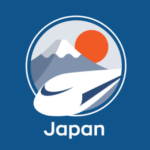
Japan Travel by NAVITIME is developed by a leading Japanese navigation company specifically for tourists navigating Japan’s complex transit systems. The app goes beyond basic routing with features like accessible route options showing elevator locations and platform information. It provides detailed station facility maps showing restrooms, coin lockers, and shops within Japan’s often massive train stations.
The app offers transit-optimized walking directions calibrated for complex urban environments like Shinjuku or Shibuya. It features train delay notifications with alternative routing suggestions and accurate travel times between attractions accounting for walking speeds and transit connections. NAVITIME also provides suggested itineraries based on seasonal highlights and crowd predictions for major tourist destinations.
Download From: Play Store or App Store
machi-nori.jp
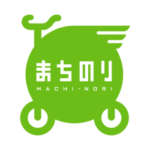
Machi-nori.jp serves as the central portal for Japan’s growing network of city bicycle-sharing services. The platform connects users to local bike-sharing systems in Tokyo, Osaka, Kyoto, and other major cities with a unified interface. Registration typically requires passport information for tourists, with verification processes explained in multiple languages.
The system uses GPS tracking to show real-time bike availability on digital maps and employs QR code technology for unlocking bikes directly through smartphones. The pricing structure usually includes a base registration fee (around 1,000-2,000 yen) plus time-based charges (typically 100-200 yen per 15 minutes). Bikes can be returned to any designated port within the city network, providing flexible one-way trip options.
Visit: Machi-Nori
Japan Transit Planner

Japan Transit Planner offers sophisticated route planning with unparalleled depth for navigating Japan’s intricate transportation networks. The tool provides nuanced fare calculations showing multiple route options with different price points and transit times. It includes detailed platform numbers and transfer time estimates accounting for the actual walking distance within stations (particularly valuable in massive transit hubs like Tokyo Station).
The planner includes pass optimization suggestions, automatically calculating when day passes or regional passes would be more economical than individual tickets. It covers both urban networks and rural transit systems with timetable accuracy reflecting seasonal schedule changes. The platform also shows alternative routing suggestions during peak commute hours when certain lines may be overcrowded.
Download From: Play Store or App Store
JR East
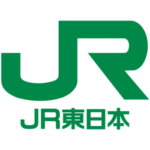
The official JR East application provides comprehensive coverage of Tokyo’s metropolitan transit network and northern Japan including Tohoku and Hokkaido regions. It offers real-time train position tracking visualized on route maps and platform-specific delay information updated by the minute. The app includes detailed platform guides showing car positions for smooth boarding, especially useful for reserved seating.
JR East provides information on station amenities including accessibility features, coin lockers, and connecting transportation. It offers seat reservation capabilities for limited express and Shinkansen services with visual seating charts. The app also features station-specific information about shopping and dining options within major transit hubs and department stores operated by JR East.
Visit: JR East
JR Central

JR Central’s dedicated application focuses on the Tokaido Shinkansen corridor connecting Tokyo, Nagoya, and Osaka—Japan’s busiest transportation artery. The app provides minute-by-minute bullet train schedules with real-time delay information and platform assignments. It features detailed seat availability information color-coded by train departure, allowing users to quickly find trains with open seats.
The service includes reservation capabilities supporting credit card payment and features station maps highlighting access points and facilities. It provides specialized information about Shinkansen services including on-board amenities, food options, and Wi-Fi availability by train type. The app offers comprehensive English-language support optimized for international travelers along this popular tourist corridor.
Visit: JR Central
JR West
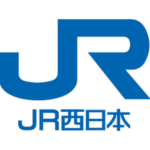
The official JR West application covers western Japan including Osaka, Kyoto, Hiroshima, and extends to rural areas like San’in and Shikoku regions. It provides detailed schedule information with visualized train locations and transfer guidance specific to station layouts. The app includes comprehensive delay notifications with impact assessments and alternative route suggestions.
JR West features detailed information about regional pass options including coverage areas and usage restrictions. It offers tourist attraction recommendations categorized by accessibility from railway stations and provides seasonal event information along railway routes. The application includes specialized information for limited express services including seat maps and reservation capabilities.
Visit: JR West
JR-Odekake
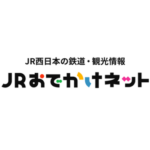
JR-Odekake serves as a comprehensive platform integrating multiple regional JR companies’ services nationwide. It offers countrywide train scheduling with precise transfer timing information and fare calculations across different JR regional companies. The app provides detailed information about discounted ticket options and regional passes with eligibility requirements.
A unique feature includes specialized searching for restaurants, shops, and services within major train stations and connected department stores. The platform includes loyalty program integration allowing users to collect and redeem JR points. It provides information about special seasonal trains, tourist-oriented services, and railway-themed attractions throughout Japan.
Visit: JR-Odekake
HIS-J

HIS-J is the digital platform of H.I.S., one of Japan’s largest travel agencies, specializing in domestic travel arrangements. The service offers expertly curated tour packages focusing on regional specialties and seasonal experiences across Japan. It provides ryokan (traditional inn) bookings with detailed information about meal plans, onsen facilities, and room types.
The platform features cultural experience reservations including tea ceremonies, kimono rentals, and traditional craft workshops. HIS-J offers exclusive deals and packages designed specifically for exploring different Japanese regions with local guide services. The app includes transportation and accommodation combinations optimized for regional exploration with insider access to less-known attractions.
Visit: HIS-J
Cab Booking
GO Taxi

GO Taxi is a ride-hailing service specifically optimized for foreign visitors to Japan, addressing common challenges with traditional Japanese taxi services. The app features preset destination options for popular tourist locations and transportation hubs with accurate Japanese addressing. It provides upfront fare estimation with transparent pricing and no hidden charges.
GO Taxi includes GPS tracking allowing users to monitor their route and provides automated communication with drivers, eliminating language barriers through in-app translation. The service supports multiple payment methods including international credit cards, PayPal, and digital wallets. It offers scheduling capabilities for advance bookings and provides digital receipts useful for business travelers.
Download From: Play Store or App Store
Kiwitaxi

Kiwitaxi offers pre-arranged fixed-price transfers between airports, stations, and accommodations throughout Japan. The service features English-speaking drivers specifically trained to assist international travelers and provides online booking with instant confirmation. Pricing is transparent with no meters or surcharges, and the service includes 60 minutes of free waiting time for airport pickups.
Kiwitaxi offers vehicle options ranging from economic sedans to luxury vehicles and vans for group travel. The service provides meet-and-greet service with name signs at arrival areas and includes 24/7 customer support in multiple languages. Drivers are knowledgeable about local areas and can provide basic travel information during transfers.
Download From: App Store or visit: Kiwitaxi
Welcome Pickups

Welcome Pickups provides personalized airport transfer services with English-speaking local drivers who double as informal guides. The service features fixed pricing with no hidden costs and includes flight tracking to adjust pickup times based on actual arrival. Drivers greet passengers with personalized welcome signs and assist with luggage handling.
Welcome Pickups drivers offer local recommendations and basic orientation information during transfers. The service includes bottled water and optional child seats upon request. It provides 24-hour support via multiple channels and offers customization options for special requests. The platform maintains strict quality standards with driver ratings and feedback systems.
Download From: Play Store or App Store or visit: Welcome Pickups
Restaurant Details
Ramen Beast
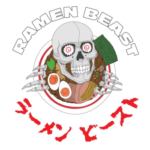
Ramen Beast is a specialized guide focused exclusively on Japan’s vast ramen scene with expert reviews of over 2,000 carefully selected establishments. The app provides detailed information on ramen styles including tonkotsu, shoyu, miso, and tsukemen with regional variations explained. It features specialized terminology with definitions and pronunciation guides for ordering.
The platform includes photos of both exterior and menu items to aid in identification and provides waiting time estimates based on time of day and day of week. Ramen Beast offers neighborhood guides focused on authentic, locally-approved ramen shops rather than tourist destinations and includes information about ticket machine ordering systems common in ramen shops.
Download From: App Store
Tabelog

Tabelog is Japan’s premier restaurant review platform used primarily by locals, containing millions of listings with authentic Japanese perspectives. The service features a sophisticated scoring system (on a scale of 1-5) where rankings above 3.5 are considered excellent. It offers detailed reviews covering food quality, service, atmosphere, and value with specialized categories for different Japanese cuisine types.
The platform provides reservation capabilities for participating restaurants and includes price ranges with meal set information. Tabelog offers menu translations and photos helping international visitors navigate unfamiliar dishes. It includes filtering options for dietary requirements and specialized categories like halal-friendly and vegetarian-possible establishments.
Visit: Tabelog
Gourmet Navigator

Gourmet Navigator provides comprehensive restaurant discovery with advanced filtering specifically for authentic Japanese cuisine types. The platform includes specialized categories for izakaya (Japanese pubs), kaiseki (traditional multi-course), kappo (counter-style fine dining), and regional specialties. It features wait time information based on crowd-sourced data and offers reservation assistance services.
Gourmet Navigator provides detailed explanations of traditional cooking methods and ingredients with seasonal specialties highlighted. The service includes information about dress codes and dining etiquette for upscale establishments. It offers curated lists focusing on specific dishes or themes like “best unagi restaurants” or “hidden tempura specialists.”
Download From: Play Store or App Store
HappyCow

HappyCow specializes in vegetarian and vegan restaurant finding with comprehensive coverage of Japan’s growing plant-based dining scene. The platform lists restaurants, cafes, health food stores, and farmers markets with vegetarian options clearly categorized as vegan, vegetarian, or veg-friendly. It provides detailed reviews focusing on ingredient authenticity and cross-contamination concerns.
HappyCow includes photos of menu items and interiors helping users gauge options before visiting. The service offers Japanese translation assistance for communicating dietary restrictions and features specialized filtering for macrobiotic, raw food, and traditional Buddhist vegetarian cuisine (shojin ryori). The platform is regularly updated with new openings in Japan’s rapidly evolving vegetarian scene.
Download From: Play Store or App Store or visit: HappyCow
Activities
Tripadvisor

Tripadvisor is a travel guidance platform featuring user-generated reviews and photos of accommodations, restaurants, attractions, and experiences worldwide. The site helps travelers plan trips by providing authentic reviews, price comparisons, and booking options. Tripadvisor’s massive collection of user reviews (over 900 million) makes it a go-to resource for researching destinations and businesses. Beyond reviews, the platform offers forums where travelers can ask questions and get advice from other community members. While originally focused on reviews, Tripadvisor has expanded to include price comparison and direct booking capabilities for hotels, experiences, and restaurants.
Download From: Play Store or App Store or visit: Tripadvisor
Tiqets

Tiqets is a mobile ticketing platform specializing in cultural attractions across Japan with instant digital ticket delivery. The service offers skip-the-line entry to popular museums, theme parks, and landmarks with immediate confirmation. It provides mobile vouchers eliminating the need for printing or ticket collection.
Tiqets includes detailed attraction information with opening hours, accessibility details, and location guidance. The platform offers combination tickets providing discounted access to multiple attractions within regions. It includes last-minute availability for spontaneous planning and features Japanese cultural experience bookings like tea ceremonies and traditional performances.
Download From: Play Store or App Store or visit: Tiqets
GetYourGuide

GetYourGuide is a comprehensive booking platform for travel experiences with extensive coverage throughout Japan, from major tourist destinations to off-the-beaten-path locations. The service excels in curating high-quality guided tours, cultural experiences, and attraction tickets with a rigorous vetting process for local operators. Their platform offers detailed activity descriptions including duration, inclusions, meeting points, and accessibility information to help travelers make informed decisions.
What sets GetYourGuide apart is their mobile-friendly booking system with instant digital vouchers that eliminate the need for printing physical tickets. They provide last-minute booking options, often available up to 24 hours before activities, which is particularly valuable for travelers with flexible itineraries.
Download From: Play Store or App Store or visit: GetYourGuide
Klook

Klook functions as a comprehensive activity booking platform with extensive coverage of Japanese experiences from major attractions to niche cultural activities. The service offers discounted rates secured through volume partnerships with Japanese service providers and features instant confirmation with digital vouchers. The platform includes JR Pass delivery services and specialized transportation tickets like airport limousine bus reservations.
Klook provides detailed activity descriptions with duration estimates, inclusion details, and meeting point information. It features verified user reviews with photos providing social proof and insider tips. The platform supports multiple currencies with transparent pricing and offers 24/7 customer support through multiple channels including live chat.
Download From: Play Store or App Store or visit: Klook
WEGoTrip

WEGoTrip specializes in self-guided audio tours providing immersive exploration experiences across Japanese cities. The platform offers neighborhood-specific walking tours narrated by local experts with cultural and historical context. It provides offline maps with GPS functionality enabling exploration without data connectivity.
WEGoTrip includes insider tips about hidden gems, local eateries, and photo opportunities not found in typical guidebooks. The tours feature flexible exploration allowing users to proceed at their own pace, pause, and resume as desired. The platform offers specialized thematic tours focused on Japanese architecture, food districts, historic periods, or pop culture sites.
Download From: Play Store or App Store or visit: WeGoTrip
intui.travel

intui.travel provides personalized travel planning using AI to create custom itineraries tailored to individual preferences, budgets, and time constraints. The platform analyzes user inputs about interests, mobility level, and travel style to generate personalized recommendations. It offers local insider suggestions highlighting experiences matching specific preference profiles.
The service provides seamless booking integration for recommended activities and accommodations. It includes itinerary optimization balancing travel times between attractions for efficiency. The platform adapts recommendations based on seasonal factors like cherry blossom timing or festival calendars. It offers collaborative planning features for group travel and provides exportable itineraries with mapping integration.
visit: Intui.travel
Tabiko

Tabiko is a specialized travel planning platform designed specifically for exploring Japan, differentiating itself through its focus on authentic, personalized experiences outside typical tourist routes. The service combines AI-powered recommendations with expert local knowledge to create custom itineraries tailored to individual travel preferences, interests, and pace.
What makes Tabiko particularly valuable is its deep integration with Japan’s complex transportation systems. The platform provides optimized routing between destinations using a combination of trains, buses, and alternative transportation options with real-time schedule updates. It features specialized knowledge of regional passes and discount tickets, automatically suggesting the most cost-effective transportation options based on your planned route and travel style.
Download From: Play Store or App Store
Emergency
Yurekuru Call

Yurekuru Call is a specialized early earthquake warning application receiving data directly from Japan’s Meteorological Agency’s emergency broadcast system. The app provides notifications seconds before tremors reach your location, typically giving 5-30 seconds advance warning depending on distance from epicenter. It indicates estimated intensity using Japan’s shindo scale and projected arrival time.
The service includes evacuation information with directions to nearest designated shelters and provides historical seismic data for contextualizing events. The app offers multilingual alert options with customizable notification sounds and vibration patterns. It provides aftershock predictions with probability assessments following major earthquakes.
Download from: Play store or App Store
NERV

NERV is a comprehensive disaster prevention application named after the organization in the anime “Evangelion” providing real-time alerts for multiple hazard types. The app covers earthquakes, tsunamis, volcanic activity, typhoons, floods, and landslides with geographically targeted notifications. It provides evacuation center locations with capacity information and current status updates.
NERV includes disaster preparedness checklists customized for Japan’s specific hazards and features emergency contact management with automated status sharing during disasters. The app provides infrastructure status reports on transportation, utilities, and communication networks following major events. It includes multilingual support for emergency instructions and offers offline functionality for use during communication network disruptions.
Download from: Play store or App Store
Network Providers
NTT Docomo

NTT Docomo is Japan’s largest mobile carrier, established in 1991 as a subsidiary of Nippon Telegraph and Telephone (NTT). The company pioneered mobile internet services with its i-mode platform in 1999. Docomo maintains extensive nationwide coverage with advanced 5G networks and is known for its reliable service, innovative technology, and premium pricing. The company offers a wide range of subscription plans and has expanded into digital payments through its d-CARD and d-POINTs loyalty program.
KDDI au

KDDI operates its mobile services under the “au” brand and is Japan’s second-largest telecommunications company. Formed in 2000 through the merger of KDD, DDI, and IDO, KDDI au has built a reputation for strong network coverage, particularly in rural areas. The carrier is known for competitive pricing and family-oriented plans. KDDI has diversified into financial services, e-commerce, and entertainment content, offering bundled services through its “au Economic Concept” that integrates telecommunications with other lifestyle services.
SoftBank

Originally entering the Japanese mobile market after acquiring Vodafone Japan in 2006, SoftBank has grown to become the third-largest carrier in Japan. Under the leadership of founder Masayoshi Son, SoftBank transformed from a telecommunications company into a global technology investment conglomerate. The carrier is known for aggressive marketing campaigns, competitive pricing strategies, and being the first to bring the iPhone to Japan. SoftBank’s network has improved significantly in recent years, and the company continues to expand its services beyond telecommunications into AI, IoT, and various tech ventures.
Rakuten Mobile
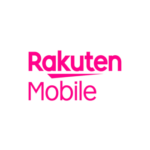
Rakuten Mobile is Japan’s newest major carrier, launching full-scale commercial services in 2020. As a subsidiary of e-commerce giant Rakuten Group, it disrupted the market with its fully virtualized, cloud-native network architecture—the world’s first at scale. Rakuten Mobile offers simplified, affordable pricing plans and integrates with Rakuten’s extensive ecosystem of services, including e-commerce, financial services, and content. As the fourth major carrier, Rakuten Mobile has pressured competitors with its low-cost, unlimited data plans, though its network coverage has been expanding gradually from urban centers outward.
YeSim

YeSIM is a digital eSIM provider specializing in travel connectivity solutions for Japan with instant activation capabilities. The service eliminates the need for physical SIM cards or airport pickup, providing immediate connectivity upon arrival. It offers flexible short-term plans specifically designed for visitors with options ranging from 3 days to 30 days.
YeSIM provides data packages optimized for different usage patterns from basic navigation to heavy streaming. The service includes multilingual support specifically addressing connectivity issues in Japan and offers seamless switching between multiple countries for travelers visiting several Asian destinations. The platform provides detailed coverage maps for both urban and rural areas of Japan.
Download From: Play Store or App Store or visit: yeSim
Miscellaneous
Google Maps

Google Maps offers comprehensive coverage of Japan with several specialized features particularly valuable for navigating Japanese cities. The app provides offline map downloads covering specific regions for use without data connectivity and includes precise walking directions to train platforms within stations. It features 3D mapping of complex urban areas like Shinjuku or Roppongi Hills helping with multi-level navigation.
The platform offers street-view imagery covering most Japanese cities down to small alleyways and integrates seamlessly with local transit IC cards showing compatible routes. Google Maps provides real-time transit information for major Japanese cities with detailed platform guidance and offers features for finding specific building entrances in complex Japanese addressing systems.
Download From: Play Store or App Store or visit: Maps
Google Translate

Google Translate supports Japanese-English and numerous other language pairs with specialized features particularly useful for travelers in Japan. The app offers real-time camera translation allowing users to point their phone at signs, menus, or product packaging for instant translation. It provides voice translation facilitating basic conversations with Japanese speakers.
The platform includes downloadable language packs enabling offline functionality without data connectivity and features handwriting recognition allowing users to draw unfamiliar kanji for translation. Google Translate includes specialized food and menu translation optimized for Japanese culinary terminology and offers phrasebook functionality with common travel expressions.
Download From: Play Store or App Store or visit: Translate
Imiwa?

Imiwa is an advanced Japanese dictionary application containing over 170,000 entries designed for serious Japanese language learners and travelers. The app supports multiple lookup methods including JLPT levels, radicals, and handwriting recognition for identifying unfamiliar characters. It provides conjugation tables showing verb forms essential for basic communication.
The platform includes kanji stroke order animations demonstrating correct character writing and features example sentences showing contextual usage. Imiwa functions completely offline, making it ideal for travelers without constant internet access. It offers vocabulary list creation for personalized study and includes audio pronunciation by native speakers for learning correct intonation.
Download From: App Store
Ecbo Cloak

Ecbo Cloak operates as a luggage storage marketplace connecting travelers with businesses offering secure storage in convenient locations throughout Japan. The service provides location mapping showing storage options near major transit hubs and tourist attractions. It offers price comparison typically ranging from 300-800 yen per day depending on item size and location.
The platform includes capacity information showing available space in real-time and displays operating hours with last collection times. Ecbo Cloak allows reservations to be made in advance with digital payment processing and provides insurance coverage for stored items. The service covers major cities and tourist destinations throughout Japan with continually expanding network of participating businesses.
Download From: Play Store or App Store
Radical Storage

Radical Storage offers on-demand luggage storage through a network of verified partner locations across Japanese cities. The service maintains strict security standards with background checks for all storage partners and provides fixed daily rates regardless of luggage size (typically around 600 yen per bag per day).
The platform features photographic verification of luggage at drop-off and includes basic insurance coverage included in the storage fee. Radical Storage offers extended hours beyond typical hotel check-in/out times and provides digital booking confirmation eliminating language barrier issues. The service includes storage options near major transportation hubs, shopping districts, and tourist attractions throughout Japan.
Download From: Play Store or App Store or visit: Radical Storage
Compensair

Compensair specializes in flight compensation services helping travelers claim money for delayed or canceled flights under applicable regulations. The service provides eligibility assessment based on flight details and delay circumstances with clear explanation of compensation rights. It offers a simple claim process requiring minimal documentation from travelers.
Compensair operates on a no-win-no-fee basis taking a percentage only from successful claims and handles all communication with airlines in appropriate languages. The service provides case tracking through an online dashboard and offers specialized knowledge of Japan’s domestic airline compensation policies. It includes support for international flights departing from or arriving in Japan with typical compensation amounts ranging from €250-600 for qualifying delays.
visit: Compensair
AccuWeather

AccuWeather is a weather forecasting service providing detailed weather information for locations worldwide. The platform offers current conditions, hourly forecasts, and extended predictions up to 45 days. AccuWeather’s MinuteCast feature provides minute-by-minute precipitation forecasts for the next two hours. The service includes air quality information, allergy reports, radar and satellite imagery, and severe weather alerts. AccuWeather distinguishes itself through its AccuWeather Superior Accuracy™ forecasting methodology, which combines meteorological data, proprietary algorithms, and human forecaster expertise to provide highly accurate weather predictions.
Download from: Play store or App Store or visit: AccuWeather

